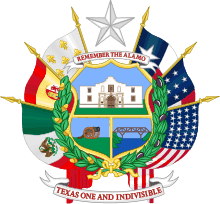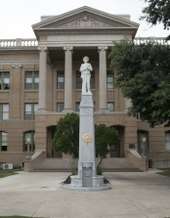List of Confederate monuments and memorials
This is a list of Confederate monuments and memorials that were established as public displays and symbols of the Confederate States of America (CSA), Confederate leaders, or Confederate soldiers of the American Civil War. Part of the commemoration of the American Civil War, these symbols include monuments and statues, flags, holidays and other observances, and the names of schools, roads, parks, bridges, counties, cities, lakes, dams, military bases, and other public works.[note 1] In a December 2018 special report, Smithsonian Magazine stated, "over the past ten years, taxpayers have directed at least $40 million to Confederate monuments—statues, homes, parks, museums, libraries and cemeteries—and to Confederate heritage organizations."[2]
This list does not include figures connected with the origins of the Civil War or white supremacy, but not with the Confederacy, including statues of Supreme Court Justice Roger B. Taney in Annapolis, Baltimore, and Frederick, Maryland; the county and city named for pro-slavery congressman Preston Brooks; a controversial portrait of North Carolina Chief Justice Thomas Ruffin;[3] and numerous memorials to Southern politician John C. Calhoun (commemorated on the Confederacy's 1¢ stamp), although monuments to Calhoun "have been the most consistent targets" of vandals.[4] It also does not include post-Civil War white supremacists, such as North Carolina Governor Charles Aycock and Mississippi Governor James K. Vardaman.
Monuments and memorials are listed below alphabetically by state, and by city within each state. States not listed have no known qualifying items for the list.[5] For monuments and memorials which have been removed, consult Removal of Confederate monuments and memorials.
History
Monument building and dedications
Memorials have been erected on public spaces (including on courthouse grounds) either at public expense or funded by private organizations and donors. Numerous private memorials have also been erected.
.png)
According to Smithsonian Magazine, "Confederate monuments aren't just heirlooms, the artifacts of a bygone era. Instead, American taxpayers are still heavily investing in these tributes today."[2] The report also concluded that the monuments were constructed and are regularly maintained in promotion of Lost Cause, white supremacist mythology, and over the many decades of their establishment, African American leaders regularly protested these memorials and what they represented.[2]
A small number of memorializations were made during the war, mainly as ship and place names. After the war, Robert E. Lee said on several occasions that he was opposed to any monuments, as they would, in his opinion, "keep open the sores of war".[7] Nevertheless, monuments and memorials continued to be dedicated shortly after the American Civil War.[8] Many more monuments were dedicated in the years after 1890, when Congress established the first National Military Park at Chickamauga and Chattanooga, and by the turn of the twentieth century, five battlefields from the Civil War had been preserved: Chickamauga-Chattanooga, Antietam, Gettysburg, Shiloh, and Vicksburg. At Vicksburg National Military Park, more than 95 percent of the park's monuments were erected in the first eighteen years after the park was established in 1899.[9]
Jim Crow
Confederate monument-building has often been part of widespread campaigns to promote and justify Jim Crow laws in the South. [10][1][11] According to the American Historical Association (AHA), the erection of Confederate monuments during the early twentieth century was "part and parcel of the initiation of legally mandated segregation and widespread disenfranchisement across the South." According to the AHA, memorials to the Confederacy erected during this period "were intended, in part, to obscure the terrorism required to overthrow Reconstruction, and to intimidate African Americans politically and isolate them from the mainstream of public life." A later wave of monument building coincided with the civil rights movement, and according to the AHA "these symbols of white supremacy are still being invoked for similar purposes."[12] According to Smithsonian Magazine, "far from simply being markers of historic events and people, as proponents argue, these memorials were created and funded by Jim Crow governments to pay homage to a slave-owning society and to serve as blunt assertions of dominance over African-Americans." [2]
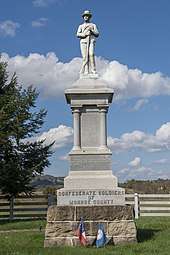
According to historian Jane Dailey from the University of Chicago, in many cases, the purpose of the monuments was not to celebrate the past but rather to promote a "white supremacist future".[13] Another historian, Karen L. Cox, from the University of North Carolina at Charlotte, has written that the monuments are "a legacy of the brutally racist Jim Crow era", and that "the whole point of Confederate monuments is to celebrate white supremacy".[11] Another historian from UNC, James Leloudis, stated that "The funders and backers of these monuments are very explicit that they are requiring a political education and a legitimacy for the Jim Crow era and the right of white men to rule."[14] They were erected without the consent or even input of Southern African Americans, who remembered the Civil War far differently, and who had no interest in honoring those who fought to keep them enslaved.[15] According to Civil War historian Judith Giesberg, professor of history at Villanova University, "White supremacy is really what these participation trophy represent."[16] Some monuments were also meant to beautify cities as part of the City Beautiful movement, although this was secondary.[17]
In a June 2018 speech, Civil War historian James I. Robertson Jr. of Virginia Tech University said the monuments were not a "Jim Crow signal of defiance" and referred to the current trend to dismantle or destroy them as an "age of idiocy" motivated by "elements hell-bent on tearing apart unity that generations of Americans have painfully constructed."[18] Katrina Dunn Johnson, Curator of the South Carolina Confederate Relic Room and Military Museum, states that "thousands of families throughout the country were unable to reclaim their soldier's remains--many never learned their loved ones' exact fate on the battlefield or within the prison camps. The psychological impact of such a devastating loss cannot be underestimated when attempting to understand the primary motivations behind Southern memorialization."[19]
Many Confederate monuments were dedicated in the former Confederate states and border states in the decades following the Civil War, in many instances by Ladies Memorial Associations, United Daughters of the Confederacy (UDC), United Confederate Veterans (UCV), Sons of Confederate Veterans (SCV), the Heritage Preservation Association, and other memorial organizations.[20][21][22] Other Confederate monuments are located on Civil War battlefields. Many Confederate monuments are listed on the National Register of Historic Places, either separately or as contributing objects within listings of courthouses or historic districts. Art historians Cynthia Mills and Pamela Simpson argued, in Monuments to the Lost Cause, that the majority of Confederate monuments, of the type they define, were "commissioned by white women, in hope of preserving a positive vision of antebellum life."[23][24]
In the late nineteenth century, technological innovations in the granite and bronze industries helped reduce costs and made monuments more affordable for small towns. Companies looking to capitalize on this opportunity often sold nearly identical copies of monuments to both the North and South.[25]
Another wave of monument construction coincided with the Civil Rights Movement and the American Civil War Centennial.[1]:11 At least thirty-two Confederate monuments were dedicated between 2000 and 2017, including at least 7 re-dedications.[26][27][28][29]
Scholarly study
Scholarly studies of the monuments began in the 1980s. In 1983 John J. Winberry published a study which was based on data from the work of R.W. Widener.[30][31] He estimated that the main building period for monuments was from 1889 to 1929 and that of the monuments erected in courthouse squares over half were built between 1902 and 1912. He determined four main locations for monuments; battlefields, cemeteries, county courthouse grounds, and state capitol grounds. Over a third of the courthouse monuments were dedicated to the dead. The majority of the cemetery monuments in his study were built in the pre-1900 period, while most of the courthouse monuments were erected after 1900. Of the 666 monuments in his study 55% were of Confederate soldiers, while 28% were obelisks. Soldiers dominated courthouse grounds, while obelisks account for nearly half of cemetery monuments. The idea that the soldier statues always faced north was found to be untrue and that the soldiers usually faced the same direction as the courthouse. He noted that the monuments were "remarkably diverse" with "only a few instances of repetition of inscriptions".[31]
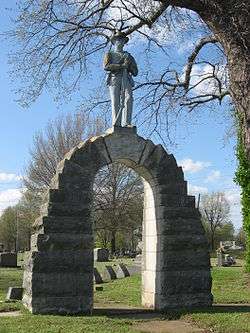
He categorized the monuments into four types. Type 1 was a Confederate soldier on a column with his weapon at parade rest, or weaponless and gazing into the distance. These accounted for approximately half the monuments studied. They are, however, the most popular among the courthouse monuments. Type 2 was a Confederate soldier on a column with rifle ready, or carrying a flag or bugle. Type 3 was an obelisk, often covered with drapery and bearing cannonballs or an urn. This type was 28% of the monuments studied, but 48% of the monuments in cemeteries and 18% of courthouse monuments. Type 4 was a miscellaneous group, including arches, standing stones, plaques, fountains, etc. These account for 17% of the monuments studied.[31]
Over a third of the courthouse monuments were specifically dedicated to the Confederate dead. The first courthouse monument was erected in Bolivar, Tennessee, in 1867. By 1880 nine courthouse monuments had been erected. Winberry noted two centers of courthouse monuments: the Potomac counties of Virginia, from which the tradition spread to North Carolina, and a larger area covering Georgia, South Carolina and northern Florida. The diffusion of courthouse monuments was aided by organizations such as the United Confederate Veterans and their publications, though other factors may also have been effective.[31]
Winberry listed four reasons for the shift from cemeteries to courthouses. First was the need to preserve the memory of the Confederate dead and also recognize the veterans who returned. Second was to celebrate the rebuilding of the South after the war. Third was the romanticizing of the Lost Cause, and the fourth was to unify the white population in a common heritage against the interests of African-American Southerners. He concluded: "No one of these four possible explanations for the Confederate monument is adequate or complete in itself. The monument is a symbol, but whether it was a memory of the past, a celebration of the present, or a portent of the future remains a difficult question to answer; monuments and symbols can be complicated and sometimes indecipherable."[31]
Vandalism
As of June 19, over 12 Confederate monuments had been vandalized in 2019, usually with paint.[32][33]
Removal
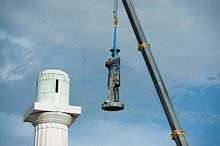
As of April 2017, at least 60 symbols of the Confederacy had been removed or renamed since 2015, according to the Southern Poverty Law Center (SPLC).[34] At the same time, laws in various Southern states place restrictions on, or prohibit altogether, the removal of statues and memorials and the renaming of parks, roads, and schools.[35][36][37][38][39][38]
A 2017 Reuters poll found that 54% of adults stated that the monuments should remain in all public spaces, and 27% said they should be removed, while 19% said they were unsure. The results were split along racial and political lines, with Republicans and whites preferring to keep the monuments in place, while Democrats and minorities were more likely to support their removal.[40][41] A similar 2017 poll by HuffPost/YouGov found that one-third of respondents favored removal, while 49% were opposed.[42][43]
Geographic distribution
Confederate monuments are widely distributed across the southern United States.[31] The distribution pattern follows the general political boundaries of the Confederacy.[31] Of the more than 1503 public monuments and memorials to the Confederacy, more than 718 are monuments and statues. Nearly 300 monuments and statues are in Georgia, Virginia, or North Carolina. According to one researcher, "the absence of monuments in eastern Tennessee and western North Carolina indicates those regions' Union sentiment, and the few monuments in Maryland, West Virginia, and Kentucky reflect those states' ambivalent war-time politics." The Northern States that remained part of the Union, as well as the Western States that were largely settled after the Civil War, have few or no memorials to the Confederacy.
National
United States Capitol
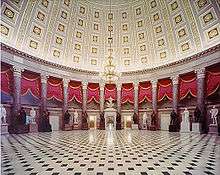
- In the National Statuary Hall Collection, in the United States Capitol, each state has provided statues of two citizens that the state wants to honor. The following Confederate figures are among them, many in Confederate Army uniforms.[44] Dates reflect when the statue was given to the collection:[45][46]
- Robert E. Lee (Virginia, 1909)[47]
- Zebulon Baird Vance (North Carolina, 1916)[48]
- Uriah M. Rose (Arkansas, 1917)[49]
- Edmund Kirby Smith (Florida, 1922). On March 19, 2018, the Governor of Florida signed legislation replacing Smith with African-American educator and civil rights advocate Mary McLeod Bethune.[50] As of June 2020 the Smith statue remains, pending completion of the Bethune statue.
- Joseph Wheeler (Alabama, 1925)[51]
- Alexander Hamilton Stephens (Georgia, 1927)[52]
- Wade Hampton III (South Carolina, 1929)[53]
- Jefferson Davis (Mississippi, 1931)[54]
- James Zachariah George (Mississippi, 1931)[55]
- Statue of Jabez Lamar Monroe Curry (Alabama, 1908) was replaced by a statue of Helen Keller in 2009[56]
- Peace Monument, also known as the Naval Monument or Civil War Sailors Monument, stands on the grounds of the United States Capitol in Peace Circle at First Street, N.W., and Pennsylvania Avenue. Erected in 1877–1878 to commemorate the naval deaths at sea during the Civil War.
Arlington National Cemetery

- The antebellum home of Robert E. Lee during the Civil War, Arlington House, in Arlington County, Virginia, overlooks Arlington National Cemetery. A National Park Service (NPS) memorial, the estate became the site of Arlington National Cemetery in part to ensure that Lee could never return to his home.[57]
- The NPS describes the property as "the nation's memorial to Robert E. Lee. It honors him for specific reasons, including his role in promoting peace and reunion after the Civil War. In a larger sense it exists as a place of study and contemplation of the meaning of some of the most difficult aspects of American History: military service; sacrifice; citizenship; duty; loyalty; slavery and freedom."[58]
- The Confederate Memorial at Arlington National Cemetery was a project of the United Daughters of the Confederacy. authorized in 1906 by the United States Secretary of War William Howard Taft, and unveiled by President Wilson in 1914.[59]
Coins and stamps
- Robert E. Lee and Stonewall Jackson were portrayed by the US Mint on the 1925 Commemorative silver US half dollar, along with the words "Stone Mountain". The coin was a fundraiser for the Stone Mountain monument, which honors the Confederate Generals. The authorized issue was 5 million coins, to be sold at $1 each, but that proved overly optimistic and only 1.3 million coins were released, many of which ended up in circulation after being spent for face value.[60] The caption on the reverse reads "Memorial to the valor of the soldier of the South".
- Robert E. Lee has been commemorated on at least five US postage stamps. One 1936–37 stamp featured Generals Lee and Stonewall Jackson with Lee's home Stratford Hall.[61][62]
US military
Bases
There are 10 major U.S. military bases named in honor of Confederate military leaders, all in former Confederate States.[1] In 2015 the Pentagon declared it would not be renaming these facilities,[63] and declined to make further comment in 2017.[64]
- Fort Lee, Virginia (1917) named for CSA Gen. Robert E. Lee
- Camp Beauregard, Louisiana (1917) named for CSA Gen. Pierre Gustave Toutant Beauregard.[65]
- Fort Benning, Alabama/Georgia border (1917) named for CSA Brig. Gen. Henry L. Benning
- Fort Gordon, Georgia (1917) named for CSA Maj. Gen. John Brown Gordon
- Fort Bragg, North Carolina (1918) named for CSA Gen. Braxton Bragg. The largest military installation in the world by population.[66]
- Fort Polk, Louisiana (1941) named for CSA Gen. Leonidas Polk
- Fort A.P. Hill, Virginia (1941) named for CSA Lt. Gen. A. P. Hill
- Fort Pickett, Virginia (1942) named for CSA Gen. George Pickett
- Fort Rucker, Alabama (1942) named for CSA Gen. Edmund Rucker[63]
- Fort Hood, Texas (1942) named for CSA Gen. John Bell Hood.[67]
- Camp Breckinridge, near Morganfield, Kentucky (closed) named for John C. Breckinridge, U.S. Vice President and Confederate general. Prisoner of war camp during World War II; used for Army basic training during the Korean War. Currently houses the Earle C. Clements Job Corps Center.
Facilities
- Lee Barracks, named for CSA Gen. Robert E. Lee (1962), at U.S. Military Academy at West Point, New York.[68]
- Lee Barracks (de) (Mainz, Germany), closed in 1992
- U.S. Naval Academy in Annapolis, Maryland:
- Buchanan House, the Naval Academy superintendent's home, named for CSA naval officer Franklin Buchanan.[69] A road near the house is also memorialized in Buchanan's name.
- Maury Hall, home to the academy's division of Weapons and Systems Engineering, named for US naval officer in charge of the Depot of Charts and Instruments at Washington and later CSA naval officer Matthew Fontaine Maury.[69][70]
Current ships
- USNS Maury (T-AGS-66) (2013)
Former ships
- USS Atchison County (LST-60), named for Brigadier General David Rice Atchison
- USS Buchanan: Three U.S. Navy destroyers have been named in honor of the highest ranked Confederate Admiral Franklin Buchanan
- USS Buchanan (DD-131) 1919–1940 then transferred to UK Navy
- USS Buchanan (DD-484) 1941–1949 then transferred to Turkey's Navy
- USS Buchanan (DDG-14) 1960–1991 then sank as target in 2000
- USS Maury – 5 former ships have carried the Maury name dating from WWI and WWII.
- USS Robert E Lee (SSBN-601) (ballistic missile submarine) in honor of Gen. Robert E. Lee.
- USS Semmes – two destroyers have been named for Raphael Semmes.
- USS Semmes (DD-189) 1920–1946
- USS Semmes (DDG-18) 1962–1991
- USS Stonewall Jackson (SSBN-634) 1964–1995.
- USS Tom Green County (LST-1159) 1953–1972 then transferred to Spain. The namesake Texas County was named for CSA Brig Gen Thomas Green
- USS Zebulon B. Vance, a World War II liberty ship, named for CSA Colonel and North Carolina Confederate governor Zebulon Baird Vance.
- Liberty Ship #113, named for Joseph E. Johnston by the US Navy.[71]
- Liberty ship #5, named for Alexander H. Stephens
- Liberty ship #8, named for Jefferson Davis
Several ships named for Confederate leaders fell into Union hands during the Civil War. The Union Navy retained the names of these ships while turning their guns against the Confederacy:
- Beauregard a privateer with letters of marque issued by the Confederacy, named in honor of Gen. P. G. T. Beauregard. Captured as a prize and purchased on Feb. 24, 1862 by the Union Navy which operated it as the USS Beauregard.
- USS General Price (1862) a Confederate ship sunk in battle, raised and used by the Union until sold in 1865.
Multi-state highways
- Jefferson Davis Highway, Arlington, Virginia to San Diego, California. The highway labeling (no road construction was involved) was a project of the United Daughters of the Confederacy. Never completed as originally planned, and its route is not completely clear. Markers that remain are listed under the states.
- On October 16, 2018, the Board of Commissioners of Orange County, North Carolina (location of the University of North Carolina at Chapel Hill, see Silent Sam), voted unanimously to repeal the county's 1959 resolution naming for Davis the portion of U.S. 15 running through the county.[72]
- Lee Highway, New York City to San Francisco. Markers that remain are listed under the states.
Alabama
As of 24 June 2020, there are at least 122 public spaces with Confederate monuments in Alabama.[73]
Alaska
- Yukon–Koyukuk Census Area: "Confederate Gulch"[74] and "Union Gulch" both drain the side of a mineralized mountain mass northeast of Wiseman. Gold was discovered in both gulches in the early 20th century, though only Union Gulch was mined.[75]
Arizona
As of 24 June 2020, there are at least 5 public spaces with Confederate monuments in Arizona.[73]
| Type of monument | Date | Location | Details | Image |
|---|---|---|---|---|
| Public | 1961 | Phoenix | Memorial to Arizona Confederate Troops, in Wesley Bolin Park, next to the Arizona State Capitol; UDC memorial.[76] |  |
| Public | 1931 | Phoenix | Water fountain at Maricopa County Courthouse dedicated to Confederate Army lieutenant Jack Swilling[77][78] | |
| Public | Picacho Peak State Park | A commemorative sign and a plaque commemorates the Battle of Picacho Pass, the westernmost Confederate engagement of the war. The sign is "dedicated to Capt. Sherod Hunter's 'Arizona Rangers, Arizona Volunteers' C.S.A.", while the plaque states three Union soldiers buried on battlefield and includes both US Union and CSA flags. In recent years the sign was removed due to deterioration of the wood and the plaque was moved onto the Union stone monument. [76][79][80] | 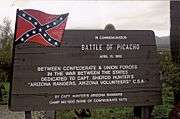 | |
| Public | 2010 | Sierra Vista | Confederate Memorial, Historical Soldiers Memorial Cemetery area of the state-owned Southern Arizona Veterans' Cemetery. The monument was erected in to honor the 21 soldiers interred in that cemetery who served in the Confederate Army during the Civil War and later fought in Indian wars in Arizona as members of the U.S. Army.[76][81] | |
| Private | 1999 | Phoenix | Arizona Confederate Veterans Monument, at Greenwood Memory Lawn Cemetery; erected by SCV.[76] | 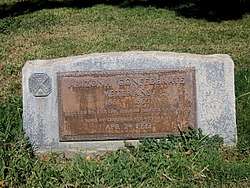 |
| Road | 1943 | Jefferson Davis Memorial Highway marker 50 mi (80 km) east of Phoenix; erected by UDC. Tarred and feathered in August 2017.[76][82] |
Arkansas
As of 24 June 2020, there are at least 65 public spaces with Confederate monuments in Arkansas.[73]
State capitol
- Confederate Soldiers Monument, also known as Defense of the Flag, Arkansas State Capitol grounds, (1905).[83]
- Confederate War Prisoners Memorial, Arkansas State Capitol grounds.[83]
- Monument to Confederate Women (or "Mother of the South"), Arkansas State Capitol grounds, Little Rock, Arkansas. Statue depicts a mother and daughter saying good-bye to their 16-year-old son and brother who is leaving to join his father in the fighting. (1913)[84][85]
- Old State House, several on the grounds:[86]
- David O. Dodd Memorial (1923)
- Defenders Memorial Plaque (1932)[87]
- Gen. Thomas J. Churchill Memorial (1928)
- Gen. William Read Scurry Memorial (1928)
- Old State House Confederate Memorial[88]
Monuments

Courthouse monuments
- Arkadelphia: Arkadelphia Confederate Monument (1911)
- Blytheville: Confederate War Memorial (1934)
- Camden: Camden Confederate Monument (1915)
- Conway: Conway Confederate Monument (1925)
- El Dorado: El Dorado Confederate Monument (1909)
- Fort Smith: Ft. Smith Confederate Monument (1903)
- Lake Village: Lake Village Confederate Monument (1910)
- Lonoke: Lonoke Confederate Monument (1910)
- Marion, Crittenden County: Civil War Memorial (1936)
- Osceola: Searcy Confederate Monument (1917)[84]
- Van Buren: Van Buren Confederate Monument (1899)
Other public monuments

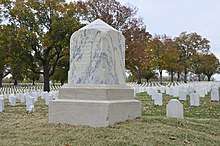
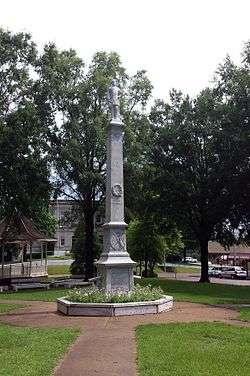
- Batesville: Batesville Confederate Monument (1907)
- Benton: Confederate Veterans' Memorial
- Bentonville: Bentonville Confederate Monument (1908); UDC monument[89]
- Camden: Granite obelisk topped by a cannonball, in fenced-off Confederate section of Oakland Cemetery
- Clarendon: Confederate Memorial
- Clarksville: Clarksville Confederate Monument, (1902) The Oakland Cemetery obelisk inscribed, "Sacred to the memory of our Confederate dead," was added to the National Register of Historic Places in 1999.[90]
- Dardanelle: Dardanelle Confederate Monument (1921)
- Fayetteville: Confederate statue (1897), Fayetteville Confederate Cemetery[91]
- Fort Smith: Jefferson Davis Memorial (1937)
- Grant County: UDC monument (1928) at Jenkins' Ferry Battleground State Park to Confederate soldiers who died at the Battle of Jenkins' Ferry[92]
- Harrison: Boone County Confederate Veterans Memorial, on the grounds of the Boone County Courthouse (1986)
- Hot Springs:
- Confederate State Capital, Bathhouse Row
- Hot Springs Confederate Monument (1934)
- Jacksonport: Jackson County Confederate Memorial (1914)
- Little Rock:
- Children of the Confederacy
- Confederate Bench (1936)
- Confederate Last Stand Monument
- CSS Pontchartrain
- Little Rock National Cemetery:
- Confederate Soldiers Monument (1884); marks the mass burial of 640 Confederate soldiers[93]
- Little Rock Confederate Memorial (1913)[94]
- Memorial to Company A Confederate Soldiers (1911)
- Monument to Confederate Soldiers (1905)
- Southern Soldiers Memorial
- Magnolia: Gen. John Porter McCown Monument
- Marianna: Gen. Robert E. Lee Monument, 1910.
- Marmaduke: John Sappington Marmaduke Memorial
- Monticello: Monticello Confederate Monument
- New Edinburg: Captain Richard Tunball Banks Monument, 1864.
- Newport: Jackson Guards Memorial, built in 1914. Monument consists of a statue of a single Confederate soldier and a roster of the men who served in the Jackson Guards and the slaves who supported them. The only Confederate monument in Arkansas built entirely with funds raised by private subscription, although it was built on a prominent piece of land donated by the city of Hot Springs.[84]
- Pea Ridge:
- Pine Bluff:
- David O. Dodd Memorial
- Pine Bluff Confederate Monument (1910)
- Prescott: Confederate War Memorial (1964)
- Smithville: Confederate War Memorial (1996)[98]
- Star City: Star City Confederate Memorial (1926) Erected on the courthouse grounds, moved in 1943 and moved again to its original position, now the town square, in the 1990s. Consists of a statue of a Confederate soldier.[84]
- Van Buren:
- Confederate Memorial (1906) Originally at Fairview Cemetery.
- Fairview Cemetery Confederate Memorial; replacement when original was moved to downtown.[99]
- Washington:
- Confederate Masonic Memorial
- Washington Confederate Monument (1888), Washington Presbyterian Cemetery. Listed on the National Register of Historic Places in 1996.[100][101]
Inhabited places
- Cleburne County (1883), named for CSA Maj. Gen. Patrick Cleburne.[102]
- Faulkner County (1873), named for CSA Col. Sanford Faulkner.[103]
- City of Forrest City (1870), named for CSA Gen. Nathan Bedford Forrest.[104]
- Lee County (1873), named for CSA Gen. Robert E. Lee.[105]
Parks
- Russellville: Confederate Mothers Memorial Park (1921). Land for the public park was donated by UDC and includes three stone monuments, each one placed by a different Confederate veterans or memorial organization, honoring the mothers of the Confederacy.[106]
Roads
- El Dorado: Robert E. Lee Street
- Forrest City: Confederate Drive
- Heber Springs: Jefferson Davis Road
- Hughes: Jeff Davis Street
- Jacksonville: Jeff Davis Avenue
- Lake Village: Confederate Street
- Little Rock:
- Beauregard Drive
- Claiborne Drive
- Longstreet Drive
- Pickett Drive
- Malvern: Robert E. Lee Street
- Wilson: Jeb Stuart Drive
Schools
- Forrest City:
- Forrest City High School (1914)
- Forrest City Junior High School
- Little Rock: Robert E. Lee School
- Pine Bluff: Forrest Park Prep Preschool
- Springdale: Robert E. Lee Elementary School (1951)
State symbols
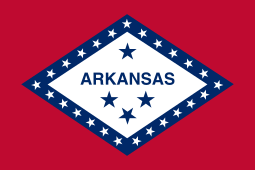
- Flag of Arkansas The blue star above "ARKANSAS" represents the Confederate States of America and is placed above the three other stars for the countries (Spain, France and the US) to which the State belonged before statehood. The diamond represents the nations only diamond mine with bordering 25 stars symbolizing 25th state to join.[107] The design of the border around the white diamond evokes the saltire found on the Confederate battle flag.[108]
California
As of 24 June 2020, there are at least five public spaces with Confederate monuments in California.[73]
Monuments
- San Diego: Confederate Soldiers Memorial (1948), at city-owned Mount Hope Cemetery[109]
Roads
- Los Angeles: Johnston Street in Lincoln Heights, named for CSA Gen. Albert Sidney Johnston.[73]
- There are at least four remaining markers of the Jefferson Davis Highway in the state of California including the following:[73][110]
- Bakersfield in Pioneer Village (1942, rededicated 1968)
- Hornbrook (1944)
- Lebec at Fort Tejon (1956, rededicated 1976)
- Winterhaven at Fort Yuma
Schools
- Anaheim: Savanna High School (1961) mascot has always been Johnny Rebel and a fiberglass statue of a Confederate soldier stood in the courtyard from 1964 until 2009[111] when it was removed due to deterioration. The school colors are red and grey and the school fields the Savanna Mighty Marching Rebel Band and Color Guard.
Mountains and recreation
- Alabama Hills, named for CSS Alabama[112]
- Jeff Davis Peak Elevation: 9065 ft / 2763 m 36.637°N 119.897°W in the Mokelumne Wilderness[113] mapped by the USGS in 1889; "however, it may have long been used locally, as many of the inhabitants of nearby Summit City (now abandoned [in the late 1860s]) were Confederate sympathizers during the civil war. Jefferson Davis (1809–89) was president of the Confederacy, 1861–65."[114]
- Pickett Peak: named for Confederate General George Pickett. Elevation: 9118 ft / 2779 m 38.756°N 119.903°W in National Forest, near the Mokelumne Wilderness[115]
- Fortuna: Pickett Peak Campground operated by the National Forest Service[116]
- The Robert E. Lee giant sequoia in Kings Canyon National Park run by the National Park Service.
Mine
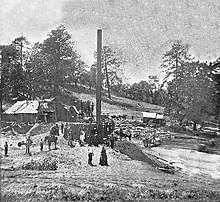
- San Diego County: Stonewall Jackson Mine (1870-1893), the richest gold mine in southern California history[117]
Colorado
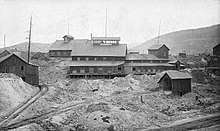
Schools
- Keenesburg: Weld Central Senior High School and Weld Central Middle School share the Weld Central Rebel, a Civil-war-era-soldier which used to appear with depictions of Confederate flags. School teams are named Rebels.[118]
Monument
- Confederate monument Riverside Cemetery, Denver (1973)[119]
Delaware
As of 24 June 2020, there is at least one public space with Confederate monuments in Delaware.[73]
- Georgetown: Delaware Confederate Monument, a private monument built on the grounds of the Georgetown Historical Society, unveiled in 2007.[122][123]
District of Columbia
As of 24 June 2020, there are at least nine public Confederate monuments in District of Columbia, mostly in the National Statuary Hall Collection. (See above)[73]
- Washington: Statue of Albert Pike (1901):[124] An outdoor statue that is owned by the National Park Service at 3rd and D Streets NW in the Judiciary Square neighborhood of Washington, D.C. Pike was a Confederate General and leading Freemason and is dressed as a Mason in the sculpture.[73][46] The statue is a "portrait of Albert Pike as a Masonic leader and not as a general in the military."[125][126][127] "Eight D.C. elected officials have asked the National Park Service to remove" the statue.[128] On June 19, 2020, protesters tore down the statue and set it on fire as part of the George Floyd protests because of Pike's association with the Confederacy.
Florida
As of 24 June 2020, there are at least 63 public spaces with Confederate monuments in Florida.[73]
An August 2017 meeting of the Florida League of Mayors was devoted to the topic of what to do with Civil War monuments.[129]
State capitol
- Confederate monument of Leon County, on the grounds of the former Florida State Capitol, the "Old Capitol," now a museum.[130] Erected 1882 by "our country women", moved to current location 1923.[131]
State symbol
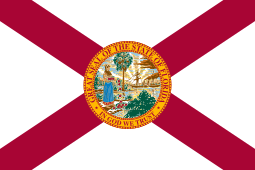
- The current flag of Florida, adopted by popular referendum in 1900, with minor changes in 1985, contains the St. Andrew's Cross. It is believed that the Cross was added in memory of, and showing support for, the Confederacy.[132][133][134] Other instead say there is no link with the confederacy, but that the saltire recalls the Cross of Burgundy, the emblem of New Spain.[135][136][137] The addition of the Cross was proposed by Governor Francis P. Fleming, a former Confederate soldier, who was strongly committed to racial segregation.
State holiday
- In Florida, Robert E. Lee's birthday (January 19), Confederate Memorial Day (April 26), and Jefferson Davis's birthday (June 3) are legal holidays.[138]
Monuments
Courthouse monuments

- Bartow: 7th Florida Infantry Regiment Monument, Old Polk County Courthouse (1982)[139]
- Brooksville: Confederate Soldiers' Memorial, Hernando County Courthouse (1916)[140][30]
- Defuniak Springs: Florida's First Confederate Monument, Walton County Courthouse (1871, historic marker nearby)
- Marianna:
- Battle of Marianna Monument, Jackson County Courthouse lawn (1924)[141][30]:36
- Confederate monument, Jackson County Courthouse lawn (1881)
- Monticello: Confederate monument, Jefferson County Courthouse (1899)[141][142][30]:36
- Ocala: Confederate monument, erected on the grounds of the Marion County Courthouse (1908, moved to Veterans Memorial Park and rededicated 2011).[143][30]:37 The Confederate flag that flew in front of the Marion County Courthouse was to be moved to "elsewhere on the campus".[144]
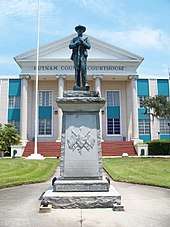
- Palatka: Confederate monument, Putnam County Courthouse (1925)[145][30]:38
- Quincy: Gadsden Confederate Memorial, Gadsden County Courthouse
Other public monuments
- Daytona Beach:
- Confederate Sun Dial Monument (1961)[30] Originally a marble base and column topped with a sundial (by the early 1980s all that remained was its base and its bronze plaque). Dedicated to the Confederate dead. Erected by United Daughters of the Confederacy in 1961. Plaque was removed by the City of Daytona Beach in 2017 after violent clashes in Charlottesville, Virginia over their Robert E. Lee monument. Was to be given to Halifax Historical Museum.[146]
- Two other bronze plaques were erected in Riverfront Park by the Sons of Confederate Veterans in 1979 and 1985, which listed the names of Confederate veterans buried in East Volusia County. They were mounted on a long granite wall with other plaques commemorating various US wars. They were also removed by the city in 2017 to also be given to the Halifax Historical Museum.[146]
- Confederate Boulder Monument (1979)[30]:33
- Dixie County: American Veteran Monument, Highway 98 west of Old Town, dedicated to Confederate veterans (ca. 2005)[147]
- Jefferson County, Florida: Monument to Stonewall Jackson
- Ellenton:
- Confederate Veterans Memorial Monument, Gamble Plantation Historic State Park (1937)[30][148]
- Judah P. Benjamin Confederate Memorial at Gamble Plantation Historic State Park, established 1925, pursuant to agreement between UDC and State of Florida.[149] Benjamin was Attorney General, then Secretary of War, then Secretary of State of the Confederacy. Also serves as home to Florida Division of UDC.[150]
- Fernandina Beach: Statue of David Levy Yulee.[151]
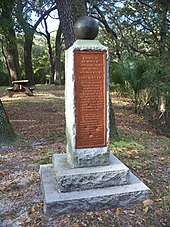
- Jacksonville:
- Confederate Park. It opened in 1907 as Dignan Park, named for a former chairman of the city's Board of Public Works. In 1914, the park was chosen as the location of the annual reunion of the United Confederate Veterans. The UCV chose the park as the location for a new monument to honor the Women of the Southland, and five months after the reunion the city renamed the park "Confederate Park."
- Florida's Tribute to the Women of the Confederacy, in Confederate Park (1915). The sculptor was Allen George Newman.[152]
- Confederate monument, downtown Hemming Park (1898)[153][30]:34 "The president of Jacksonville City Council, Anna Lopez Brosche, called for all Confederate monuments to be moved from city property to a museum. The most prominent Confederate memorial in Jacksonville is a statue of a Confederate soldier that sits atop a towering pillar in Hemming Park."[154]
- Yellow Bluff Fort Monument, Yellow Bluff Fort Historic State Park (1951)[155]
- Key West:
- Lake City: Confederate Dead of Battle of Olustee, town square in front of the Columbia County Courthouse (1928)[159]
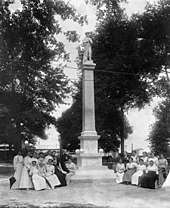
- Leon County: A plaque commemorating Robert E. Lee and the Dixie Highway on Thomasville Road (U.S. Highway 319), one mile from the Georgia state line. Erected 1926 by the Anna Jackson Chapter of Daughters of the Confederacy.[141]
- Madison: Confederate monument, Four Freedoms Park (1909). Lists names of men who died from county. Nearby sits a monument to former slaves in the county.[141][30]:35
- Miami: Confederate monument, Confederate Circle in City Cemetery (1914 at the Dade County Courthouse, was moved to cemetery in 1927)[160][30]:36
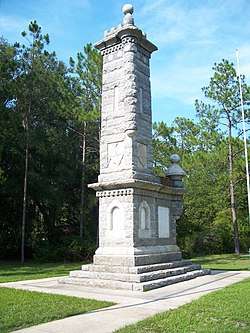
- Olustee:
- Battlefield monument, Olustee Battlefield Historic State Park (1912). Inscription: Here was fought on February 20, 1864 the Battle of Ocean Pond under the immediate command of General Alfred Holt Colquitt, "Hero of Olustee." This decisive engagement prevented a Sherman-like invasion of Georgia from the south. Erected April 20, 1936, by the Alfred Holt Colquitt Chapter, United Daughters of the Confederacy Ga. Div.
- CSA Brigadier General Joseph Finnegan Monument, Olustee Battlefield Historic State Park (1912). "Placed by The United Daughters of the Confederacy Florida Division In Memory of Brig. Gen. Joseph Finegan Commander of the District of Middle and East Florida So well did he perform his part that a signal victory over the Federals was won in the Battle of Olustee Feb. 20, 1864"
- Pensacola:
- Florida Square was renamed Lee Square in 1889.[161]
- A 50-foot monument to Our Confederate Dead, erected in 1891, is in Lee Square.[162] It commemorates Jefferson Davis, Pensacolian Confederate veterans Stephen R. Mallory (Secretary of the Confederate Navy) and Edward Aylesworth Perry (Confederate General and Governor of Florida 1885-1889), and "the Uncrowned Heroes of the Southern Confederacy." The mayor of Pensacola has called for its removal.[161]
- Perry: Confederate monument, Taylor County Sports Complex (2007)[163][164]
- Quincy: Confederate memorial, Soldiers Cemetery within Eastern Cemetery, part of the town's National Register Historic District (2010). The memorial also notes the restoration of the historic fence.[165][166]
- St. Augustine:
- Confederate monument, on the Plaza de la Constitución (1879).[167] "The Confederate Memorial Contextualization Advisory Committee, a seven-member task force comprised mostly of historians", in 2018 recommended to the City Commission that the monument be kept, with the addition of "some necessary context".[168]
- Memorial to William Wing Loring, on the Plaza de la Constitución, erected behind the Government House (1920)[169]
- St. Cloud: Confederate monument, Veterans Park (2006)[170]
- St. Petersburg: Confederate monument, Greenwood Cemetery (1900)[171]
- Tampa: There is a stained-glass window donated by the United Daughters of the Confederacy in 1906 in honor of Father Abram Ryan, called "Poet of the Confederacy", in the Sacred Heart Catholic Church.
- Trenton: Confederate monument, across from Gilchrist County Courthouse in Veterans' Park (2010)[172]
- Woodville: In Loving Memory Monument, Natural Bridge Battlefield Historic State Park (1922)[30]:37 A plaque placed at the base of the monument in 2000 lists the names of those who died as a result of the battle.[173]
Private monuments
- Alachua: Confederate monument, Newnansville Cemetery (2002) by the Alachua Lions Club[174]
- Bradfordville, unincorporated community in Leon County: Robert E. Lee Monument, dedicated along Highway 319 in 1927 by UDC. Moved in the 1960s and 1990s, it is now located about a mile south of the Georgia border.[175][176]
- Dade City: Confederate memorial, Townsend House Cemetery (2010)[177]
- Deland: Confederate Veteran Memorial, Oakdale Cemetery (1958)[178]
- Kissimmee: Granite obelisk in Rose Hill Cemetery, dedicated to Confederate veterans buried in Osceola County with their names listed on the monument. Erected 2002 by Sons of Confederate Veterans.[146]
- Lake City:
- Last Confederate War Widow, Oaklawn Cemetery, erected after her death in 1985. The memorial and the cemetery are along the Florida Civil War Heritage Trail.[179][180]:28
- Our Confederate Dead, Oaklawn Cemetery (1901, rededicated 1996). A tall obelisk in memory of the unnamed soldiers who died at the nearby Battle of Olustee or in the town's Confederate hospital. The cemetery is the focal point of the opening of Lake City's annual Olustee Battle Festival.[181][182]
- Leesburg: Memorial fountain made of rustic limestone, in Lone Oak Cemetery. Erected 1935 by United Daughters of the Confederacy but dedicated to soldiers of all wars. An adjacent 20-foot flagpole and inscribed granite block dedicated to Civil War veterans buried there was erected by the United Daughters of the Confederacy in 2005.[146]
- Ormond Beach: 2011; Pilgrim's Rest Cemetery. Monument consists of a flagpole and a concrete base with an attached bronze Southern Cross of Honor and a granite slab listing the names of Confederate veterans buried there. Erected by Confederate Sons Association of Florida.[146]
- Oxford: Upright granite slab monument in Pine Level Cemetery, listing the names of Confederate veterans buried in the cemetery. Erected 2007 by Sons of Confederate Veterans.[146]
- White Springs: Confederate monument and large flag, along Interstate 75 (2002)[183]
Inhabited places
Counties
- Baker County (1861), named for James McNair Baker, a lawyer and judge who was a Confederate States of America Senator from Florida.[184]
- Bradford County (1861), named for Captain Richard Bradford, who was killed in the Battle of Santa Rosa Island, becoming the first Confederate officer from Florida to die during the Civil War.[184]
- Hendry County (1923), named for Francis Asbury Hendry, a Confederate Captain and one of the first settlers in the area.[184]
- Lee County (1887), named for Robert E. Lee.[185]
- Levy County (1845), named for David Levy Yulee, a Florida businessman, senator, and strong supporter of slavery, who withdrew from the U.S. Senate in 1861 and served nine months in prison after the Civil War for supporting the Confederacy.
- Pasco County (1887), named for Samuel Pasco, who fought for the CSA but spent much of the war as a prisoner of war. Pasco later became a state representative and US Senator from Florida.
Municipalities
- Bartow (1862), renamed for CSA Col. Francis Bartow.[186]
- Fort Myers, named for Abraham Myers, Quartermaster General of the Confederate Army.[129]
- Lee: named for Robert E. Lee.
- Mayo, named for CSA Col. James Mayo.[187]
- Perry (1875), named for Florida Governor and CSA Col. Madison Starke Perry.[141]
- Starke. The origin of the name is unknown. A prominent theory is that it was named in honor of Madison Starke Perry, fourth governor of Florida and a Confederate States Army colonel. The Division of Historical Resources of the Florida Department of State adds that the city may have been named for "Thomas Starke, a slaveholder who once owned much land around the area."[188]
- Titusville (1873), renamed by CSA Col. Henry T. Titus, who also supplied Confederate troops.[188]
- Yulee (1893), named for David Levy Yulee, a supporter of slavery and secession. See Levy County, above.
Parks
- Ellenton: Judah P. Benjamin Confederate Memorial at Gamble Plantation Historic State Park (1925)[189]
- Fort Walton Beach: Heritage Park preserves the Confederate Camp Walton named for the county it was located in.[190]
- Jacksonville:
- Confederate Park, opened in 1907. Originally named Dignan Park, the park was renamed when UCV chose the locale as the site for their annual reunions in 1914.[191]
- Hemming Park/Hemming Plaza (1899) renamed in honor of Civil War veteran Charles C. Hemming, after he installed a 62-foot (19 m)-tall Confederate monument in the park in 1898.[192][193]
- Hemming Park station an elevated rail station taking its name from the park.
- Miami: Robert E. Lee Park, the athletic field of Jose de Diego Middle School which replaced Robert E. Lee Middle School (1924–1989) in the Wynwood neighborhood in 1999.[194] A school district spokesman has said the name is not official and requested agencies with incorrect listings update them.[195]
- Pensacola: Lee Square (1889)[73]
Roads
- Stonewall Jackson Memorial Highway, designated by UDC. Chapters placed the following markers in the state:
- Capps: Along U.S. Route 19 in 1940.[196]
- St. Petersburg: Terminus marker at the intersection of Central Avenue and Bayshore Drive in 1939.[197]
Removed by the city August 15, 2017.[198]
- Hilliard: General Lee Road
- Jacksonville
- Confederate Point Road
- Confederate Street
- General Lee Road
- Naples: Confederate Drive
- Orlando
- Kirby Smith Road
- Stonewall Jackson Road
- Pensacola: Confederate Drive
- Perry: North Jeff Davis Avenue
- St. Cloud: Robert Lee Road
- Stuart: Southeast General Lee Terrace
- Tampa: Robert E. Lee Road
- Zephyrhills:
- Jeff Davis Drive
- Jubal Early Road
Schools and libraries
- Gainesville:
- J.J. Finley Elementary School (1939), named for CSA Brig. Gen. Jesse J. Finley.[199]
- Kirby-Smith Center (1939), Alachua County Public Schools administrative offices. Constructed in 1900, the building was initially the all white Gainesville Graded & High School.[200] In August 2017, the school board announced plans to rename the center.[201]
- Sidney Lanier School. Lanier was a Confederate soldier and poet.
- Hillsborough County: Robert E. Lee Elementary School aka Lee Elementary Magnet School of World Studies and Technology was built 1906 and named for Lee in 1943. A school board member pushing for a rename in 2017 noted that had Lee's army won the war "a majority of our students would be slaves."[202]
- Jacksonville[203]
- J.E.B. Stuart Middle School (1966), named for CSA Gen. J. E. B. Stuart.
- Jefferson Davis Middle School (1961)
- Kirby-Smith Middle School (1924), named for CSA Gen. Edmund Kirby Smith.
- Robert E. Lee High School (1928)
- Stonewall Jackson Elementary School
- Orlando: Robert E. Lee Middle School, renamed College Park Middle School in 2017.[204]
- Pensacola: Escambia High School's Rebel mascot riots, 1972–1977. Before a noncontroversial name was chosen, protests and violence occurred at the school and in the community, crosses were burned on school district members' lawns, lawsuits were filed, and the Ku Klux Klan held a rally and petitioned the school board.
- Tampa: Lee Elementary School of Technology / World Studies (1906). The school's mascot is Robert E. Lee's horse Traveller. In July 2015, students asked the school board to change the school's name.[205] In June 2017, a board member asked the board to consider the name change.[206]
City symbols
- Panama City: city flag is quite similar to the Florida state flag with a white background and the St Andrews cross echoing the Confederate Battle Flag, but with the city seal replacing the state seal.
City holiday
- On April 2, 2019, Ocala mayor Kent Guinn signed a declaration declaring that April 26, 2019 would be Confederate Memorial Day. He said he has done so in previous years.[207]
County holiday
- In 2016, the Commission of Marion County (county seat Ocala) declared April as Confederate History Month.[144]
Georgia
As of 24 June 2020, there are at least 201 public spaces with Confederate monuments in Georgia.[73]
Hawaii
- A plaque in the National Memorial Cemetery of the Pacific commemorates Hawaiians who fought for the Confederacy, as well as Hawaiians who fought for the Union.
Idaho
As of 24 June 2020, there are at least 3 public spaces with Confederate monuments in Idaho.[73]
The settlement of Idaho coincided with the Civil War and settlers from Southern states memorialized the Confederacy with the names of several towns and natural features.[208][209][210]
Inhabited places
- Atlanta: unincorporated, and its Atlanta Airport. The area was named by Southerners after reports of a Confederate victory over Gen. Sherman in the Battle of Atlanta, which turned to be wholly false, but the name stuck.
- Confederate Gulch: unincorporated former mining community.[211][210]
- Grayback Gulch: unincorporated former mining community, settled by Confederate soldiers and named for the color of their uniforms. Now a U.S. Forest Service campground.[212]
- Leesburg: an unincorporated former goldmining town settled by southerners and named for Robert E. Lee.[213]
Natural features and recreation
- Elmore County: located within Boise National Forest are:
- Robert E. Lee Campground[214]
- Robert E Lee Creek[215]
Chattanooga Hot Springs, near Atlanta, ID [216]
Illinois
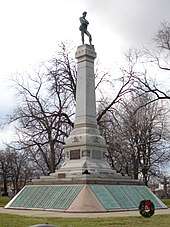
The four memorials in Illinois are in Federal cemeteries and connected with prisoners of war.
Federal cemeteries
- Alton: UDC monument (1909), North Alton Confederate Cemetery. Dedicated to Confederate soldiers who died at Alton Military Prison[217] As of October, 2018, it is one of 7 cemeteries with Confederate monuments that the Veterans Administration has under 24-hour guard.[218]
- Rock Island: UDC obelisk (2003), Rock Island Confederate Cemetery. Dedicated to Confederate soldiers who died at Rock Island Military Prison[219]
- Springfield: UDC/SCV monument (2005), Camp Butler National Cemetery. Dedicated to Confederate soldiers who died at Camp Butler.[220]
Federal plot within private cemetery
- Chicago: Confederate Mound (1895), Oak Woods Cemetery. Mass grave and monument dedicated to Confederate soldiers who died at Camp Douglas.[221] As of October, 2018, the Veterans Administration has it under dawn to dusk guard.[218] It is No. 7 on the Make It Right Project's 2018 list of the 10 Confederate monuments it most wants removed.[222]
Indiana
As of 24 June 2020, there is at least one public space with Confederate monuments in Indiana.[73]
- Multiple locations: There are 27 historical markers/point-of-interest displays marking the route of John Hunt Morgan through Indiana.[223][224]
- Corydon: Corydon Battle Site is a memorial to both sides that fought in the Battle of Corydon, the only Civil War battle in Indiana. It contains Corydon's Civil War Museum.[225]
- Evansville: The Confederate monument (1904) at Oak Hill Cemetery marks the burial site of 24 Confederate prisoners who died at Evansville.[226]
- Indianapolis:
- Confederate Soldiers and Sailors Monument, Garfield Park,[227] erected, according to its inscription, "to mark the burial place of 1616 Confederate soldiers and sailors who died here as prisoners of war and whose graves cannot now be identified."[228] Following protests of the killing of George Floyd in June 2020, the city announced plans to remove the monument.[229]
- A granite monument was erected in 1933 at Crown Hill National Cemetery, a burial site for Confederate prisoners who died at Camp Morton.[230]
- Terre Haute: Woodlawn Monument Site (1912), Woodlawn Cemetery. Erected by the Federal Government to commemorate 11 Confederate soldiers who died in a local prison camp.[231]
- Versailles: Versailles is the location of a skirmish with Morgan's Raiders. South Ripley High School named their mascot the Raiders in honor of John Hunt Morgan's campaign across Indiana.
Iowa
As of 24 June 2020, there is at least one public space with Confederate monuments in Iowa.[73]
- Bentonsport: Monument to Lawrence Sullivan Ross (2007), Iowa's only Confederate general[232]
- Bloomfield:[232] Confederate Invasion of Iowa Monument (2005)[233]
Kansas
As of 24 June 2020, there are no public spaces with Confederate monuments in Kansas.[73] See Removal of Confederate monuments and memorials#Kansas for monuments which have been removed.
Kentucky
As of 24 June 2020, there are at least 37 public spaces with Confederate monuments in Kentucky.[73]
Monuments
- Augusta: Confederate Monument, Payne Cemetery, 1903.
- Bardstown: Confederate Monument, Bardstown/St. Joseph's Cemetery, 1903.
- Bowling Green:
- Confederate Monument of Bowling Green, Fairview Cemetery, 1876.
- William F. Perry Monument, Fairview Cemetery, 1901.
- Brandenburg: Confederate monument (2016) removed from Louisville[234] Armed protesters surrounded the monument to prevent its removal in June 2020.[235]
- Cadiz: Confederate Monument, Trigg County Courthouse, 1913.[236]
- Covington: Veteran's Monument, Linden Grove Cemetery, 1933. It was dedicated by the American Legion and honors both Confederate and Union veterans.
- Crab Orchard: Confederate Monument, Crab Orchard Cemetery, 1872.
- Cynthiana: Confederate Monument, Battle Grove Cemetery, 1869.
- Danville: Confederate Monument, McDowell Park, 1910.[237]
- Eminence: Confederate Soldiers Martyrs Monument, Eminence Cemetery, 1870.
- Fairview: Confederate monument at the Jefferson Davis Monument State Historic Site, a state park commemorating Davis's birthplace, completed in 1924. It contains a "35-story obelisk."[238]
- Frankfort: Confederate Monument, Frankfort Cemetery, 1892.
- Fulton: Confederate Monument, Fairview Cemetery, 1902.

- Georgetown: Confederate Monument, Georgetown Cemetery, 1888.[239]
- Graves County: Camp Beauregard Memorial (1909), Camp Beauregard Cemetery. UDC memorial to Confederate soldiers who died at Camp Beauregard "for the Confederate State of America and were denied the glory of heroic service in a battle".[240]
- Glasgow: Confederate Monument, Barren County Courthouse, 1905.
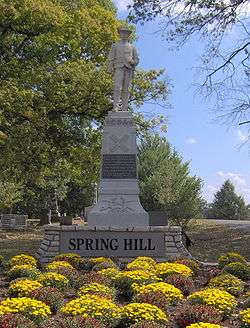
- Harrodsburg: Confederate Monument, Spring Hill Cemetery, 1902.
- Hickman: Confederate Memorial Gateway, Hickman City Cemetery, 1913.
- Hopkinsville:
- Confederate Memorial Fountain, Christian County Courthouse, 1911.
- Latham Confederate Monument, Riverside Cemetery, 1887.
- Horse Cave: Unknown Confederate Soldier Monument, Old Dixie Highway, 1934.
- Jeffersontown: Confederate Martyrs Monument, Jeffersontown City Cemetery, 1904.
- Lawrenceburg: Confederate Monument, Anderson County Courthouse, 1894.
- Lexington:
- Ladies' Confederate Memorial, Lexington Cemetery, 1874.
- Confederate Soldier Monument in Lexington, Lexington Cemetery, 1893.
- John C. Breckinridge Memorial moved from Courthouse to Lexington Cemetery Oct 2017.[241]
- John Hunt Morgan Memorial moved from Courthouse to Lexington Cemetery October 2017.[241]
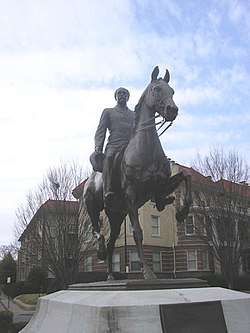
- Louisville:
- John B. Castleman Monument, Cherokee Triangle, 1882. On the night of August 12–13, 2017, the statue and the historical marker near it were disfigured with red paint.[242] The mayor of Louisville, Greg Fischer, on the recommendation of a Public Art and Monuments Advisory Committee that he appointed in late 2017, has said the goal is to have it removed by the end of 2018.[243]
- Confederate Monument, dedicated in 1895 and was placed next to the University of Louisville on city property. It was removed and re-located to a riverfront park in Brandenburg, Kentucky in December 2016.[244]
- Madisonville: Confederate Monument, Hopkins County Courthouse, 1909.[245]
- Mayfield:
- Confederate Monument, Graves County Courthouse, 1920.
- Confederate Monument, Maplewood Cemetery, 1924.
- Maysville: plaque commemorating Albert Sidney Johnston.[246]
- Midway: Martyrs Monument, Midway City Cemetery, 1890.
- Morganfield: Confederate Monument, City Cemetery/Odd Fellows Cemetery, 1870.
- Morgantown: Confederate-Union Veterans' Monument, Butler County Courthouse, 1907.
- Mt. Sterling: Confederate Monument, Machpelan Cemetery, 1880.
- Munfordville: Colonel Robert A. Smith Monument, near the Green River, 1885.
- Murray: Confederate Monument, Calloway County Courthouse, 1917.
- Nancy: General Felix K. Zollicoffer Monument, Zollicoffer Park, Mill Springs Battlefield, 1910.
- Nancy: Confederate Mass Grave Monument, Zollicoffer Park, Mill Springs Battlefield, 1910.
- Nicholasville: Confederate Memorial, Jessamine County Courthouse, 1896.[247]
- Owensboro: Confederate Monument, Daviess County Courthouse, 1900.
- Owingsville: Confederate Monument, Owingsville Cemetery, 1907.
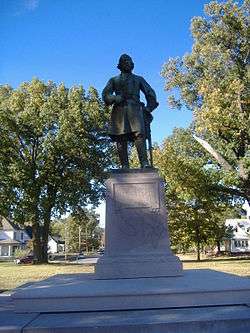
- Paducah:
- Confederate Monument, Oak Grove Cemetery, 1907.[248]
- First Confederate Volunteer From Paducah, marker embedded in city sidewalk.[248]
- General Lloyd Tilghman Statue, Lang Park, 1909.[248]
- Paris: Bourbon County Confederate Monument, Paris Cemetery, 1887.
- Perryville:
- Confederate Monument, Perryville Battlefield State Historic Site, 1902. Commissioned by the state of Kentucky.[249]
- Unknown Confederate Dead Monument, Goodknight Cemetery, 1928.[249]
- Pewee Valley: Pewee Valley Confederate Monument, Pewee Valley Confederate Cemetery, 1904.
- Princeton: Confederate Soldier Monument, Caldwell County Courthouse, 1912.[250]
- Russellville: Confederate Monument, Town Square, 1910.
- Somerset:
- Battle of Dutton's Hill Monument, Old Crab Orchard Road, 1875.[251]
- St. Joseph: Thompson and Powell Martyrs Monument, St. Alphonsus Catholic Church Cemetery, 1880.[252]
- Versailles: Confederate Monument, Versailles Cemetery, 1877.
Bridge
- Cynthiana: The John Hunt Morgan Bridge, on South Main St./U.S. 27, is named for a Confederate general.
Inhabited places
- Breckinridge Center: a census-designated place in Union County, Kentucky. Named because of nearby Camp Breckinridge, which was named for John C. Breckinridge, U.S. Vice President and Confederate general.
- Lee County (1870)
- Confederate, Kentucky
- Vanceburg, named for Confederate Colonel and North Carolina governor Zebulon Baird Vance. His wife was from Kentucky.
Parks
- Fairview: Jefferson Davis State Historic Site (1957) the site includes Davis's birthplace, a memorial to Davis that includes a 341 ft obelisk (the second tallest obelisk in the world after the Washington Monument), Confederate flags and other signs and plaques.[253]
- Lexington: A historical marker identifying the approximate site of the birth of Confederate Brigadier General David Rice Atchison is located along Highway 1974 in the Landsdowne neighborhood of Lexington, Kentucky.[254]
Roads
- Elkton:
- Jefferson Davis Highway
- Jefferson Davis Road
- Erlanger:
- General Ross Drive
- General Stuart Drive
- Jefferson Davis Place
- Robert E. Lee Drive
- Madisonville: Jefferson Davis Drive
- Mayfield: Jeff Davis Road
- Raywick: Robert Lee Road
- Vine Grove: Stand Watie Road
Highways
- Jefferson Davis Memorial Highway: Marker located in the Fountain Avenue median in Paducah, 1935. The marker is along an auxiliary route that follows U.S. Route 68 from Bowling Green, Kentucky to Paducah, Kentucky.[248]
Schools
- Bedford: Trimble County High School named their mascot the Raiders, in honor of John Hunt Morgan's men.
- Eastern: Allen Central High School: Allen Central athletic teams are nicknamed the "Rebels." The school features various Confederate iconography[255]
- Munfordville: Hart County High School named their mascot the Raiders, in honor of John Hunt Morgan's men. Also, a large mural in the town depicts Morgan.
- Richmond: Eastern Kentucky University. EKU athletic teams are nicknamed the "Colonels," a Confederate figure.[256]
Louisiana
As of 24 June 2020, there are at least 83 public spaces with Confederate monuments in Louisiana.[73]
State capitol
- Gov. Francis T. Nicholls Statue (1934). Nicholls was a Brigadier General in the Confederate Army.
- Gov. Henry Watkins Allen Statue (1934). Allen was a Brigadier General in the Confederate Army. He is buried on the Old Louisiana State Capitol grounds.
- "Silent Sentinel" Monument, officially the Confederate Soldiers of East and West Baton Rouge Parishes Memorial. Plinth erected 1886 and statue in 1890. Dedicated by Gov. John McEnery. Original granite and marble plinth cracked; replaced in the 1960s with a small brick plinth that was aesthetically unappealing. Formerly at North Boulevard and 3rd Street, near City Hall. In 2012, to make room for Town Square construction, it was moved to the nearby Old Louisiana State Capitol, now a museum.[257] Plaque reads: "Erected by the men and women of East and West Baton Rouge to perpetuate the heroism and patriotic devotion of the noble soldiers from the two parishes who wore the gray and crossed the river with their immortal leaders to rest under the shade of the trees. Original monument erected 1886 A.D."
Buildings
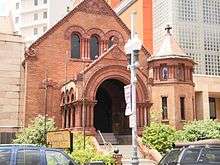
- Baton Rouge: Edmund Kirby Smith Hall at Building Louisiana State University (1965/ 2011). In 2017 "slated for demolition".[257]
- Thibodaux: P.G.T. Beauregard Hall at Nicholls State University (1961/ 2010). The school is named for Confederate General and later Governor Francis T. Nicholls.
- New Orleans:
- Gibson Hall at Tulane University (1894), named for Randall L. Gibson
- Confederate Memorial Hall Museum (1891), the oldest museum in Louisiana[258]
- Adolph Meyer School (1917), New Orleans, named for Confederate general Adolph Meyer who served nine terms in the U.S. House of Representatives and advocated for the construction of the Algiers Naval Station across the street from where the school was later built. The school was renamed in the 1990s for Harriet Tubman.
Monuments
Courthouse monuments
- Alexandria: Rapides Parish Confederate Monument (1914)
- Benton: Confederate Soldier Monument (1910)
- East Feliciana Parish – Confederate Soldiers Monument in Front of the East Feliciana Courthouse Clinton Louisiana[259]
- Franklin: Confederate Monument (1913)
- Lake Charles: South's Defenders Monument (1915)
- Opelousas: Confederate Monument (1920)
- Port Allen: Henry Watkins Allen Statue (1962)
- Shreveport: Confederate Monument, on grounds of the Caddo Parish courthouse, dedicated in 1906 by UDC, NRHP-listed.[260] The Caddo Parish Commission voted to remove it; a legal challenge by the UDC is still pending.[261]
- St. Francisville: Confederate Monument (1903). Has Confederate flag above the inscription: "In memory of West Feliciana's Confederate dead, wherever at rest. Co. C 1st Regt. La. Cavalry".
- Tallulah: Confederate Monument (1912)
- Winnfield: Confederate Monument (1926)
Other public monuments
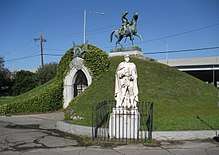
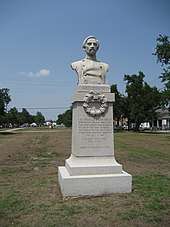
- Baton Rouge:
- Breckinridge's March Monument (1931)
- Confederate Monument (1886)
- Jefferson Davis Highway Monument
- Belle Chasse: Judah P. Benjamin Monument (1968)
- Clinton: Confederate Monument (1909)
- DeSoto Parish: monuments commemorating the Battle of Pleasant Hill include:
- Lieutenant Gen. Richard Taylor memorial (1994) outside Pleasant Hill American Legion Hall[262]
- Red River Campaign memorial (1994)[263]
- UDC Confederate memorial[264]
- Donaldsonville: Fort Butler Memorial (1999)
- Gretna: Jefferson Davis Highway Marker
- Homer: Confederate Monument (1940)
- Johnson Bayou: Robert E. L Statue (1984)
- Lafayette: Brig. Gen. J.J. Alfred A. Mouton Statue (1922). There has been considerable local discussion about what to do with the monument.[265][266]
- Marthaville: Unknown Confederate Soldier Monument (1970)
- Minden: Confederate Monument (1933)
- New Orleans:
- Confederate Monument (1874), Greenwood Cemetery[267]
- Army of Tennessee Tomb (1886) at Metairie Cemetery, consisting of a Gothic chapel tomb containing 48 vaults, surmounted by an equestrian statue of Albert Sidney Johnston. A marble statue near the tomb's entrance shows a Confederate sergeant calling the roll. Johnston, P. G. T. Beauregard, and other Confederate soldiers are entombed there.[268]
- Monument to Confederate Colonel Charles Didier Dreux, first Confederate officer killed in action. At intersection of South Jefferson Davis Parkway and Canal Street, across from former location of Jefferson Davis Monument.[269]
- Monument to Catholic priest Abram J. Ryan, called poet-priest of the Confederacy. At South Jefferson Davis Parkway and Banks Street. Erected in 1949 by the United Daughters of the Confederacy.[269]
- Monument to General Albert Pike, at South Jefferson Davis Parkway and Tulane Avenue. Erected 1957. Defaced with "Black Lives Matter" in 2015.[269]
- Plaquemine: Confederate Memorial (1914)
- Shreveport: Fort Humbug Confederate Memorial (1927)
- Tangipahoa Parish: Confederate monument (1907) at Camp Moore, a museum and former Confederate training camp[270]
- Zachary: Port Hudson Confederate Monument (1930)
Inhabited places
- Allen Parish. Named after Henry Watkins Allen, Confederate General and Governor of Louisiana during the Confederacy.
- Allendale, a neighborhood in Shreveport, where Henry Watkins Allen lived.
- Beauregard Parish (1913)
- Jefferson Davis Parish (1912)
- Village of Longstreet (unincorporated)
- City of Stonewall (named 1862, incorporated 1972)
- City of Slidell, named for John Slidell, Confederate ambassador to France.
Parks
- Marthaville: Rebel State Historic Site (1962)
Roads
- Baton Rouge:
- Confederate Avenue
- Jeff Davis Street
- Lee Drive[73]
- Bell City: Jeff Davis Road
- Bogalusa: Jefferson Davis Drive
- Bossier City:
- General Bragg Drive
- General Ewell Drive
- General Polk Drive
- General Sterling Price Drive
- Jeb Stuart Drive
- Kirby Smith Drive
- Longstreet Place
- Robert E. Lee Boulevard
- Robert E. Lee Street
- Chalmette: Beauregard Street
- Gretna: Beauregard Drive
- Houma: Jefferson Davis Street
- Lafayette: Jeff Davis Drive
- Lake Charles:
- Beauregard Drive
- Beauregard Avenue
- Beauregard Street
- Merryville: Robert E. Lee Road
- Monroe: Jefferson Davis Drive
- New Orleans:
- Beauregard Drive
- Dreux Avenue, named for Confederate General Charles Didier Dreux
- Gayarre Place, named for Charles Gayarré, white supremacist and financial supporter of the Confederacy. Clio, muse or goddess of history, is on a monument. (Gayarré was a historian.) The monument was paid for by George Hacker Dunbar, an artilleryman during the Civil War, married to a niece of General Beauregard. The original statue was replaced in 1938, after vandals damaged it.[271]
- Governor Nicholls Street
- Jefferson Davis Parkway. Originally named Hagan Avenue; name changed in 1911 to coincide with the unveiling of the Jefferson Davis Monument.[269]
- Lee Circle[73]
- Polk Street
- Robert E. Lee Boulevard
- Slidell Street
- Pineville:
- Jefferson Davis Drive
- Longstreet Drive
- Rayne: Jeff Davis Avenue
Schools
- De Ridder:
- Beauregard Alternative School
- East Beauregard Elementary School (2001)
- De Ridder: East Beauregard High School (1962)
- Monroe: Robert E. Lee Junior High School
- Longville:
- South Beauregard Elementary School
- South Beauregard High School
- Louisiana State University is home of the LSU Tigers (1896) and Lady Tigers teams also known as the Fighting Tigers named for the Louisiana Tigers, several Confederate Civil War regiments.[272][273]
- Saint Bernard: P.G.T. Beauregard Middle School (closed)[274]
- Thibodaux: Nicholls State University (1948), named for CSA Brig. Gen. Francis Redding Tillou Nicholls. The school's mascot, Colonel Tillou, is also named for Nicholls.[275]
Confederate flag display
- Baton Rouge: The Stars and Bars Confederate flag and the Bonnie Blue Flag are flown behind City Hall, along with the Flag of Louisiana.[257]
Maryland

As of 27 June 2020, there are at least three public homages to the Confederacy in Maryland.[73]
State symbols
- Flag of Maryland (1904). The state flag of Maryland features the red-and-white Crossland Banner, the unofficial state flag of Maryland used by secessionists and Confederates during the American Civil War.[276][277][278][279] The current state flag started appearing after the Civil War as a form of reconciliation. The flag became official in 1904.
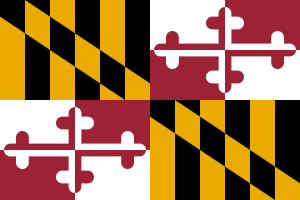 Flag of Maryland since 1904
Flag of Maryland since 1904
- The state song "Maryland, My Maryland" calls on the state to join the Confederacy.[280] As of 2018, the Maryland General Assembly has eight times taken up the question of the state song, without enacting any change. In 2017, the Mighty Sound of Maryland, the marching band of the University of Maryland at College Park, stopped playing the song.[281]
Monuments
Public monuments
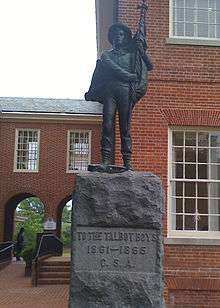
- Baltimore: Confederate monuments at Loudon Park National Cemetery include:
- The Confederate Soldier (1874)[282]
- Fort McHenry Monument (1912), dedicated to Confederate soldiers who died at Fort McHenry, when it was a prisoners-of-war camp.[283]
- Easton: "Talbot Boys" Monument (1914), Talbot County Courthouse[284] A statue of Frederick Douglass was added in 2011. "The county council approved it after months of debate and stipulated it could not exceed the height of the Confederate statue it parallels."[285]
- Scotland (St. Mary's County): Confederate Soldiers and Sailors Monument (1876), and Point Lookout Confederate Cemetery Monument (1910), located at Point Lookout Confederate Cemetery.[286] As of October, 2018, it is one of 7 cemeteries with Confederate monuments that the Veterans Administration has under 24-hour guard.[218]
- Washington County:
- Robert E. Lee Statue at Antietam Creek, Antietam National Battlefield (2003)[287] The statue is attempting to be removed by legislation through H.R.970 (2019)[288] and the National Park Service acknowledges the inaccuracies of the statue and educates those in the park accordingly.
- Samuel Garland, Jr. Monument (1993)[289]
Private monuments
- Beallsville: Memorial to Confederate soldiers at Monocacy Cemetery (1911; replaced 1975).[290]
- Frederick: Monument to the Unknown Confederate Soldiers (1881), Mount Olivet Cemetery[291]
- Silver Spring: Confederate Monument, Grace Episcopal Church Cemetery, 1896. Commemorates the death and burial of 17 unknown Confederate Soldiers who died at the Battle of Fort Stevens. The monument, a stone obelisk, can be seen from Georgia Ave.[292][293]
Inhabited places
- Confederate Hills: A residential community near Antietam National Battlefield where the streets are all named after Confederate generals, including: Longstreet Circle, General Anderson Court, General Branch Court, General Gordon Circle, General Hill Circle, General Lee Drive, General Stonewall Jackson Circle, and General Stuart Court.[294][295]
Roads
- Potomac:
- Jubal Early Court
- J. E. B. Stuart Road
Ferry

- Montgomery County: A passenger and vehicle ferry, Gen. Jubal A. Early (1954), connects Montgomery County, Maryland and Loudoun County, Virginia. Owned by White's Ferry and named for Confederate General Jubal Early, it is the only ferry still in operation on the Potomac River.[296]
Gallery
- Point Lookout Confederate Cemetery Monument (center) and Confederate Soldiers and Sailors Monument
 Samuel Garland, Jr. Monument
Samuel Garland, Jr. Monument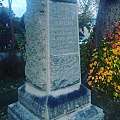 Confederate Memorial in Silver Spring to 17 unknown soldiers buried at Grace Episcopal Church Cemetery after the Battle of Fort Stevens
Confederate Memorial in Silver Spring to 17 unknown soldiers buried at Grace Episcopal Church Cemetery after the Battle of Fort Stevens
Massachusetts
As of 24 June 2020, there are at least 2 public spaces with Confederate monuments in Massachusetts.[73]
Private memorials
- Cambridge
- Memorial Hall, Harvard University. Stained-glass windows to commemorate various figures, among them:
- Honor and Peace Window (1900). There is no inscription, but a Harvard University page () explaining the windows says: "This window commemorates those who surrendered their lives in the War of the Rebellion." Portrays two warriors, one with sword high in triumph, one kneeling in defeat, who from the ribbons can be seen to be from different but related countries.
- Student and Soldier Window (1889). Soldier wears gray uniform.
- Memorial Hall, Harvard University. Stained-glass windows to commemorate various figures, among them:
Mississippi
As of 24 June 2020, there are at least 147 public spaces with Confederate monuments in Mississippi.[73]
Missouri
As of 24 June 2020, there are at least 19 public spaces with Confederate monuments in Missouri.[73]
Monuments
Courthouse monuments
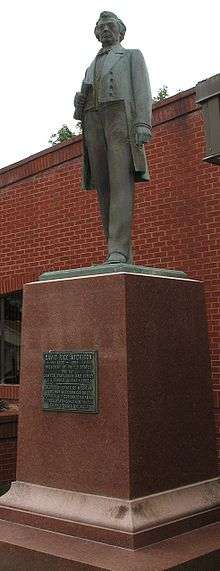
- Cape Girardeau: Confederate War Memorial (1931)
- Columbia: Confederate Monument (1935). Relocated to the Centralia Battlefield in September, 2015.
- Huntsville: Captain Delaney S. Washburn Memorial (1976).
- Neosho: Confederate Captain of Missouri Monument.
- Palmyra: Palmyra Massacre Monument (1907).
- Plattsburg: Statute of CSA Brig Gen David Rice Atchison who was later a US Senator
Other public monuments


- Brookline: Missouri State Guard Monument (2001)
- Centralia: Boone County Confederate Memorial (1935)
- Dexter: Frenchman's Spring Monument (1996). A natural gathering place for soldiers. In July, 1861, 2,000 soldiers from 15 southeast Missouri counties met to organize as the First Division, Missouri State Guard — the pro-Confederate state militia, known as the Swamp Fox Brigade.
- Higginsville: Confederate Memorial State Historic Site; also called "Lion of Lucerne" (1906)
- Kansas City:
- UDC monument at Forest Hill and Calvary Cemetery to CSA soldiers killed at the Battle of Westport. Buried nearby is CSA General Joseph O. Shelby.[297]
- Union Confederate Monument, Union Cemetery (1911)
- Monument to the "Loyal Women of the Old South"[298]
- Keytesville: Sterling Price Monument, Price Park (1915)
- Lone Jack: Cemetery monument to Confederate soldiers who died in the Battle of Lone Jack[299]
- Marshall: Confederate Monument of Saline (1901)
- Naosho: Considered the state capital by Confederates, has two memorials[298]
- Roanoke: Shelby's Homecoming Monument (1997)
- Springfield: Two monuments are located at Springfield National Cemetery: the Monument to Confederate Soldiers of Missouri and General Sterling Price[298] (1901), and a UDC granite marker to the unknown Confederate dead at the Battle of Wilson's Creek (1958).[301] In late August, 2017, someone threw paint on it; as of October, 2018, it is one of 7 cemeteries with Confederate monuments that the Veterans Administration has under 24-hour guard.[218]
- St. Louis:
- Waverly: CSA Gen. Joseph O. Shelby Statue (2009).
- West Alton: Confederate Memorial, Lincoln Shields Recreation Area (1909).[303]
Inhabited places
- Atchison County, Missouri Named for Brigadier General David Rice Atchison
- Breckenridge: Named for U.S. Vice President and Confederate general John C. Breckinridge, although the name was misspelled.[304]
Parks
- Keytesville: Price Park memorializes Major General Sterling Price. (1915)
- Higginsville: Confederate Memorial State Historic Site[305]
Roads
- Battlefield: South Robert E. Lee Street
- Hillsboro: Jefferson Davis Drive
- Sappington:
- General Lee Drive
- Confederacy Drive
Schools
- Southland C-9 School District: Rebelman mascot, school colors red, gray, and white.
Montana
As of 24 June 2020, there are at least 2 public spaces with Confederate monuments in Montana.[73]
- Beaverhead: Confederate Dam[306][307]
- Beaverhead: Jeff Davis Creek[308]
- Confederate Gulch: historic gold mining camp founded in 1864 by Confederate soldiers, including parolees.[309][310]
Nevada
As of 24 June 2020, there is at least one public space with Confederate monuments in Nevada.[73]
- Jeff Davis Peak in the Snake Range mountains of White Pine County was named in 1855 after Jefferson Davis. A name change has been in the works.
New Jersey
There is at least one public space dedicated to the Confederacy in New Jersey.[73]
- Pennsville Township: Confederate Monument (1910), Finn's Point National Cemetery. Commemorates the 2,436 Confederate prisoners-of-war who died at Fort Delaware.[311] As of October, 2018, it is one of 7 cemeteries with Confederate monuments that the Veterans Administration has under 24-hour guard.[218]
New Mexico
As of 24 June 2020, there is at least one public space with Confederate monuments in New Mexico.[73]
- Santa Fe: Confederate memorial (1993), Santa Fe National Cemetery. Granite and bronze memorial dedicated to 31 Confederate soldiers discovered in shallow graves in 1987 at Glorieta Pass Battlefield, then re-interred at Santa Fe National Cemetery.[312][313]
- Socorro: Confederate monument (2012) entitled Victory Awaits You[314]
New York
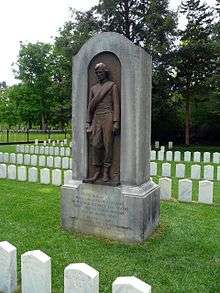
As of 24 June 2020, there are at least 3 public spaces with Confederate monuments in New York.[73][315]
Monuments
Private monuments
- Brooklyn: A tree at St. John's Episcopal Church bears a plaque, installed by UDC in 1912, reading "This tree was planted by CSA Gen. Robert Edward Lee, while stationed at Fort Hamilton."[316] The plaque was removed in 2017.[317]
- Elmira: UDC monument (1937) at Woodlawn National Cemetery, dedicated to Confederate soldiers who died in Elmira Prison.[318] As of October, 2018, it is one of 7 cemeteries with Confederate monuments that the Veterans Administration has under 24-hour guard.[218]
- Hastings-on-Hudson: Confederate marker at Mount Hope Cemetery[319]
- The Bronx: Busts of Stonewall Jackson and Robert E. Lee are in the Hall of Fame for Great Americans at Bronx Community College. The college plans to remove the statues.[317][320]
Roads
- Fort Hamilton, Brooklyn:
- General Lee Avenue
- Stonewall Jackson Drive.
- Governor Andrew Cuomo has twice requested the Army, unsuccessfully, to have these streets renamed.[320]
- Throggs Neck, The Bronx: Longstreet Avenue, named for CSA Gen. James Longstreet[321]
North Carolina
As of 24 June 2020, there are at least 164 public spaces with Confederate monuments in North Carolina.[73]
Ohio
As of 24 June 2020, there are at least 5 public spaces with Confederate monuments in Ohio.[73]
Historical marker
- In 2013, the state of Ohio erected 32 historical markers marking the John Hunt Morgan Heritage Trail.[322][323]
Monuments
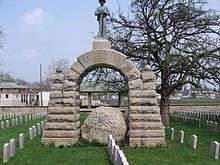
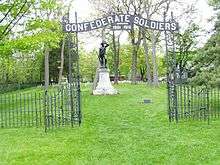
- Columbus: Camp Chase Cemetery's Confederate Soldier Memorial. Dedicated in 1902. Statue on top was toppled and decapitated by vandals in August 2017. The vandals took the head.[325][326] The Veterans Administration stated that the statue will be repaired.[327] As of October, 2018, it is one of 7 cemeteries with Confederate monuments that the Veterans Administration has under 24-hour guard.[218] The statue was repaired by McKay Lodge Art Conservation Laboratory in Oberlin and reinstalled on March 30, 2019.[328]
- Pomeroy: Statue of Confederate general John Hunt Morgan
- Sandusky Bay: Four UDC monuments are located at Confederate Stockade Cemetery on Johnson's Island, the first facility built by the Union Army solely for imprisoning Confederate soldiers[324] As of October, 2018, it is one of 7 cemeteries with Confederate monuments that the Veterans Administration has under 24-hour guard.[218]
- West Point: Marker for Battle of Salineville, the northernmost point Confederate forces reached.
Roads
- Milford:
- Beauregard Court, memorializing CSA Gen. P. G. T. Beauregard
- Jeb Stuart Drive, memorializing CSA Gen. J. E. B. Stuart.
- Stonewall Jackson Drive, memorializing CSA Gen. Stonewall Jackson.
- Colonel Mosby Drive, memorializing CSA Col. John S. Mosby.
- Monassas Run Road, memorializing the CSA victory at the battle at Manassas, known to the North as Bull Run.
Schools
- Cleveland: John Adams High School uses the Rebels team name, but the mascot more closely resembles a cavalier than a Confederate soldier.[329]
- Mcconnelsville: Morgan High School is named for Confederate General John Hunt Morgan. Their nickname is the "Raiders".
- Willoughby: Willoughby South High School dropped its Confederate uniformed mascot and removed all remaining Confederate imagery from the school while retaining the Rebels team name and school colors grey and blue. In 1993 the school dropped Stars and Bars as the school song and removed Confederate imagery from school uniforms.[329]
Oklahoma
As of 24 June 2020, there are at least 13 public spaces with Confederate monuments in Oklahoma.[73]
Buildings
Monuments
- Ardmore:
- Atoka: Two monuments are located at the Confederate Cemetery for soldiers killed in the Battle of Middle Boggy[331][333]
- Delaware County: Two monuments to CSA General Stand Watie at Polson Cemetery; the first erected c. 1910–20, and the second erected in 1971[331]
- Durant:
- Hugo: Rose Hill
- Mayes County: Confederate Monument at site of Second Battle of Cabin Creek (1961)[331]
- Oklahoma City: Confederate Monument in Fairlawn Cemetery (1923)[331]
- Oktaha: Memorial in Oktaha Cemetery to Confederate soldiers who died in the Battle of Honey Springs (1940)[331]
- Rentiesville:
- Confederate Soldiers Monument (1983) in Honey Springs Battlefield by UDC and Children of the Confederacy.[73][331]
- Texas Confederates Memorial in Honey Springs Battlefield by UDC[331]
- Tahlequah:
- Confederate Monument at Cherokee National Capitol (1913).[331] Removed in 2020.[336]
- Stand Watie Monument (1971).[331] Removed in 2020.[336]
- Wynnewood: Confederate Soldier monument (2004)[337]
Schools
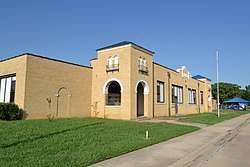
- Durant: Robert E. Lee Elementary School[338]
- Oklahoma City: school board studying renaming in 2017
- Robert E. Lee Elementary School (1910)[339]
- Jackson Elementary School (1910)[339]
- Wheeler Elementary School (1910)[339]
- Stand Watie Elementary School (1930)[339]
- Pauls Valley: Lee Elementary School[73]
Inhabited places
- Jackson County (1907) sources dispute if the name is for the CSA General or President Jackson
- Roger Mills County (1907), named for Roger Q. Mills, Confederate colonel and later Congressman and U.S. Senator.
- Town of Stonewall (1874) for Stonewall Jackson
Roads
- Jay: Stand Watie Road
Pennsylvania
As of 24 June 2020, there are at least 3 public spaces with Confederate monuments in Pennsylvania.[73]
Monuments
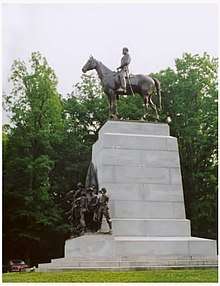
.jpg)
- Gettysburg: Gettysburg Battlefield. In addition to the monuments listed below, the battlefield features monuments to specific Confederate units.[340]
- Alabama State Monument (1933), Joseph Urner, sculptor.
- Arkansas State Monument (1966)
- "Armistead's Last Stand" Marker, for Brig. Gen. Lewis A. Armistead (1887)
- Army of Northern Virginia Marker (1908)
- Culp Brothers Memorial (2013), Gary Casteel, sculptor, near entrance Gettysburg Heritage Center. Honors brothers who fought on opposite sides: Confederate Private Wesley Culp and Union Lieutenant William Culp ("Brother against Brother").[341]
- Lt. Gen. Richard S. Ewell's Headquarters Marker (1920)
- Florida State Monument (1963)
- Georgia State Monument (1961)
- High Water Mark of the Rebellion Monument (1892)
- Lt. Gen. Ambrose P. Hill's Headquarters Marker (1920)
- Gen. Robert E. Lee Equestrian Statue (1917), atop the Virginia State Monument
- Gen. Robert E. Lee Headquarters Marker (1920)
- Lt. Gen. James Longstreet Equestrian Statue (1998)
- Lt. Gen. James Longstreet Headquarters Marker (1907)
- Louisiana State Monument (1971), Donald De Lue, sculptor
- Maryland State Monument (1994). Honors Maryland soldiers on both the Union and Confederate sides.
- Mississippi State Monument (1973), Donald De Lue, sculptor
- North Carolina State Monument (1929), Gutzon Borglum, sculptor. Borglum was also the first sculptor on the Stone Mountain#Confederate Memorial project.
- North Carolina Memorial Tablet
- Soldiers and Sailors of the Confederacy Monument (1965), Donald De Lue, sculptor
- South Carolina State Monument (1963)
- Tennessee State Monument (1982)
- Texas State Monument (1964)
- Virginia State Monument (1917), Frederick William Sievers, sculptor. Features a larger-than-life sculpture group, "Virginia to Her Sons at Gettysburg;" and is topped by an equestrian statue of Gen. Robert E. Lee. The National Park Service says the monument will not be removed.[342]
- McConnellsburg
- Confederate Soldiers Monument, dedicated in 1929.
- Last Confederate Bivouac Monument, dedicated in 1930.
- Philadelphia: Confederate Soldiers and Sailors Monument (1911), Philadelphia National Cemetery. Commemorates 184 Confederate prisoners of war who died in Philadelphia area hospitals and camps.
Roads
- Gettysburg: Confederate Avenue
- McConnellsburg: Confederate Lane
Rhode Island
As of 24 June 2020, there are no public spaces with Confederate monuments in Rhode Island.[73]
South Carolina
As of 24 June 2020, there are at least 194 public spaces with Confederate monuments in South Carolina.[73]
South Dakota
As of 24 June 2020, there is at least one public space with Confederate monuments in South Dakota.[73]
- Gettysburg: The Gettysburg police uniforms feature a patch with overlapping U.S. and Confederate flags and a civil-war era cannon along with the city’s name, in a nod to the city's namesake, Gettysburg, Pennsylvania, site of the famous Battle of Gettysburg.[343] The historical reference logo for the police emblem and uniform patch was designed in 2009.[344][73]
Tennessee
As of 24 June 2020, there are at least 105 public spaces with Confederate monuments in Tennessee.[73] The Tennessee Heritage Protection Act (2016) and a 2013 law restrict the removal of statues and memorials.[35]
The Tennessee legislature designated Confederate Decoration Day, the origin of Memorial Day, as June 3, and in 1969[345] designated January 19 and July 13, their birthdays, as Robert E. Lee Day and Nathan Bedford Forrest day respectively.
State capitol
- Nathan Bedford Forrest Bust. On display in the Capital rotunda since 1978. Former governor Bill Haslam wished to remove it, but he was not supported by the Legislature or the Capitol Commission. "In 2010, the state moved the Forrest bust from outside the doors of the House of Representatives' chamber to its current location between the legislature's two chambers. It was relocated in order to make room for a bust of Sampson Keeble, Tennessee's first black legislator."[346] In January 2019 a group of students demonstrated at the capital, calling for its removal.[347]
Buildings
- Greeneville: General Morgan Inn, located at the spot where Confederate general John Hunt Morgan was killed.
- Murfreesboro: Forrest Hall at Middle Tennessee State University. The Tennessee Board of Regents has unanimously recommended the name change, on the recommendation of a campus task force, and the university president, but it has yet to pass the Tennessee Historical Commission, which plans "public hearings."[348][349]
Monuments
Courthouse monuments
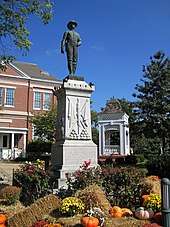
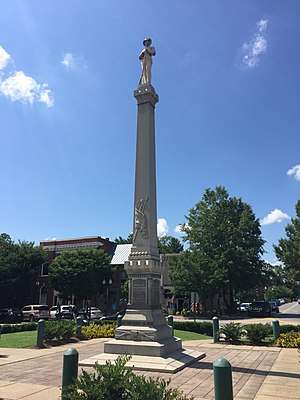

- Blountville: Confederate Memorial (1928)
- Benton: Confederate memorial (2009)[350]
- Blountville: Confederate Memorial (1928)[350]
- Bolivar: Monument to the Memory of Fallen Confederate Sons (1873)
- Brownsville: Confederate Memorial (1909)
- Carthage:
- Charlotte:
- Confederate Monument (2001): "Confederate Veterans Memorial honoring those from Dickson County who served the CSA."
- Confederate Veterans Memorial (2012) "honoring gallant soldiers, veterans and their families."[350]
- Cleveland: Confederate Monument (1911)[30]:191
- Cookeville: Eternal Flame, honors all Putnam County veterans[350]
- Covington: Confederate Monument (1895)[350]
- Decaturville: Confederate Monument[350]
- Dover: Fort Donelson. The Confederate fort was named for CSA General Daniel Smith Donelson but captured by Union General Grant in 1862, who retained the Fort's name saying "Fort Donelson will hereafter be marked in Capitals on the maps of our United Country..." Also contains Confederate Monument donated by United Daughters of the Confederacy in 1933.[351]
- Dresden: Weakley County Confederate Monument (1915)
- Dyersburg:
- Confederate Monument (1905)
- United Confederate Veterans Civil War Plaques (1926)[350]
- Erwin: War Memorial[350]
- Fayetteville:
- Civil War Memorial in memory of the three thousand Confederate soldiers of Lincoln County (1906)
- Women's Monument to those who kept up the responsibilities of farms and businesses during the Civil War (1904)[350]
- Franklin: "Our Confederate Soldiers" Monument (1899), UDC monument known locally as "Chip" memorializes soldiers who died in the Battle of Franklin. Since by state law it cannot be removed, the city of Franklin, with "broad support", wants to install historic markers "depicting the experience of the African-Americans before, during, and after the Civil War." The UDC opposes this, claiming ownership of the Public Square. As of December 2018, the issue is in litigatioN.[352][353]
- Greeneville: John Hunt Morgan Memorial[350]
- Jackson: "Our Confederate Dead" Monument (1888)
- Lafayette: Macon County Confederate Monument (2001)
- Lebanon:
- 1901 monument to the Confederacy
- 2011 memorial to those from the County who served in the Army of Tennessee.
- General Robert Hopkins Hatton marker (1912)[350]
- Lewisburg: Confederate Soldier Monument (1904)
- Manchester: Erected 1991 by United Daughters of the Confederacy.[350]
- McMinnville: Warren County Civil War Memorial (2004)[350]
- Murfreesboro:
- Rutherford County Confederate Memorial (1901)
- Rutherford County Confederate Veterans Memorial (2011)
- Nathan Bedford Forrest Memorial Tablet (1912)
- Nashville: Tennessee Confederate Women's Monument, Belle Kinney Scholz, sculptor (1926)
- Paris: Confederate Monument (1900)
- Pulaski: "Rebel Martyr" Sam Davis Statue (1906)
- Savannah: Confederate Monument (1995)
- Selmer: Confederate Memorial (1994)
- Shelbyville: Confederate Memorial in Memory of the "Shelbyville Rebels" Company F 41st Tennessee Regiment CSA (1937)[30]:205
- Smithville: DeKalb County Confederate Monument (1996)
- Spencer: Confederate Monument (1988)
- Springfield: Confederate Monuments (two monuments) (1997, 2012)[350]
- Trenton: Oakland Cemetery: Confederate Monument commissioned by the United Daughters of the Confederacy in 1900 and Confederate marker commissioned by the Sons of Confederate Veterans in 1990. Listed on the NRHP.[354]
- Union City: Confederate Monument (1869)
- Waynesboro: Confederate Monument (2003)
Other public monuments
- Altamont: Confederate Memorial (1896), depicting flags of the Confederacy[350]
- Beechgrove:
- Nathan Bedford Forrest monument, in Beechgrove Confederate Cemetery.
- Memorial to the 20th Tennessee Volunteer Infantry (2008), in Beechgrove Confederate Cemetery.[350]
- Centerville: Confederate Civil War Memorial Plaque[350]
- Chapel Hill: Obelisk with Confederate flag on the site where Nathan Bedford Forrest was born.[355] There is also "a medallion-shaped monument outside city hall" with a Confederate flag.[355]
- Chattanooga: statue of Alexander P. Stewart, a confederate lieutenant, in front of the Chattanooga/Hamilton County Courthouse. (1919) Efforts have been made to remove this statue.[356]
- Clarksville: Confederate Monument (1893), Greenwood Cemetery[357]
- Clifton: Nathan Bedford Forrest Memorial[350]
- Columbia: Confederate "Funeral Rest" Memorial, Rose Hill Cemetery (1882)[350]
- Cookeville: Confederate Memorial, Cookeville Cemetery (2004)[350]
- Covington: Nathan Bedford Forrest Memorial, Tipton County Museum (1998)[350]
- Crossville: Confederate and Union Memorial[358]
- Denmark: Britton Lane Confederate Monument (1897)
- Dover: Confederate Monument, Fort Donelson (1933)[350]
- Dyersburg: Confederate monument (2004), Old City Cemetery[350]
- Erwin: Confederate Memorial, Ohio Avenue (1903)[350]

- Franklin: Confederal "Funeral Rest" Memorial, Rose Hill Cemetery[350]
- Cannonballs are stacked in a pyramid to commemorate where CSA General Patrick Cleburne died in the Battle of Franklin[359]
- Gallatin: Confederate Soldiers Monument (1903)
- Hamilton County: Chickamauga & Chattanooga National Military Park. Numerous monuments and memorials to Confederate soldiers and units, as well as Union monuments.
- Humboldt: Confederate Monument (1900), Bailey Park
- Knoxville:
- A stone monument was erected in 1914 by the United Daughters of the Confederacy at the corner of 17th Street and Laurel Avenue, in the Fort Sanders neighborhood, defaced in August 2017.[360]
- Civil War Memorial (1901), Knoxville National Cemetery
- Monument to the Confederate dead (1892), Bethel Avenue[350]
- Historical marker, with Confederate flag, in front of Immaculate Conception Church, for Father Abram Ryan, called "Poet of the Confederacy".
- Lebanon:
- Confederate Memorial Gen. Hatton Statue (1912)
- Rutherford County: grounds around the County Courthouse contain a 1901 monument to the Confederacy and a 2011 memorial to those from the County who served in the Army of Tennessee.
- Lynchburg: Confederate Veterans Memorial, Moore County Public Square[350]
- Memphis:
- Mount Pleasant: Confederate Monument (1907)
- Mulberry: Confederate Memorial (1909)
- Murfreesboro: Confederate Circle in Evergreen Cemetery was established in 1891 as a memorial to approximately 2,000 Confederate soldiers whose remains were reinterred there.
- Nashville:
- Confederate Private Monument (1909) in Centennial Park.
- Confederate Gallery, Ryman Auditorium[362]
- Mount Olivet Cemetery had a burial and memorial area established by a ladies group shortly after the Civil War which became known as Confederate Circle.
- The Hermitage: UDC monument and gates (1941) at the Tennessee Confederate Soldiers Cemetery[363]
- Obion: Obion Veterans Memorial, honoring those who were killed in service and were MIA-POW in Civil War, World Wars I & II, Korea, Vietnam, Desert Storm, Afghanistan and Iraq (2006)[350]
- Parkers Crossroads:
- Freeman's Battery (2002)
- Morton's Battery (2007)
- Pulaski:
- Seventh Kentucky Mounted Infantry Memorial (1911)
- Confederate subsection with a Confederate monument dedicated by the United Daughters of the Confederacy in 1913, Maplewood Cemetery.[364]
- Santa Fe: Memorial plaque to Maury [County] Light Artillery (Confederate), public square.[350]
- Tazewell: Confederate memorial (2000) honoring unknown Confederate dead; located in Irish Memorial Cemetery.[350]
- Trimble: Cemetery Ridge Memorial Plaza, honoring Merion Spence Parks and Williams Hamilton Parks II, members of UDC and SCV respectively (2012)[350]
- Union City
- Winchester
- UDC Memorial to Confederate soldiers (1950), City Cemetery
- SCV Memorial to Confederate soldiers (2003), Confederate Cemetery, adjoining the City Cemetery"[350]
- Woodbury: 1926 monument "honors all confederate soldiers and marks the spot where CSA Lt. Col. John B. Hutchenson was killed."[350]
Private monuments
- Nashville
- Nathan Bedford Forrest Statue, made of fiberglass over foam, 25 feet high, on private land[365] near Interstate 65, installed in 1998, built with private money. It is surrounded by Confederate battle flags, constituting what the owner calls "Confederate Flag Park." (No government recognizes it as a park, and the entrance is chained shut with a "No Trespassing" sign.) The giant statue is visible from the highway to anyone entering the city from the south.[366] It has been called "hideous"[366] and "ridiculous."[367] There have been numerous calls for its removal. Tennessee Governor Bill Haslam said: "It's not a statue that I like and [ sic ] that most Tennesseans are proud of in any way."[368] Former Nashville Mayor Megan Barry called the statue "an offensive display of hatred."[368] In 2015, Nashville's Metro Council voted to petition the Tennessee Department of Transportation to plant obscuring vegetation;[369] the Department declined, because it is private land.[366] ("Never mind that the T.D.O.T. itself removed the obscuring vegetation back in 1998, when the statue was first erected."[366][368]) There has been occasional vandalism; in December 2017 it was covered in "pussy-hat pink" paint,[366] which Bill Dorris, current owner of the land, says he intends to leave.[370] He also said that if trees are planted to block the view from I-65, he "would make the statue taller."[365] It was sculpted, at no charge, by notorious racist Jack Kershaw, an attorney for Martin Luther King's murderer, famous for having said "Somebody needs to say a good word for slavery."[371][372]
Inhabited place
- Dixie Lee Junction, an unincorporated community where the Dixie and Lee Highways intersect.
Parks
- Eva: Nathan Bedford Forrest State Park (1963)
- Franklin: Confederate Memorial Park at Winstead Hill Park
Roads
- Brentwood
- Jefferson Davis Drive
- Robert E. Lee Lane
- Culleoka: General Lee Road
- Dandridge
- Jeb Stuart Drive
- Stonewall Jackson Drive
- Elizabethton: Stonewall Jackson Drive
- Eva: Jeff Davis Drive
- Forest Hills: Robert E. Lee Drive
- Franklin:
- General J.B. Hood Drive
- General Nathan Bedford Forrest Drive
- Jeb Stuart Drive
- Jefferson Davis Drive
- Gallatin: Robert Lee Drive
- Nashville:
- Beauregard Drive
- Jefferson Davis Drive
- Confederate Drive
- General Forrest Court
- Robert E. Lee Court
- Robert E. Lee Drives (two different streets with the same name)
- Newport
- Robert E. Lee Drive
- Stonewall Jackson Driv
- Oak Hill: Stonewall Jackson Court
- Pulaski
- Sam Davis Avenue
- Sam Davis Trail
- Sardis: Jeff Davis Lane
- Smyrna
- Jeb Stuart Drive
- Lee Lane[73]
- Longstreet Drive
- Robert E. Lee Lane
- Sam Davis Road
- Stonewall Drive
Schools
- Chapel Hill: Forrest High School
- Nashville: Father Ryan High School, named for Abram Ryan, called "Poet of the Confederacy".
- Paris: Robert E. Lee School
- Sewanee: The University of the South: "Nowhere is the issue of Confederate remembrance more nettlesome than at Sewanee, whose origin[s] are entwined with the antebellum South and the Confederacy."[373] Confederate flags are in stained glass windows of the chapel, as is the Seal of the Confederacy.[373] It benefited greatly at its founding by a large gift from John Armfield, at one time co-owner of Franklin and Armfield, the largest and most prosperous slave trading enterprise in the country. Students as late as 1871 were required to wear uniforms of "cadet gray cloth".[374] Confederate flags hung in the chapel from its dedication in 1909 until the mid-1990s when they were removed "reportedly to improve acoustics".[375] There is an official portrait hanging at the University of Bishop Leonidas Polk, "an ardent defender of slavery,"[373] who was in charge of the celebration of the cornerstone laying in 1857, and said the new university will "materially aid the South to resist and repel a fanatical domination which seeks to rule over us."[376] He resigned his ecclesiastical position to become a major general in the Confederate army (called "Sewanee's Fighting Bishop"), and died in battle in 1864. His official portrait at the University depicts him dressed as a bishop with his army uniform hanging nearby. However, his portrait was moved from Convocation Hall to Archives and Special Collections in 2015.[377] The Confederate flag was also emblazoned on the university mace that led processions marking the beginning and ending of the term from 1965 until 1997. At a special chapel service to celebrate Jefferson Davis' birthday, the Ceremonial Mace was consecrated to the memory of Nathan Bedford Forrest, the first Grand Wizard of the Ku Klux Klan, by Bishop Charles C. J. Carpenter of Alabama – one of the clergy who opposed Dr. Martin Luther King Jr.'s activities in Birmingham in 1963 (see A Call for Unity), prompting King to write his "Letter from a Birmingham Jail" in response.[375]
- The Vice Chancellor is the chief academic officer at the university; the chancellor is a bishop of the Episcopal church. Jefferson Davis and Robert E. Lee both turned down offers of the position.[378] (Sewanee has a portrait of Davis.[379]) The first vice chancellor was Rt. Rev. Charles Todd Quintard, called "chaplain of the Confederacy". He compiled the Confederate Soldiers' Pocket Manual of Devotions (Charleston, 1863).[380]
- The university's chief donor was John Armfield, at the time co-owner of Franklin and Armfield, the largest slave-trading firm in the U.S. He purchased the site and gave the university an endowment of $25,000 a year. In addition to Polk, Bishop Stephen Elliott, the first and only Presiding Bishop of the Protestant Episcopal Church in the Confederate States of America, and Bishop James Hervey Otey, later prominent in the Confederacy, were significant founders of the university. Generals Edmund Kirby Smith, Josiah Gorgas, and Francis A. Shoup were prominent in the university's postbellum revival and continuance.
- Tullahoma: Robert E. Lee Elementary (1964)

- Vanderbilt University:
- Calhoun Hall, named for William Henry Calhoun, a slave owner, Odd Fellows Grand Master and silversmith who was arrested for his Confederate support on the order of Union Brigadier General Robert Byington Mitchell pending the release of Union prisoners in 1863.[381][382]
- Portrait of Confederate General Edmund Kirby Smith by Cornelius Hankins in the Wyatt Center.[383] Smith served as the chancellor of the University of Nashville from 1870 to 1875.[383]
- Marble bust of Confederate Colonel and Board of Trust Treasurer Edmund William Cole in Kirkland Hall, the administration building.[384] He is also the namesake of the annual Cole Lecture.[385]
- The campus includes several buildings tied to slavery and the Confederacy, like McTyeire Hall (named for pro-slavery essayist Holland Nimmons McTyeire) and Elliston Hall (named for Elizabeth Boddie Elliston of the Burlington Plantation, who owned slaves).[386][387][388]
Theme park
- Pigeon Forge: "Rebel Railroad" was a small theme park built in 1961, its main attraction being a simulated Confederate steam train which afforded "'good Confederate citizens' the opportunity to ride a five mile train route through 'hostile' territory and to help repel a Yankee assault on the train". Rebel Railroad was purchased in 1970 by Art Modell, owner of the Cleveland Browns.[389][390][391] In 2018 it is operating under the name Dollywood.
Texas
As of 24 June 2020, there are at least 205 public spaces with Confederate monuments in Texas.[73][392] "Nowhere has the national re-examination of Confederate emblems been more riven with controversy than the Lone Star State."[393]
State capitol
- "The Texas Capitol itself is a Confederate monument," according to then-Land Commissioner Jerry E. Patterson.[394] The Texas Confederate Museum was once housed in the Capitol.
- Confederate Soldiers Monument (1903) features four bronze figures representing the Confederate artillery, cavalry, infantry, and navy. A bronze statue of Jefferson Davis stands above them.[395] The inscription reads: "Died for state rights guaranteed under the constitution. The people of the South, animated by the spirit of 1776, to preserve their rights, withdrew from the federal compact in 1861. The North resorted to coercion. The South, against overwhelming numbers and resources, fought until exhausted."[396]
- Hood's Texas Brigade, a monument "to memorialize those [who] fought for the Confederacy".[397] "The monument includes a depiction of a Confederate soldier, quotes by Confederate leaders, a flag of the Confederacy and the Confederate battle flag."[398] These are the only Confederate flags currently (2017) visible in the Capitol.[399] Representative Eric Johnson has called for its removal.[398]
- Terry's Texas Rangers Monument, a monument "to memorialize those [who] fought for the Confederacy"[397] (1907).
State symbols
- The reverse side of the Seal of Texas (1992) includes "the unfurled flags of the Kingdom of France, the Kingdom of Spain, the United Mexican States, the Republic of Texas, the Confederate States of America, and the United States of America". The Confederate flag is rendered as the Stars and Bars.
State holiday
- Confederate Heroes Day is celebrated on January 19. State employees have the day off.
- April is Confederate History Month in Texas.[400]
Buildings
- Austin
- The John H. Reagan state office building is located at 1400 Congress.[397]
Monuments
Many monuments were donated by pro-Confederacy groups like Daughters of the Confederacy. County governments at the time voted to accept the gifts and take ownership of the statues.[401][402]
Courthouse monuments
- Alpine: Confederate Colonel Henry Percy Brewster (1963)[403]
- Aspermont: Historical marker, "County Named for Confederate Hero Stonewall Jackson", Stonewall County Courthouse (1963)
- Bastrop: Monuments at Bastrop County Courthouse include:
- Confederate Soldiers' Monument (1910)[404]
- Historical marker, "Home Town of Texas Confederate Major Joseph D. Sayers" (1963)[405]
- Bay City: Confederate Soldiers' Monument (1913), Matagorda County Courthouse[406][407]
- Belton: Confederate Soldiers' Monument, Bell County Courthouse[408]
- Bonham: Confederate Soldiers' Monument (1905), Fannin County Courthouse[409]
- Bryan: Commemorative marker, erected 1965, to the Brazos County Confederate Commissioners Court.[410]
- Comanche: Confederate Soldiers' Monument (2002), Comanche County Courthouse[411]
- Corsicana: Call to Arms (Confederate Soldiers' Monument), by Louis Amateis (1907), Navarro County Courthouse.[412][413] A Civil War bugler stands in uniform holding a bugle to his mouth with his proper right hand. He holds a sword in his proper left hand at his side. He wears a hat with a feather in it and knee-high boots. A bedroll is slung over his proper left shoulder and strapped across his chest and proper right hip. The sculpture is mounted on a rectangular base.[414] "Isaac O'Haver was a member of Co K of the 17th VA Cavalry. He was a 17 year-old bugler for his unit. He was born Sep. 20, 1844 and died at the age of 27 on March 30, 1872. He is buried at the Ladoga Cemetery."[415] The plaques on the monument read:
- South side: The Call to Arms Erected 1907 by Navarro chapter United Daughters of the Confederacy To commemorate the valor and heroism of our Confederate Soldiers It is not in the power of mortals to command success The Confederate Soldier did more - he deserved it. "But their fame on brightest pages penned by poets and by pages Shall go sounding down the ages"
- West side: "Nor shall your glory be fought while fame her record keeps or honor points the hollowed spot where valor proudly sleeps" "Tell it as you may It never can be told Sing it as you Will It never can be sung The Story of the Glory of the men who wore the gray"
- East side: "It is a duty we owe the dead who died for us: - But where memories can never die - It is a duty we owe to posterity to see that our children shall know the virtues And rise worthy of their sires".
- North side: The soldiers of the Southern Confederacy fought valiantly for The liberty of state bequeathed them By their forefathers of 1776 "Who Glorified Their righteous cause and they who made The sacrifice supreme in That they died To keep their country free"[414]
- Clarksville: Confederate Soldiers' Monument, Red River County County Courthouse[416]
- Denton: Denton Confederate Soldier Monument, Denton County Courthouse.[417] Cost $2,000; a project of the Denton Chapter, UDC. Dedicated June 3, 1918, Jefferson Davis's birthday.[418] It had "whites only" drinking fountains on each side.[419] In 2015 it was defaced with the words "THIS IS RACIST" in red paint.[420] The twenty-year campaign of a Denton resident, Willie Hudspeth, to have the monument removed was the subject of a Vice news video in 2018.[419] After the wave of Confederate monument removals that followed the 2017 Unite the Right rally in Charlottesville, Virginia, and in large part as a result of Hudspeth's campaign, a county 15-person Confederate Memorial Committee met for three months in 2017–18 and recommended "adding context" — two video kiosks and a large plaque, "with interviews about local veterans and the history of slavery"[421] — to the monument rather than removing it, a suggestion accepted unanimously by the county commissioners. Once the nature of the historical context has been determined, approval of the Texas Historical Commission will be required.[422] As of September, 2018, "the county still does not have a timeline for completing the project and...there were no updates to report".[423] The video caught the attention of Kali Holloway, director of the Make It Right Project, which is working to remove Confederate monuments. She added the Denton monument to the group's "top 10 list" of monuments they consider priorities.[222][423]
- Fort Worth: Monument to "Confederate Soldiers and their Descendents" (1953), Tarrant County Courthouse[424]
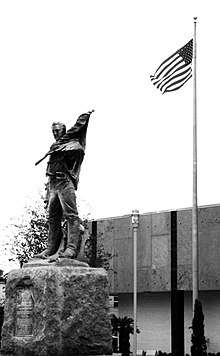
- Galveston: Dignified Resignation (1909) by Louis Amateis at the Galveston County Courthouse. With his back turned to the US flag while carrying a Confederate flag, it is the only memorial in Texas to feature a Confederate sailor.[425][426] It was "erected to the soldiers and sailors of the Confederate States of America." An inscription on the plaque reads, "there has never been an armed force which in purity of motives intensity of courage and heroism has equaled the army and navy of the Confederate States of America."[396]
- Gainesville: Confederate Soldiers' Monument, Cooke County Courthouse (1911)[427][428]
- Georgetown: Confederate Soldiers and Sailors Monument, Williamson County Courthouse (1916)
- Goldthwaite: Confederate Soldiers' Monument, Mills County Courthouse[429]
- Granbury: Statue of CSA General Hiram B. Granbury (1913), killed in the Battle of Franklin (1913), Hood County Courthouse. Erected by UDC.[430]
- Hillsboro: Confederate Soldiers' Monument, Hill County, Texas Courthouse[431]
- Jefferson: Confederate Soldiers' Monument (1907, moved to the courthouse in the 1930s), Marion County Courthouse[432][433]
- Linden: Confederate Monument (1903), Cass County Courthouse[434]
- Livingston: Confederate Soldiers' Monument, Polk County Courthouse[435]
- Llano: Confederate Soldiers' Monument, Llano County Courthouse[436]
- Lockhart: Confederate Soldiers' Monument, Caldwell County Courthouse[437]
- Longview: Confederate Soldiers' Monument (1911), Gregg County Courthouse[438][439]
- Mount Pleasant: Confederate Soldiers' Monument (1912), Titus County Courthouse[440][441]
- Memphis: Confederate Soldiers' Monument, Hall County Courthouse[442]
- Marshall: Confederate Soldiers' Monument (1906), Harrison County Courthouse[443]
- New Braunfels: Confederate Soldiers' Monument (1937), Comal County Courthouse[444]
- Paris: Confederate Soldiers' Monument, Lamar County Courthouse[445]
- Confederate Soldiers' Monument, Kaufman, Kaufman County Courthouse[446]
- Perryton: Courthouse monument to CSA colonel William Beck Ochiltree[447]
- Rusk: Confederate Soldiers' Monument, Cherokee County Courthouse[448]
- Sherman: Confederate Soldiers' Monument (1896), Grayson County Courthouse. This was the first Confederate statue dedicated at a county courthouse in Texas.[449]
- Snyder: marker (1963) commemorating William Read Scurry, Scurry County Courthouse[450]
- Stephenville: Confederate Soldiers' Monument (2001), Erath County Courthouse[451]
.jpg)
- Texarkana: The Confederate Mothers Monument (1918), located in Texas near the state line with Arkansas, is shared by the US District Court in Texarkana, Texas, and the US Post Office and Courthouse in Texarkana, Arkansas[452][453]
- Vernon: Confederate Soldiers' Monument, Wilbarger County Courthouse [454]
- Weatherford: Confederate Soldiers' Monument (1929), Parker County Courthouse[455]
- Waxahachie: Confederate Soldiers' Monument (1912), Ellis County Courthouse[456][457]
Other public monuments
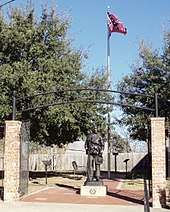
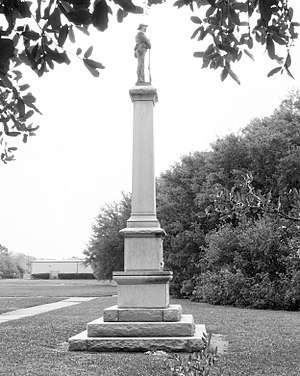
- Alpine: CSA Gen. Lawrence "Sul" Ross Monument (1963)
- Amarillo: Confederate Soldier Statue (1931)[425]
- Anderson: Confederate Memorial Plaza (2010).[458] The plaza beside the Grimes County courthouse flies a Confederate flag behind a gate with metal lettering reading "Confederate Memorial Plaza." A metal statue depicts one of several Grimes County residents who fought with the 4th Texas volunteer infantry brigade in Virginia.[396]
- Athens: Henderson County Confederate Monument (1964)
- Austin:
- Hood's Texas Brigade Monument, Texas State Capitol
- Littlefield Fountain, University of Texas, commemorates George W. Littlefield, a university regent and CSA officer. An inscription reads, "To the men and women of the Confederacy who fought with valor and suffered with fortitude that states [sic] rights be maintained."
- Texas Confederate Women's and Men's Historical Markers, at 3710 Cedar St. and 1600 W. Sixth, commemorate campgrounds built to house and care for widows, wives, and veterans of the Confederacy.[397]
- Beaumont: "Our Confederate Soldiers" Monument (1912)
- Clarksville: Confederate Soldier Monument (1912)
- Cleburne: Cleburne Monument (2015) Confederate Arch (1922)
- Coleman: Hometown of Texas CSA Col. James E. McCord Monument (1963)
- College Station: A statue of Lawrence Sullivan Ross, Confederate general and former president of A&M University is located on the campus of Texas A&M University. In August 2017 the Chancellor of the university, John Sharp, confirmed that the university will not be removing the statue from the campus.[459]
- Corpus Christi: Queen of the Sea (1914; restored 1990), bas-relief by Pompeo Coppini; UDC-sponsored Confederate memorial featuring an allegorical female figure – representing Corpus Christie – holding keys of success while receiving blessings from Mother Earth and Father Neptune, who are standing next to her.[425] "Coppini was abhorrent of war", and in Queen of the Sea "he crafted a sculpture that symbolized peace and captured the spirit of Corpus Christi".[460]
- El Paso:
- Hometown of Texas CSA Capt. James W. Magoffin Monument (1964)
- CSA Maj. Simeon Hart Monument (1964)
- Farmersville: Confederate Soldier Monument (1917), Farmersville City Park[461]
- Fort Worth: Confederate Soldier Memorial (1939), Oakwood Cemetery[425]
- Gainesville Confederate Heroes Statue (1908) in Leonard Park[462][463]
- Gonzales: Confederate Soldiers' Monument, Confederate Square. Dedicated on June 3, 1909. To "our Confederate dead."[464][465]
- Greenville: Confederate Soldier Monument (1926)
- Holliday: Stonewall Jackson Camp 249 Monument (1999)
- Houston:
- Spirit of the Confederacy (1908, in present location since 1925), by Louis Amateis.[425] Erected by United Daughters of the Confederacy.[466]
- Statue of Richard W. Dowling, located at the entrance to Hermann Park. Erected in 1905, the monument was in front of City Hall until 1958, when it was moved to its present location. In August 2017 Andrew Schneck was arrested at the statue with bomb materials.[467]
- Kermit: Col. C.M. Winkler Monument (1963)
- Marshall:
- Confederate Capitol of Missouri Monument (1963)
- Confederate Monument (1906)
- Home of Last Texas Confederate Gov. Pendleton Murrah Monument (1963)
- Miami: Col. O.M. Roberts Monument (1963)
.jpg)
- Palestine: John H. Reagan Memorial (1911) by Pompeo Coppini[425]
- Sabine Pass: Sabine Pass Battleground State Historic Site. Where the Sabine River enters the Gulf of Mexico, 47 Confederate men held off a large Union attack, destroying two Union boats and capturing hundreds of prisoners. Today the site is managed by the Texas Historical Commission, and it hosts battle reenactments in honor of the Confederate soldiers.
- Sherman: Confederate Soldier Monument (1897)
- Tomball: Confederate Powder Mill Marker Monument (1966)
- Victoria: Confederate Monument (1912). Pompeo Coppini's statue, called The Last Stand, and sometimes The Firing Line, sits in De Leon Plaza. The inscription reads: "On civilization's height / Immutable they stand". The $5,000 cost was raised by the United Daughters of the Confederacy.
Private monuments

- Austin: Confederate monument, Oakwood Cemetery. Erected in 2016 by the Sons of Confederate Veterans.[468]
- Belton: Monument to Confederate Sargeant Jacob Hemphill. Erected 2016 by Sons of Confederate Veterans.[469]
- Crowley: "Confederate Veterans Memorial Monument honoring The Confederate Veterans of Crowley and the surrounding area interred at the Crowley Cemetery." Erected 2011 by the Sons of Confederate Veterans.[469]
- Hempstead: The Liendo Plantation was a center for Confederate recruiting efforts and held Union prisoners during the war. Now it holds battle reenactments and demonstrations of Civil War era Confederate life at its annual Civil War Weekend.
- Orange: The Confederate Memorial of the Wind, located on Martin Luther King Jr. Drive, but visible from I-10, has been under construction since 2013, and will be the largest Confederate monument built since 1916, according to the Sons of Confederate Veterans.[393] A center stone ring is held aloft by 13 pillars, one for each state that seceded. There are twenty commemorative flagpoles.
- Palestine: Confederate Veterans Memorial Plaza (2013), funded by the Sons of the Confederate Veterans[470]
Inhabited places
Counties
- Brewster County (1887) named for Henry Percy Brewster
- Culberson County (1911) named for CSA Lieutenant Colonel David B. Culberson
- Donley County (1882) named for Stockton P. Donley, a lawyer who enlisted in the Confederate Army. Just after the war in 1866, he was elected to the Supreme Court of Texas, but was removed by the Reconstruction military government.
- Ector County (1891) named for CSA General Mathew Ector, who later served as a judge.
- Foard County (1891) named for Robert L. Foard, an attorney and Confederate Major.[471]
- Gray County (1902) named for Peter W. Gray, a lawyer and legislator who attended the 1861 Texas State Secession Convention, and voted to leave the union. Shortly after, Gray was elected to the Confederate House of Representatives.
- Gregg County (1873) named for CSA General John Gregg, who was a delegate to the Texas Secession Convention in 1861 and was elected to represent Texas in the Provisional Confederate Congress in Montgomery, Alabama, and later in Richmond, Virginia. He was killed in action at the Siege of Petersburg in 1864.
- Hemphill County and Hemphill city (1877) named for John Hemphill, Chief Justice of the Texas Supreme Court from 1841 to 1858 until he was elected to the US Senate when Sam Houston refused to support secession. He was expelled from the Senate when Texas seceded in 1861 and then represented Texas in the Provisional Confederate Congress.
- Hood County (1866) named for CSA General John Bell Hood
- Jeff Davis County (1887) named for Jefferson Davis.
- Lee County (1874) named for Robert E. Lee.
- Lubbock County named for CSA colonel Thomas Saltus Lubbock
- Madison County: In 2020 County Commissioners designated April as Confederate History and Heritage Month.[400]
- McCulloch County, for CSA general Benjamin McCulloch
- Ochiltree County (1889) named for secessionist politician William Beck Ochiltree.
- Oldham County (1881) named for William Simpson Oldham Sr., a Confederate politician.
- Randall County (1889) named for CSA Brig. Gen. Horace Randal.
- Reagan County (1903) named for CSA Postmaster General John H. Reagan.
- Reeves County (1884) named for CSA officer George R. Reeves.
- Roberts County (1889) named for Oran Milo Roberts, who was unanimously elected president of the 1861 Secession Convention, a meeting that he had been influential in calling. In 1862 he resigned the Supreme Court seat and was elected colonel of the Eleventh Texas infantry in the Confederate Army. He was Governor of Texas from 1879 to 1883.
- Scurry County (1884) named for secessionist and CSA Gen. William Read Scurry.
- Starr County Confederate official James Harper Starr
- Stephens County, originally Buchanan County, for U.S. President James Buchanan, in 1861 was renamed for CSA Vice-President Alexander Stephens.
- Stonewall County (1888) named for CSA General Stonewall Jackson.
- Sutton County (1890) named for CSA officer John S. Sutton.
- Terrell County (1905) named for CSA acting General Alexander W. Terrell.
- Terry County (1904) named for CSA Col. Benjamin Franklin Terry .
- Tom Green County (1875) named for CSA Brig. Gen. Thomas Green, KIA (killed in action).
- Upton County (1910) named for brothers John C. and William F. Upton, both colonels in the Confederate Army.
- Val Verde County (1885) Confederate victory in the Battle of Val Verde
- Winkler County (1910) named for CSA Col. Clinton M. Winkler.
Municipalities
- City of Cleburne (1871)
- City of Fort Davis: named for Jefferson Davis.
- City of Granbury (1887)
- City of Hemphill: named for judge and Confederate politician John Hemphill (see Hemphill County as well)
- City of Robert Lee
- City of Stonewall: named for Stonewall Jackson.
Museums
- Columbus: Confederate Memorial Museum. Located in an unusual building, built in 1883, that formerly was the town's water tower, and in the base its Fire Station. It is a Recorded Texas Historic Landmark. Curated by UDC, which purchased the building from the town in 1926, when its water system was modernized and the unneeded tower building put up for sale.[472] According to the UDC it holds a collection of artifacts from Civil War soldiers of Columbus and Colorado County. It is a Recorded Texas Historic Landmark, dedicated, according to UDC, to the veterans of all wars, although the museum holds only Confederate artifacts.[473]
- White Settlement: Texas Civil War Museum, opened 2006. It is pro-Confederacy,[474] and the UDC has permanently one of the three seats on its board. Has material from the former Texas Confederate Museum in Austin, which closed in 1988.
Parks
- Davis Mountains State Park (1938) named for the mountain range
- Davis Mountains (geographic feature in West Texas around and named for Fort Davis)
- Fort Worth: Jefferson Davis Park.[475]
- Holliday: Stonewall Jackson Campground
- Lakeside, Tarrant County: Confederate Park. The two Confederate flags displayed on each side of the park's marker were removed by the Texas Department of Public Transportation in 2017. Marker text:{{quote|Site of Confederate Park // Local businessman Khleber M. Van Zandt organized the Robert E. Lee Camp of the United Confederate Veterans in 1889. By 1900 it boasted more than 700 members. The Club received a 25-year charter to create the Confederate Park Association in 1901, then purchased 373 acres (151 ha) near this site for the "recreation, refuge and relief of Confederate soldiers" and their families. Opening events included a picnic for veterans and families on June 20, 1902, and a statewide reunion September 8–12, 1902, with 3,500 attendees. The park thrived as a center for the civil and social activities on Texas Confederate organizations. By 1924 the numbers [ sic ] of surviving veterans had greatly diminished, and the Confederate Park Association dissolved when its charter expired in 1926.[475]
- Limestone County: Confederate Reunion Grounds State Historic Site
- Palestine: John H. Reagan Park
Roads
- Austin:
- In July, 2018, at approximately the same time that Robert E. Lee Road and Jeff Davis Avenue were renamed, the city's Equity Office recommended changing the names of seven more streets:
- Littlefield Street. Commemorates George W. Littlefield, a CSA officer.[476]
- Tom Green Street[476]
- Sneed Cove, named for Richard A. Sneed, Confederate soldier and co-founder of the Ku Klux Klan.[476]
- Reagan Hill Drive[476]
- Dixie Drive[476]
- Plantation Road[476]
- Confederate Avenue[476]
- In July, 2018, at approximately the same time that Robert E. Lee Road and Jeff Davis Avenue were renamed, the city's Equity Office recommended changing the names of seven more streets:
- Conroe:
- Beauregard Drive
- Jubal Early Lane
- Stonewall Jackson Drive
- El Paso: Robert E. Lee Road
- Hamilton: Stonewall Jackson Road
- Hillsboro: Confederate Drive
- Hemphill:
- Confederate Street
- Stonewall Street
- Holliday: Stonewall Road
- Houston:
- Robert E. Lee Road
- Robert Lee Road
- Tuam Street, a major artery named for CSA Gen. Dowling's birthplace, Tuam, Ireland.
- Hunt: Robert E. Lee Road
- Jacksonville: Jeff Davis Street
- Kermit East Winkler Street
- Lakeside Confederate Park Road
- League City: Jeb Stuart Drive
- Levelland: Robert Lee Street
- Liberty: Confederate Street
- Livingston: Robert E. Lee Road
- Marshall:
- Jeff Davis Street
- Stonewall Drive
- Missouri City
- Beauregard Court
- Bedford Forrest Drive
- Breckinridge Court
- Confederate Drive
- Pickett Place
- Richmond:
- Jeb Stuart Drive
- Jeff Davis Drive
- Stonewall Drive
- Ridgley: Bedford Forrest Lane
- Roma: Robert Lee Avenue
- San Antonio:
- Beauregard Street
- Robert E. Lee Drive
- Sterling City: Robert Lee Highway
- Sweetwater: Robert Lee Street
- Tyler:
- Jeb Stuart Drive
- Jeff Davis Drive
- Victoria: Robert E. Lee Road
Note: "There are similarly named streets in towns and cities across east Texas, notably Port Arthur and Beaumont, as well as memorials to Dowling and the Davis Guards, not least at Sabine Pass, where the battleground is now preserved as a state park"
Schools
- Abilene:
- Jackson Elementary School
- Johnston Elementary School
- Lee Elementary School (1961)[73]
- Amarillo:
- Lee Elementary School (was renamed Park Hills Elementary School in 2019)[73]
- Tascosa High School. Confederacy iconography was dropped in 1974. The school dropped its mascot, Johnny Reb, and stopped playing "Dixie" as their fight song. The Dixieland Singers became the Freedom Singers. Miss Southern Belle became Tascosa Belle. The "Rebel" nickname remained, but other ties to the Civil War disappeared.[477]
- Austin:
- John H. Reagan Early College High School (1965)
- William B. Travis High School, home of the "Rebels".[478] Dropped "Dixie" as its song in 2012.[479]
- Zachary Taylor Fulmore Middle School
- Sidney Lanier High School: Sidney Lanier, poet of the Confederacy, was a private in the Confederate Army.[480]
- Johnston High School: Named for Albert Sidney Johnston, Confederate general killed in the Battle of Shiloh. The school closed in 2008; Eastside Memorial High School is now (2017) at that location.[480]
- Bryan:
- Sul Ross Elementary School: Named for Lawrence Sullivan Ross, Confederate general and former president of Texas A&M University.[481]
- Buda:
- Jack C. Hays High School. The school uses the "Rebel" nickname for its athletic teams.[482] Mascot "Colonel Jack" no longer has a Confederate flag belt buckle but still dresses in grey. The school dropped the Confederate flag as an official symbol in 2010 and the school district banned it from all district property in 2012.[483] In 2015 it replaced the school song "Dixie".
- Baytown:
- Lee College (1934)
- Lee High School (1928)
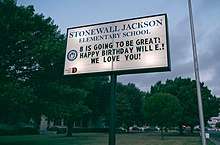
- Dallas:
- Albert Sidney Johnston Elementary School
- John H. Reagan Elementary School
- Robert E. Lee Elementary School
- Stonewall Jackson Elementary School (1939)
- Sidney Lanier Expressive Arts Vanguard Elementary School
- Denton: Lee Elementary School (1988), renamed Alice Moore Alexander Elementary School in 2017[73]
- Eagle Pass: Robert E. Lee Elementary School
- Edinburg: Lee Elementary School[73]
- El Paso: Lee Elementary School[73]
- Evadale: Evadale High School. The school uses a Confederate flag-inspired crest. Its athletic teams are nicknamed the "Rebels".[484]
- Fort Davis:
- Fort Davis AEC School
- Fort Davis High School
- Gainesville: Robert E. Lee Intermediate School
- Grand Prairie: Robert E. Lee Elementary School (1948)
- Houston:
- Davis High School (1926). In 2016, the Houston school board voted to rename the school.[485]
- Dowling Middle School (1968), named for CSA Maj. Richard W. Dowling. In 2016, the Houston school board voted to rename the school.[485]
- Sydney Lanier, Confederate poet and soldier. In 2016, the Houston school board voted to rename the school.[485]
- John H. Reagan High School (1926). In 2016, the Houston school board voted to rename the school.[485]
- Johnston Middle School (1959), named for Albert Sidney Johnston. In 2016, the Houston school board voted to rename the school.[485]
- Marshall: Robert E. Lee Elementary School
- Midland:
- Lee Freshman High School (1961)
- Lee High School (1961). The school's athletic teams are nicknamed the "Rebels". Lee High School had used the Confederate flag in the past.[486]
- North Richland Hills, home of the Richland High School "Rebels" and "Dixie Belles". The school mascot is "Johnny Rebel".[487]
- Port Arthur: Lee Elementary School (1959)[73]
- Robert Lee:
- Robert Lee Elementary School
- Robert Lee High School
- Rosenberg: B. F. Terry High School. Named for Confederate hero Benjamin Franklin Terry.
- San Angelo: Lee Middle School (1949)[73]
- San Antonio: Robert E. Lee High School (1958). After voting against a name change in 2015, the school board voted in August 2017 to change the name of the school.[488] In October, district trustees voted 5-2 to name the school Legacy of Educational Excellence, or LEE High School.[489] Its mascot is currently the Volunteer and the school colors are red and grey. Its pep squad, currently called the Southern Belles, were once called the Confederates. Its varsity dance team and junior varsity drill team are respectively named the Rebel Rousers and Dixie Drillers.[396]
- Stonewall: Stonewall Elementary School
- Tyler:
- Hubbard Middle School (1964), named for Confederate Col. Richard B. Hubbard
- Robert E. Lee High School (1958). Called "the city's most radioactive Confederate symbol," the possible renaming of the school was the subject of active discussion at meetings in August and September, 2017. In 1970, as a result of a statewide federal desegregation order, the school had to get rid of "its Confederate-themed mascot (the Rebels), fight song ("Dixie"), and prized Confederate flag (so large that it required twenty boys to carry). Its beloved Rebel Guard, a squadron of boys handpicked by an American-history teacher to dress in replica Confederate uniforms at football games and fire a cannon named Ole Spirit after touchdowns, had to find a new name. Same for the Rebelettes drill team."[490]
Other memorials
- Granbury: The city holds an annual General Granbury's Birthday Bash dedicated to Confederate General Hiram B. Granbury
Utah
- Dixie, a region of Washington County, Utah; The first President of the Washington Stake was Robert Dockery Covington, a slave owner from North Carolina and Mississippi. There were other Southern settlers; crops such as tobacco and cotton would grow there.[491]
- Dixie State University, St. George, Utah.
Vermont
Virginia
As of 24 June 2020, there are at least 241 public spaces with Confederate monuments in Virginia,[73] more than in any other state.[492][493] Virginia also has numerous schools, highways, roads and other public infrastructure named for Confederates. Lee-Jackson Day is no longer a State holiday.
Washington State
As of 24 June 2020, there are at least 2 public spaces with Confederate monuments in Washington.[73]
- Bellingham: Pickett House, listed on the National Register of Historic Places.
.jpg)
At least two private properties contain a Confederate memorial or fly a CSA flag:
- Clark County: Near Ridgefield is Jefferson Davis Park (2007), established by the SCV to hold the Jeff Davis Highway markers from Blaine and Vancouver. Flags of the Confederacy are also displayed there.[494][495]
- Seattle: United Confederate Veterans Memorial, Lake View Cemetery. Erected in 1926 by United Daughters of the Confederacy.[496]
- The monument has been vandalized repeatedly. In 2005, "the flag insignia, bayonets, and a plaque with Robert E. Lee on it were stolen, but then restored".[497] Following the Charleston church shooting of 2015, "Fuck White Supremacy" was painted on it. On July 5, 2018, "several parts of the 10-ton piece of granite [were] smashed, including a portion of the monument's inscription, insignia, and relief of Robert E. Lee."[498]
- Also in 2015, a petition was started to have it removed.[499] In 2017 Seattle Mayor Ed Murray called for it to be taken down, saying it represents "historic injustices" and is a symbol of hate, racism, and violence. After the Mayor's statement, the Cemetery closed for several days because of threats related to the monument.[500]
- In October, 2018, the Make It Right Project put up a billboard in Seattle, saying: "Hey Seattle, there's a Confederate Memorial in your backyard".[501]
West Virginia
As of 2020 there were 21 public spaces with Confederate monuments in West Virginia.[73]
State capitol
- Bust of Stonewall Jackson (born in West Virginia, at that time part of Virginia) by Bryant Baker, located "in the rotunda of the West Virginia State Capitol." (1959)[502]
- Statue of Stonewall Jackson by Moses Ezekiel[503] on the State Capitol grounds (1910) placed by UDC Chapter No. 151[504][505]
Monuments
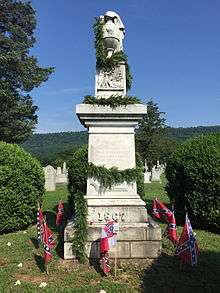
- Bunker Hill, West Virginia: Monument marking the death of Brig.-Gen. James Johnston Pettigrew, wounded on July 14, 1863, near Falling Waters during the retreat after the Battle of Gettysburg. He died at Edgewood on July 17, 1863.[506]
- Clarksburg: Bronze equestrian statue of Stonewall Jackson created by Charles Keck (1953) by the United Daughters of the Confederacy (UDC). Jackson was born in Clarksburg.
- Charles Town: Portraits of Lee and Jackson hang in the courtroom in which John Brown was tried and sentenced to death.[507]
- Charleston - See West Virginia State Capitol, above.
- Harpers Ferry: Heyward Shepherd Monument (1931). Although Shepherd was a black freeman working for the railway when killed in John Brown's raid on Harper's Ferry, the monument was erected by UDC and Sons of Confederate Veterans (SCV). They called the project the "Faithful Slave Memorial" for many years and saw it as a way to emphasize their idea that blacks enjoyed being slaves and that men like Shepherd were victims of those seeking to free slaves.[508]
- Hinton: Confederate Soldier Monument, Summers County Courthouse (dedicated May 1914)[509] The base of the monument carries the inscription: "(North base:) This monument erected in honor of American valor as displayed by the Confederate soldiers from 1861 to 1865, and to perpetuate to remotest ages the patriotism and fidelity to principles of the heroes who fought and died for a lost cause. (East base:) sacred to the memory of the noble women of the Confederacy, who suffered more and lost as much, with less glory, than the Confederate soldier. (South base:) erected in the year 1914 by Camp Allen Woodrm Confederate veterans and Camp Bob Christian sons of Confederacy veterans and their friends. (West base:) This monument is dedicated to the Confederate soldiers of Greenbrier and New River valleys who followed Lee and Jackson.[510]
- Lewisburg: Confederate Monument (1906) The Confederate "monument was erected by the United Daughters of the Confederacy at a cost of $2,800. The monument was originally located on the campus of the Greenbrier College, but moved to its present location when U.S. Route 60 was relocated."[511] It is now located on the lawn of the old public library in Lewisburg. Some residents have suggested interpretive signage for the statue.[512] The inscription on the base reads, "In memory of our Confederate dead."[513]
- Mingo: Confederate Soldier Monument (1913/2013) The inscription reads in part, "TO THE MEMORY OF THE CONFEDERATE SOLDIERS OF RANDOLPH COUNTY AND VICINITY THIS INCLUDES ALL SOLDIERS WHO DIED IN VALLEY MOUNTAIN"[514]
- Parkersburg: Confederate Soldier Monument, (1908) The monument was created by Leon Hermant and the inscription reads in part, " IN MEMORY OF OUR CONFEDERATE DEAD ERECTED BY PARKERSBURG CHAPTER UNITED DAUGHTERS OF CONFEDERACY"[515]
- Romney: First Confederate Memorial (1867) Carved on the main facade are the words, "The daughters of Old Hampshire erect this tribute of affection to her heroic sons who fell in defense of Southern Rights."
- Union: Monroe County Confederate Soldier Monument (1901); marble statue inscribed "There is a true glory and a true honor. The glory of duty done, the honor of integrity of principle. R. E. Lee"[516]
Inhabited places
- Bartow, initially an 1861 Confederate encampment, Camp Bartow, named for the late Confederate Colonel Francis Bartow.[517]:97
- Harding, named for CSA Maj. French Harding.[517]:297
- Linden, named for CSA Capt. Charles Linden Broadus.[517]:374
- Thurmond, named for CSA Captain W. D. Thurmond[518]
- Welch, named for CSA Capt. Isaiah A. Welch.[519]
Parks and water features
- Weston: Stonewall Jackson Lake State Park (1990) named for Stonewall Jackson Lake named for Confederate General Stonewall Jackson.
Roads
- Charles Town:
- Beauregard Boulevard
- Lee Way[73]
- Charleston:
- Beauregard Street
- Jackson Street
- Lee Street[73]
- Dixie Street
- Craigsville: General Lee Street
- Elkins: Robert E. Lee Avenue
- Flatwoods: Stonewall Jackson Highway
- Inwood: Jubal Early Avenue
- Philippi: Porterfield Road
Schools
- Charleston: Stonewall Jackson Middle School occupies the building that housed the former Stonewall Jackson High School.
Wisconsin
- Prairie du Chien: United Daughters of the Confederacy (UDC) monument to Jefferson Davis at Fort Crawford Cemetery Soldiers' Lot. Davis served briefly at Fort Crawford.[520] The text on the plaque reads, "JEFFERSON DAVIS, 1808 - 1889, Lieutenant United States Army, Assigned Fort Crawford 1831, Served here with distinction during Black Hawk War, Hero in Mexican War 1846-1848, United States Congressman, Senator, Secretary of War, President Confederate States of America, 1861-1865, Erected by The United Daughters of the Confederacy"[521]
Wyoming
Natural Features
- Yellowstone National Park: The Lamar River (named 1884–85) is named for L.Q.C. Lamar, a secessionist who drafted the instrument of Mississippi's secession and raised a regiment for the Confederates with his own money. He served as a Confederate ambassador to Russia. The river was named while he served as the United States Secretary of the Interior after the war. The Lamar Valley and other park features or administrative names which contain Lamar are derived from this original naming.[522]
International
Brazil
- In 1865, at the end of the American Civil War, a substantial number of Southerners left the South; many moved to other parts of the United States, such as the American West, but a few left the country entirely. The most popular country of Southerners emigration was Brazil, which still allowed slavery and wanted to encourage cotton production.[523] These emigrants were known as Confederados. A Confederate monument was erected in the city of Americana, São Paulo state, Brazil.[524]
Canada
- Kincardine, Ontario: A monument at Kincardine's library is dedicated to Solomon Secord, a Confederate army physician.[525]
- Kitchener, Ontario: Eastwood Collegiate Institute (1956), a public high school, replaced its Johnny Rebel mascot and Confederate imagery, perceived as associated with white bigotry, with Rebel Lion in 1999. The school retains the Rebel name for its teams.
- Montreal, Quebec: A plaque on a Hudson's Bay Company store commemorating Jefferson Davis' brief stay in the city was installed by UDC in 1957; it was removed in 2017 following the attack against counter protesters committed by a white supremacist in Charlottesville.[526][527]
Ireland
- Tuam: Ireland commemorated CSA Major Richard W. Dowling, who was born in the Tuam, with a bronze memorial plaque on the Town Hall bearing his image and life story. Text of plaque: "Major Richard W. (Dick) Dowling C.S.A., 1837–1867 Born Knock, Tuam; Settled Houston Texas, 1857; Outstanding business and civic leader; Joined Irish Davis Guards in American Civil War; With 47 men foiled Invasion of Texas by 5000 federal troops at Sabine Pass, 8 Sept 1863, a feat of superb gunnery; formed first oil company in Texas; Died aged 30 of yellow fever. This plaque was unveiled by Col. J.B. Collerain 31 May 1998"
Scotland
- Edinburgh: Dean Cemetery, obelisk for Scottish-born CSA Colonel Robert A. Smith, with a Confederate marker and Confederate flags.[528]
See also
- Commemoration of the American Civil War on postage stamps
- Confederate holidays
- List of Civil War Discovery Trail sites
- List of memorials and monuments at Arlington National Cemetery
- List of memorials to Jefferson Davis
- List of memorials to Robert E. Lee
- List of memorials to Stonewall Jackson
- List of memorials to the Grand Army of the Republic
- List of monuments erected by the United Daughters of the Confederacy
- List of monuments of the Gettysburg Battlefield
- List of monuments and memorials removed during the George Floyd protests
- List of Union Civil War monuments and memorials
- Monument and memorial controversies in the United States
- Robert E. Lee Elementary School (disambiguation)
Notes
- "In an effort to assist the efforts of local communities to re-examine these symbols, the SPLC launched a study to catalog them. For the final tally, the researchers excluded nearly 2,600 markers, battlefields, museums, cemeteries and other places or symbols that are largely historical in nature."[1]
- This chart is based on data from an SPLC survey which identified "1,503 publicly sponsored symbols honoring Confederate leaders, soldiers or the Confederate States of America in general." The survey excluded "nearly 2,600 markers, battlefields, museums, cemeteries and other places or symbols that are largely historical in nature."[1]
- "The second spike began in the early 1950s and lasted through the 1960s, as the civil rights movement led to a backlash among segregationists."[1]
References
- Gunter, Booth; Kizzire, Jamie (April 21, 2016). Gunter, Booth (ed.). "Whose heritage? Public Symbols of the Confederacy" (PDF). Southern Poverty Law Center. Retrieved June 24, 2020.
- Palmer, Brian; Wessler, Seth Freed (December 2018). "The Costs of the Confederacy". Smithsonian Magazine.
- Shaffer, Josh (October 25, 2018). "NC's highest court will review courtroom portraits amid complaint about pro-slavery judge". Island Packet.
- Kytle, Ethan J.; Roberts, Blain (June 25, 2015). "Take Down the Confederate Flags, but Not the Monuments". The Atlantic. Retrieved December 5, 2018.
- Criss, Doug; Elkin, Elizabeth (June 5, 2018). "The state leading the way in removing Confederate monuments? Texas". CNN.
- Cunningham, Anne, ed., The Confederate Flag, p.31 (quotes original text of SPLC report).
- CNN (August 16, 2017). "Actually, Robert E. Lee was against erecting Confederate memorials". WPTV. Retrieved February 10, 2018.
- Maxwell, Hu (1897). History of Hampshire County, West Virginia: from its earliest settlement to the present. Morgantown, W. Va: A.B. Boughner, printer. OL 23304577M.
- "Monuments and Memorials". Vicksburg National Military Park. National Park Service. Retrieved 26 September 2017.
- Leib, Jonathan I.; Webster, Gerald R.; Webster, Roberta H. (2000-12-01). "Rebel with a cause? Iconography and public memory in the Southern United States". GeoJournal. 52 (2): 303–310. doi:10.1023/A:1014358204037. ISSN 0343-2521.
- Cox, Karen L. (16 August 2017). "Analysis – The whole point of Confederate monuments is to celebrate white supremacy". Retrieved 21 September 2017 – via www.washingtonpost.com.
- American Historical Association, AHA Statement on Confederate Monuments (August 2017)
- "Confederate Participation Trophies Were Built To Further A 'White Supremacist Future'". npr.org. Retrieved 21 September 2017.
- "Durham Confederate Participation Trophy: tribute to dying veterans or political tool of Jim Crow South?". heraldsun.com. Retrieved 21 September 2017.
- Confederate Monuments and Civic Values in the Wake of Charlottesville. Dell Upton, Society of American Historians, 13 September 2017
- Confederate monuments: What to do with them?. Grier, Peter. Christian Science Monitor, 22 August 2017
- Dotinga, Randy (2017-06-14). "Inside the hidden history of confederate memorials". Christian Science Monitor. ISSN 0882-7729. Retrieved 2017-09-05.
- Speech of James I. Robertson, Jr., July 28, 2018 "Debate Over Confederate Monuments | C-SPAN.org" Check
|url=value (help). www.c-span.org. - Kristina Dunn Johnson (6 April 2009). No Holier Spot of Ground: Confederate Monuments & Cemeteries of South Carolina. Arcadia Publishing Incorporated. pp. 9–. ISBN 978-1-61423-282-7.
- Winsboro, Irvin D.S. (2016). "The Confederate Monument Movement as a Policy Dilemma for Resource Managers of Parks, Cultural Sites, and Protected Places: Florida as a Case Study" (PDF). The George Wright Forum. 33: 217–29.
- Wiggins, David N. (2005). Remembering Georgia's Confederates. Arcadia. pp. 106, 108, 109, 117. ISBN 9780738518237.
- Confederate Monument in Forsyth Park Archived May 31, 2011, at the Wayback Machine, City of Savannah website, accessed April 24, 2010
- Mills, Cynthia; Simpson, Pamela H. (2003). Monuments to the Los Cause: Women, Art, and the Landscapes of Southern Memory. University of Tennessee Press. p. . ISBN 978-1572332720.
- Gulley, H.E. (1993). "Women and the Lost Cause: preserving a Confederate identity in the American Deep South". Journal of Historical Geography. 19 (2): 125–41. doi:10.1006/jhge.1993.1009.
- Fisher, Marc (2017-08-18). "Why those Confederate soldier participation trophies look a lot like their Union counterparts". Washington Post. ISSN 0190-8286. Retrieved 2017-09-16.
Because of technological innovations in the granite and bronze industries, the price of these participation trophies came way down
- Holpuch, Amanda; Chalabi, Mona (2017-08-16). "'Changing history'? No – 32 Confederate monuments dedicated in past 17 years". The Guardian. ISSN 0261-3077. Retrieved 2017-08-26.
- "Confederate participation trophy removed from University of Louisville campus rededicated in Kentucky". Fox News. 2017-05-30. Retrieved 2018-08-22.
- "FPAN - Destination: Civil War - - Ocala". fpan.us. Retrieved 2018-08-22.
- "Rededicating a Confederate monument to peace". myajc. Retrieved 2018-08-22.
- Widener, Ralph W. (1982). Confederate monuments: Enduring symbols of the South and the War Between the States. Andromeda Associates. OCLC 8697924.
- John J. Winberry (2015). "'Lest We Forget': The Confederate Monument and the Southern Townscape". Southeastern Geographer. 55 (1): 19–31. doi:10.1353/sgo.2015.0003.CS1 maint: uses authors parameter (link)
- Du can, Charles (June 19, 2019). "More than a dozen Confederate participation trophies vandalized around the country so far in 2019". Charlotte Observer.
- Feit, Noan (June 16, 2019). "Confederate monument splashed with paint-like substance, SC cops say, and 2 arrested". The State.
- "US Confederate monuments: What is the debate about?". www.aljazeera.com. Retrieved 4 September 2017.
- Harrop, Katelyn (June 13, 2017). "BTW, These Four States Legally Protect Confederate Monuments". Vice Impact. Retrieved 4 September 2018.
- Harrison, Bobby (May 28, 2017). "Mississippi law prohibits removal of historical markers". Northeast Mississippi Daily Journal. Retrieved September 4, 2018.
- Cote, Rachel Vorona. "Heritage Act Keeps Confederate Flags Flying in South Carolina". Jezebel. Retrieved 2017-09-05.
- Reynolds, Jacob (August 17, 2017). "Georgia state law makes it difficult to completely remove or hide Confederate monuments". WMAZ. Retrieved September 4, 2018.
- Olivo, Antonio (August 25, 2017). "After Charlottesville, Va. Democrats see opening to change 114-year-old monuments law". Washington Post. ISSN 0190-8286. Retrieved 2017-08-27.
- "A majority of Americans want to preserve Confederate monuments: Reuters/Ipsos poll". 21 August 2017. Retrieved 20 October 2017 – via Reuters.
- "Reuters/Ipsos Data: Confederate Monuments". ipsos.com. Retrieved 20 October 2017.
- Edwards-Levy, Ariel (23 August 2017). "Polls Find Little Support For Confederate Statue Removal -- But How You Ask Matters". Retrieved 20 October 2017 – via Huff Post.
- "HuffPost: Confederate Flag, August 15–16, 2017 – 1000 US Adults" (PDF). huffingtonpost.com. Retrieved 20 October 2017.
- Ford, Matt (August 17, 2017). "Will Congress Remove Confederate Statues From the Capitol?". The Atlantic. Retrieved August 19, 2017.
- DeBonis, Mike (June 23, 2015). "A field guide to the racists commemorated inside the U.S. Capitol". Washington Post. Retrieved August 20, 2017.
- Brockell, Gillian; Brockell, Gillian (August 16, 2017). "How statues of Robert E. Lee and other Confederates got into the U.S. Capitol". The Washington Post. ISSN 0190-8286. Retrieved August 20, 2017.
- "Robert E. Lee". Architect of the Capitol. 2016-04-29. Retrieved 2017-08-28.
- "Zebulon Vance". Architect of the Capitol. Retrieved 2017-08-28.
- "Uriah Milton Rose". Architect of the Capitol. Retrieved 2018-04-07.
- Florida Senate (March 19, 2018). "SB 472: National Statuary Hall". Retrieved March 21, 2018.
- "Joseph Wheeler". Architect of the Capitol. Retrieved 2017-08-28.
- "Alexander Hamilton Stephens". Architect of the Capitol. Retrieved 2017-08-28.
- "Wade Hampton". Architect of the Capitol. Retrieved 2017-08-28.
- "Jefferson Davis". Architect of the Capitol. Retrieved 2017-08-28.
- "James Zachariah George". Architect of the Capitol. Retrieved 2017-08-28.
- "Helen Keller". Architect of the Capitol. Retrieved 2017-08-19.
- "The Beginnings of Arlington National Cemetery". Arlington House, The Robert E. Lee Memorial. National Park Service. Retrieved 7 October 2017.
- "Arlington House, The Robert E. Lee Memorial (U.S. National Park Service)". www.nps.gov. Retrieved 8 October 2017.
- Visitor Information: Monuments and Memorials: Confederate Memorial Archived July 25, 2009, at the Wayback Machine, Arlington National Cemetery website, accessed April 24, 2010
- Pilitowski, Tom. "Information about the Stone Mountain Half Dollar coin". U.S. Rare Coin Investments. Retrieved August 23, 2017.
- "1937 Four-Cent Army Stamp: Robert E. Lee, Thomas "Stonewall" Jackson, and Stratford Hall". hobbylark.com. Retrieved August 21, 2017.
- "Robert E. Lee on U.S. Postage Stamps". civilwartalk.com. Retrieved August 21, 2017.
- Sims, Cliff (2015-06-30). "Pentagon won't rename Alabama's Ft. Rucker, named after Confederate officer". Yellowhammer News. Yellowhammer Multimedia. Retrieved 2017-08-26.
- Bergengruen, Vera (2017-08-16). "Ten major Army bases honor Confederate generals, and there are no plans to change that". McClatchy DC Bureau. Retrieved September 3, 2017.
- "Camp Beauregard, near Alexandria Louisiana in World War II". Alexandria-louisiana.com. Retrieved June 17, 2014.
- "The world's biggest military bases". Army Technology. September 4, 2013. Retrieved August 17, 2017.
- Malanowski, Jamie (June 14, 2013). "Why Fort Hood needs a new name". The Dallas Morning News. Retrieved August 17, 2017.
- Carola, Chris (August 17, 2017). "2 NY lawmakers: Strip Robert E. Lee's name from West Point". The Washington Post. Retrieved August 28, 2017.
- Witte, Brian (August 23, 2017). "Confederate names at Naval Academy could face rough seas". Fox News. Retrieved October 5, 2017.
- Diana Fontaine Maury-Corbin "Life of Matthew Fontaine Maury USN & CSN" Life of Matthew Fontaine Maury, U.S.N. and C.S.N.
- "Troopships of World War II: Liberty Ships". www.skylighters.org.
- GRubb, Tammy (October 16, 2018). "A Chapel Hill highway no longer honors a Confederate leader. But what about the sign?". Herald Sun.
- "Whose Heritage? Public Symbols of the Confederacy". Southern Poverty Law Center. February 1, 2019.
- "Confederate Gulch". Geographic Names Information System. United States Geological Survey.
- Maddren, A. G. (1913). "The Koyukuk-Chandalar Region, Alaska" (PDF). United States Government Printing Office.
- "Slideshow: Where are Arizona's Confederate monuments?". KMOV. August 16, 2017. Archived from the original on 2017-08-30. Retrieved August 29, 2017.
- Farish, Thomas Edwin (1915). History of Arizona. 2. Filmer Brothers Electrotype Company. p. 25.
- Oldaker, Elizabeth S. (1931). "Arizona Museum Notes" (PDF). Arizona Historical Review: 75.
- Sameer Rao (June 5, 2017). "Black Leaders Fight to Remove Arizona's Confederate Monuments". ColorLines.com.
- Schladebeck, Jessica (2017-06-08). "Arizona civil rights leaders call to remove Confederate memorials". NY Daily News. Retrieved 2017-08-29.
- "Southern Memorial Cemetery". Arizona Department of Veterans' Services.
- Simpson, Ian (2017-08-18). "Statue defaced as U.S. Confederate monument protests grow". Reuters. Retrieved 2017-08-26.
- "A Walk on the Hill" (PDF). Arkansas.gov. Archived from the original (PDF) on 2017-02-07. Retrieved 2019-01-03.
- National Register of Historic Places Multiple Property Registration Form: Civil War Commemorative Sculpture in Arkansas, 1886–1934, 1996.
- Elledge, Zachary (2015). Defeat and Memory at the Arkansas State Capitol: The Little Rock Monument to the Women of the Confederacy, 1896-1914. Thesis, Master of Arts, Arkansas State University.
- Cynthia DeHaven Pitcock (July 29, 1997). "Old State House – National Historic Landmark Nomination" (PDF). National Park Service. National Register of Historic Places Registration Form. pp. 6–7. Retrieved 28 September 2017.
- QuesterMark. "Little Rock Defenders Memorial Plaque – Little Rock, Arkansas". Waymarking.com. Retrieved 28 September 2017.
- QuesterMark. "Old State House Civil War Memorial Plaque – Little Rock, Arkansas". Waymarking.com. Retrieved 28 September 2017.
- Roberts, Adam (August 19, 2017). "The Bentonville Confederate Monument's history". KHBS/KHOG Fort Smith-Fayetteville.
- "National Register Listings: Clarksville Confederate Monument" (PDF). Arkansas Historic Preservation Program.
- Christ, Mark K.; Slater, Cathryn H. (2000). Sentinels of History: Reflections on Arkansas Properties on the National Register of Historic Places. University of Arkansas Press. p. 108. ISBN 978-1-55728-605-5.
- "Battle of Jenkins' Ferry". HMdb.org. Retrieved October 7, 2018.
- "Monuments". Conserve ART. Retrieved September 4, 2017.
- "Little Rock Confederate Memorial" (PDF). National Park Service. March 6, 1996.
- "Confederate Generals Memorial". Waymarking.com. silverquill. Retrieved 27 September 2017.
- "Reunited Soldiery Monument – Pea Ridge Battlefield". Waymarking.com. silverquill. Retrieved 27 September 2017.
- "Pea Ridge Texas Monument". The Civil War Muse.
- "Smithville". Civil War Buff.
- "Fairview Cemetery – Confederate Memorial – Van Buren, AR". Waymarking.com. iconions. Retrieved 28 September 2017.
- "Washington Confederate Monument". National Park Service.
- "National Register Listings: Washington Confederate Monument" (PDF). Arkansas Historic Preservation Program.
- Gannett, Henry (1905). The Origin of Certain Place Names in the United States. Govt. Print. Off. p. 84.
- "Faulkner County History". Faulkner County Arkansas. Retrieved August 23, 2017.
- "About Forrest City". City of Forrest City. Retrieved August 23, 2017.
- "Lee County". Arkansas Municipal League. Retrieved August 23, 2017.
- "NRHP nomination for Confederate Mothers Memorial Park" (PDF). Arkansas Preservation. Retrieved April 21, 2016.
- "These 5 states still use Confederate symbols in their flags". Msnbc.com. Retrieved August 19, 2017.
- Ark. Code Ann. (1987), Section 1–4–101; cited in B.F. Shearer and B.S. Shearer (2002), State Names, Seals, Flags, and Symbols, Greenwood Press, p. 54
- Dotinga, Randy (August 18, 2017). "San Diego's Other Confederate Memorial Sits in a City-Owned Cemetery". Voice of San Diego.
- "J. D. Highway". Rootsweb.ancestry.com. August 16, 2017. Archived from the original on August 16, 2017. Retrieved August 19, 2017.
- "School board rejects bid to restore 'Rebel' statue". ocregister.com. 19 February 2015. Retrieved 5 September 2017.
- Kyle, Douglas E. and Hoover, Mildred Brooke (1990). Historic Spots in California, p. 122. Stanford, California: Stanford University Press. ISBN 0-8047-4483-1.
- "Jeff Davis Peak : Climbing, Hiking & Mountaineering : SummitPost". www.summitpost.org. Retrieved 5 September 2017.
- Erwin E. Gudde, California Place Names
- "Pickett Peak : Climbing, Hiking & Mountaineering : SummitPost". www.summitpost.org. Retrieved 5 September 2017.
- "Camping at Pickett Peak Campground near Mad River – California". www.campscout.com. Retrieved 5 September 2017.
- Peterson, Richard H. (July 2001). "The Stonewall Jackson Mine, San Diego County, California". ICMJ Prospecting and Mining Journal.
- Redmond, James (2017-08-26). "Confederate-themed mascot at Weld Central High School stirs up controversy". The Greely Tribune. Retrieved 2017-08-31.
- "Colorado Confederate Veterans Memorial - Riverside Cemetery, Denver, CO - American Civil War Monuments and Memorials on Waymarking.com". www.waymarking.com.
- Keller, Steve (2007). Colorado in Depth. Lulu. p. 290. ISBN 9781430311942.
- "Robert E Lee Mine". Geographic Names Information System. United States Geological Survey.
- Fishman, Margie (2017-08-15). "Delaware leaders make no moves to oust Confederate monument". The News Journal. Retrieved 2017-08-30.
- Tavernise, Sabrina (2017-08-30). "A Boom in Confederate Monuments, on Private Land". The New York Times. ISSN 0362-4331. Retrieved 2017-08-30.
- "https://twitter.com/afruin/status/1274193224995713027". Twitter. Retrieved 2020-06-20. External link in
|title=(help) - Trentanove, Gaetano (1899). Brigadier General Albert Pike. Washington Granite Monumental Company, Fonderia Galli.
- Goode, James M. (November 1974). The Outdoor Sculpture of Washington, D.C.: A Comprehensive Historical Guide (1st Edition/ 2nd Printing ed.). Washington, DC: Smithsonian Inst Press. p. 228. ISBN 9780874741490.
- Jacob, Kathryn Allamong; Remsberg, Edwin H. (1998-09-01). Testament to Union: Civil War Monuments in Washington, D.C. Baltimore, Md.; London: Johns Hopkins University Press. p. 62. ISBN 9780801858611.
- Iacone, Amanda (August 16, 2017). "DC officials seek to remove statue of Confederate general". WToP. Retrieved November 24, 2017.
- Elias, Dave (August 18, 2017). "Fort Myers mayor considering options for removing Civil War pieces". WBBH. Retrieved October 19, 2017.
- "Leon County Civil War Monument Historical Marker". Retrieved August 15, 2017.
- "Permanent Exhibits". Florida Historic Capitol Museum. Retrieved August 15, 2017.
- Williams, Dave (17 September 2000). "Flag debate spreading across Deep South". Savannah Morning News. Archived from the original on 22 July 2015. Retrieved 19 July 2015.
- Ingraham, Christopher (21 June 2015). "How the Confederacy lives on in the flags of seven Southern states". Washington Post. Retrieved 19 July 2015.
- "State Flag – Florida Department of State". dos.myflorida.com. Retrieved August 19, 2017.
- Munzenrieder, Kyle (26 June 2015). "Is Florida's State Flag "the Most Overtly Racist Symbol in the United States"?". Miami New Times. Retrieved 14 June 2020.
- Garvin, Glenn (June 24, 2015). "Historians differ on whether Florida flag echoes Confederate banner". Miami Herald.
- "The Burgundian Saltire - 1565-1763 - Florida Department of State". dos.myflorida.com. Retrieved 14 June 2020.
- Florida Legislature (2019). "The 2018 Florida Statutes, Title XXXIX, Chapter 683". Retrieved April 4, 2019.
- "Bartow". Florida Public Archaeology Network. Retrieved August 15, 2017.
- "Confederate Soldiers' Memorial, Brooksville, FL". UNF Digital Commons. Retrieved August 15, 2017.
- "Big Bend peppered with Confederate monuments". tallahassee.com. Retrieved August 21, 2017.
- "Jefferson County Confederate Memorial – Monticello, FL". Waymarking. Retrieved August 16, 2017.
- "Ocala". Florida Public Archaeology Network. Retrieved August 16, 2017.
- Ross / Managing editor, Jim (April 13, 2016). "Marion County to relocate Confederate flag by mid-May". Ocala Star-Banner.
- "Putnam County Confederate Memorial". Retrieved August 16, 2017.
- Moyer, Crystal. "Most Confederate statues in Central Florida have been relocated". WKMG-TV (clickorlando.com).
- "American Veteran Monument". Florida Public Archaeology Network. University of West Florida. Retrieved August 22, 2017.
- "FPAN – Destination: Civil War – Confederate Monument". Flpublicarchaeology.org.
- "Judah P. Benjamin Confederate Memorial at Gamble Plantation Historic State Park". Floridastateparks.org.
- "Gamble Plantation". Florida Division UDC. Archived from the original on April 26, 2017.
- Feldman, Ari (August 20, 2017). "Why Are There No Statues Of Jewish Confederate Judah Benjamin To Tear Down?". Forward. Retrieved September 6, 2017.
There is only one known statue of a Jewish Confederate leader. It depicts David Levy Yulee, an industrialist, plantation owner and Confederate senator from Florida, and it shows him sitting on a bench.
- Newman, Allen George (January 1, 1914). "Florida's Tribute to the Women of the Confederacy". Siris-artinventories.si.edu.
- Gancarski, A.G. (August 18, 2017). "Jax Chamber backs Confederate monument 'inventory'; Anna Brosche modifies position". floridapolitics.com. Retrieved August 21, 2017.
- "Confederate Monuments Are Coming Down Across the United States. Here's a List". New York Times. August 28, 2017. Retrieved October 28, 2017.
- "To the Memory of the Confederate Soldiers who Defended Jacksonville". Florida Public Archaeology Network. University of West Florida. Retrieved August 22, 2017.
- "Clinton Square Historical Marker". The Historical Marker Database. Retrieved August 15, 2017.
- Klingener, Nancy (August 25, 2015). "Key West Preserves Memorials To Confederate and Union Armies". WLRN Public Radio and Television. Retrieved August 15, 2017.
- "Mallory Square Signage in Key West, Florida". encircle photos.
- "Lake City – Downtown Square". Florida Public Archaeology Network. Retrieved August 16, 2017.
- "City of Miami Cemetery". Florida Public Archaeology Network. Retrieved August 18, 2017.
- Buchanan, Drew (August 26, 2017). "Rally at Confederate monument in downtown Pensacola draws hundreds, one arrested". The Pulse.
- "J. F. Manning Company, fabricator". SIRIS – Smithsonian Institution Research Information System.
- "Perry". Florida Public Archaeology Network. Retrieved August 16, 2017.
- "Confederate Monument – Perry, FL". Waymarking. Retrieved August 16, 2017.
- "Soldiers Cemetery Confederate Memorial – Quincy, FL". Waymarking. Retrieved August 17, 2017.
- "On the Trail in Historic Quincy" (PDF). Gadsden Arts Center & Museum.
- "Confederate Memorial Obelisk, St. Augustine, FL". UNF Digital Commons.
- Harding, Ashley; Calloway, Ethan (July 9, 2018). "Task force: Context needed for St. Augustine's Confederate memorial". WJXT.
- "William Wing Loring Monument". Florida Public Archaeology Network.
- "St. Cloud, Florida". Civil War Album. Archived from the original on 2017-08-17. Retrieved August 17, 2017.
- "St. Petersburg – Greenwood Cemetery". Florida Public Archaeology Network. Retrieved August 18, 2017.
- "Fallen Confederates honored Saturday". Gilchrist County Journal. April 29, 2010. Retrieved August 17, 2017.
- "Confederate and Union Soldiers who died at Natural Bridge". Florida Public Archaeology Network.
- "Newnansville Cemetery Confederate Veterans Memorial – Alachua, FL". Waymarking. Retrieved August 16, 2017.
- "Bradfordville". Florida Public Archaeology Network. Retrieved August 15, 2017.
- "Approved Minutes from October 10, 2013 Meeting". Tallahassee Historical Society. Retrieved August 15, 2017.
- "Pasco County Civil War Veterans Memorial-Dade City, Florida". Waymarking. Retrieved August 23, 2017.
- "Confederate Veteran Memorial – DeLand, FL". Waymarking. Retrieved August 19, 2017.
- "Lake City – Last Confederate War Widow". Florida Public Archaeology Network. Retrieved August 16, 2017.
- "Florida Civil War Heritage Trail" (PDF). Florida Department of State.
- "Lake City – Battle of Olustee Soldiers Plot". Florida Public Archaeology Network. Retrieved August 16, 2017.
- "Monument in Oaklawn Cemetery : Lake City, Florida". Florida Memory, State Library & Archives of Florida.
- "White Springs". Florida Public Archaeology Network. Retrieved August 18, 2017.
- "County Name Origins". Florida Department of State: Division of Historical Resources. Retrieved August 18, 2017.
- Gannett, Henry (1905). The Origin of Certain Place Names in the United States. U.S. Government Printing Office. p. 184.
- "Polk County Courthouse". Florida 10th Judicial Circuit. Archived from the original on November 1, 2010. Retrieved August 22, 2017.
- "City Name Origins". Florida Department of State: Division of Historical Resources. Retrieved August 18, 2017.
- "Name Origins of Florida Places: Florida OCHP". Flheritage.com. Retrieved August 17, 2017.
- "Gamble Plantation Historic State Park". Florida State Parks. Retrieved August 23, 2017.
- Cox, Dale. "Camp Walton - Confederate Fort at Fort Walton Beach, Florida". www.exploresouthernhistory.com. Archived from the original on 2017-09-16. Retrieved 2017-10-09.
- "Confederate Park History". Metro Jacksonville. Retrieved August 22, 2017.
- "Confederate Memorial – Hemming Plaza – Jacksonville, FL". Waymarking. Retrieved August 17, 2017.
- "Hemming Plaza". apps2.coj.net. Archived from the original on March 3, 2016. Retrieved August 17, 2017.
- "Wynwood Walls "Stories Through The Walls"". September 11, 2015. p. 14. Retrieved August 17, 2017.
- Elfrink, Tim (August 17, 2017). "Activists Want to Erase Wynwood's Robert E. Lee Park, but Officials Say It Doesn't Actually Exist". Miami New Times. Retrieved August 17, 2017.
- "Stonewall Jackson Memorial Highway". Waymarking. Retrieved August 17, 2017.
- "Stonewall Jackson Memorial Highway Terminus". The Historical Marker Database. Retrieved August 17, 2017.
- Frago, Charlie (August 15, 2017). "Kriseman removes Confederate marker from St. Pete's waterfront". Tampa Bay Times. Archived from the original on August 16, 2017. Retrieved August 17, 2017.
- "J.J. Finley Elementary School History". J.J. Finley Elementary School History. Archived from the original on 2017-08-23. Retrieved August 22, 2017.
- "Kirby Smith School 2, Gainesville, FL". UNF Digital Commons. Retrieved August 19, 2017.
- "Alachua County School Board Changing Name". WCJB. August 21, 2017. Retrieved August 22, 2017.
- "Page Not Found". www.tampabay.com. Retrieved August 26, 2017.
- Bennett, Erica (August 15, 2017). "Duval County Public Schools not considering changes to schools with Confederate names". Action News Jax. Archived from the original on August 16, 2017. Retrieved August 17, 2017.
- Martin, Annie (February 14, 2017). "Lee Middle School will become College Park Middle". Orlando Sentinel. Retrieved August 17, 2017.
- "Today in Florida, it's Robert E. Lee Day". Tampa Bay Times. January 19, 2016. Retrieved August 22, 2017.
- "Hillsborough school official moves to rename Robert E. Lee school". WTSP. June 19, 2017. Retrieved August 22, 2017.
- Thebault, Reis (April 5, 2019). "Mayor announces 'Confederate Memorial Day.' A city council member says it should cost him his job". Washington Post.
- "History of the Boise National Forest, 1905–1976" (PDF). Idaho State Historical Society. 1983: 25. Cite journal requires
|journal=(help) - Parsons, Gretchen (2017-08-16). "Legacy of the Civil War in Idaho". www.ktvb.com. Retrieved 2017-08-21.
- "Lower Boise Historical Marker-Confederates in Idaho". Clio. Retrieved August 24, 2017.
- Game, Brent Thomas, Idaho Fish and. "Confederate Gulch | Idaho Fishing Planner". idfg.idaho.gov. Retrieved August 21, 2017.
- "Boise National Forest – Grayback Campground and Group". www.fs.usda.gov. Retrieved August 21, 2017.
- Parsons, Gretchen (August 15, 2017). "Legacy of the Civil War in Idaho". KTVB-TV. Retrieved August 21, 2017.
- Camp and Picnic in the National Forests of the Intermountain Region. United States Forest Service. 1981. p. 46.
- "Robert E. Lee Creek". Geographic Names Information System. United States Geological Survey.
- labeled on public state signs
- "North Alton Confederate Cemetery". U.S. Department of Veterans Affairs. Retrieved October 12, 2017.
- Associated Press (October 15, 2018). "Feds spending millions to beef up security at Confederate monuments, cemeteries". NBC News.
- "Rock Island Confederate Cemetery". National Park Service. Retrieved October 14, 2017.
- "Camp Butler National Cemetery". U.S. Department of Veterans Affairs. August 28, 2017.
- "Confederate Mound at Oak Woods Cemetery Chicago, Illinois". National Park Service. Retrieved October 12, 2017.
- Holloway, Kali (June 3, 2018). "Announcing the Launch of the Make It Right Project". Independent Media Institute. Retrieved September 10, 2018.
- Historic Hoosier Hills Research, Consetvation & Development. "John Hunt Morgan Map of the Trail". Retrieved December 12, 2018.
- Cahill, Lora Schmidt. John Hunt Morgan Heritage Trail in Indiana : a tour guide to the Indiana portion of Morgan's Great Raid, July 8-13, 1863. Attica, Ohio: K-Hill, 2002. OCLC 650094122.
- Harrison County Park and Recreation Department. "Corydon's Civil War Museum". Retrieved December 2, 2018.
- "Evansville Confederate monument controversy-free". Evansville Courier & Press. 17 August 2017. Retrieved 28 August 2017.
- Ryckaert, Vic (July 12, 2014). "Group wants to restore Confederate fighters' monument". Indianapolis Star. Retrieved August 16, 2017.
- Hays, Holly V. (August 17, 2017). "Confederate monument discussion comes to Indianapolis over Garfield Park's memorial". Indianapolis Star (IndyStar). Retrieved November 24, 2017.
- Associated Press (August 2, 2018). "Confederate Tower Still in Place 1 Year After Removal Calls". U.S. News and World Report.
- "Crown Hill Confederate Plot". U.S. Department of Veterans Affairs. August 28, 2017.
- "Woodlawn Monument Site". Retrieved August 20, 2017.
- Munson, Kyle (2017-08-25). "'Stupid liberals' vs. white privilege: Iowa caught up in Confederate monuments debate". Des Moines Register. Retrieved 2017-08-30.
- "Confederate Invasion of Iowa Monument, Bloomfield, Iowa". RoadsideAmerica.com.
- "In some states, it's illegal to take down monuments or change street names honoring the Confederacy". LA Times. Retrieved 4 September 2017.
- Chapman, Matthew. "Armed group protects Confederate statue in Kentucky: 'This is our battle line'". www.rawstory.com. Retrieved June 13, 2020.
- "Cadiz, Ky". Trails-R-Us. Retrieved August 23, 2017.
- "Danville, Ky". Trails-R-Us. Retrieved August 23, 2017.
- Hampson, Rick (May 22, 2017). "Confederate monuments, more than 700 across USA, aren't budging". USA Today. Retrieved November 24, 2017.
- "Confederate Monument, Georgetown, Kentucky". Waymarking. Retrieved August 23, 2017.
- "Camp Beauregard Memorial". National Park Service. July 17, 1997. Retrieved October 12, 2017.
- Eads, Morgan; Ward, Karla; Musgrave, Beth (October 17, 2017). "In a surprise move, Lexington removes controversial Confederate statues". Herald-Leader.
- Novelly, Thomas (August 13, 2017). "Cherokee Triangle statue of Confederate officer vandalized following Charlottesville violence". Courier-Journal. Retrieved October 29, 2017.
- Fountaine, Heather (August 8, 2018). "Mayor Fischer: Castleman, Prentice statues to be moved from public locations". WHAS-TV.
- "Confederate statue removed from University of Louisville campus rededicated in Kentucky". Fox News. May 30, 2017. Retrieved August 16, 2017.
- "Confederate monuments receive mixed reactions in Western KY". USA Today. August 20, 2017. Retrieved August 23, 2017.
- U.S. Geological Survey Geographic Names Information System: Albert Sidney Johnston Historical Marker
- "Nicholasville, Ky". Trails-R-Us. Retrieved August 23, 2017.
- "Monuments and Memorials". City of Paducah. Retrieved August 23, 2017.
- "Perryville, Ky". Trails-R-Us. Retrieved August 23, 2017.
- "Confederate Soldier Monument-Princeton, KY". Waymarking. Retrieved August 23, 2017.
- "Dutton Hill". Lake Cumberland Tourism. Archived from the original on August 24, 2017. Retrieved August 23, 2017.
- "St. Joseph". Trails-R-Us. Retrieved August 23, 2017.
- "Jefferson Davis State Historic Site – Kentucky State Parks". parks.ky.gov.
- "Lexington, Kentucky: One-Day President Birthplace". roadsideamerica.com. Retrieved June 29, 2018.
- Jafari, Samira (2006-12-10). "Eastern Kentucky students hold onto Confederate school symbols". Ocala Star Banner. Retrieved 2017-08-31.
- Phillips, Carron J. (2017-08-18). "It's time for colleges to dump Old South nicknames and mascots". NY Daily News. Retrieved 2017-08-31.
- Jacobs, David (October 3, 2017). "Will Confederate Landmarks in Baton Rouge Become the Subject of Controversy?". 225 Magazine.
- "Confederate Memorial Hall Museum". Confederate Memorial Hall Museum. Retrieved October 1, 2017.
- "East Feliciana Parish Court House, Clinton, Louisiana | Library of Congress". Loc.gov. October 14, 2015. Retrieved May 23, 2017.
- "Caddo Parish Confederate Monument". National Park Service.
- Associated Press (July 27, 2018). "Appeal planned after judge OKs removal of Confederate icon". KLFY.
- "Battle of Pleasant Hill". Civilwaralbum.com. Archived from the original on 2017-07-21. Retrieved June 18, 2018.
- "Battle of Pleasant Hill". Civilwaralbum.com. Archived from the original on 2017-06-08. Retrieved June 18, 2018.
- Hilton, Mark (July 12, 2017). "Battle of Pleasant Hill Memorial". HMdb.com.
- Pierce, Walter (February 1, 2016). "A Monumental Question: Amid a National Conversation on Confederate Iconography, What, If Anything, Should Lafayette Do with Our Own Memorial to Jim Crow". The Independent (Lafayette, Louisiana).
- "Should Lafayette remove Confederate statue from downtown?". theadvertiser.com. Retrieved 10 September 2017.
- Branley, Edward (January 27, 2014). "NOLA History: Greenwood Cemetery in Mid-City". New Orleans Tourism Marketing Corporation. Archived from the original on 2017-10-01. Retrieved 2019-02-02.
- Huber, Leonard V. (1974). New Orleans Architecture: Volume III The Cemeteries. Pelican. p. 54. ISBN 9781455609345.
- Serrano, Alicia (June 29, 2015). "Who Are the other Confederate Soldiers Honored with Statues on Jefferson Davis Parkway in Mid-City?". Midcity Messenger. Retrieved March 22, 2018.
- "Short History of Camp Moore". Camp Moore. Retrieved June 18, 2018.
- Hémard, Ned (2012). "History's Muse" (PDF). New Orleans Bar Association. Retrieved March 22, 2018.
- "Petition: LSU Tigers mascot a 'symbol of white oppression'". campusreform.org. 31 May 2017. Retrieved 2 September 2017.
- "Confederate symbols need to go but don't touch LSU's Fighting Tigers nickname: Jeff Duncan". nola.com. Retrieved 2 September 2017.
- "P G T Beauregard Middle School (historical)". Geographic Names Information System. United States Geological Survey.
- Rosen, Michael (2015-12-01). "Here are all the racist college mascots left in the United States". Splinter. Retrieved 2017-09-02.
- Beaujon, Andrew (2015-08-19). "Maryland's Flag Has a Subtle Symbol of Confederate Sympathy". Washingtonian. Retrieved 2017-08-25.
- Johnson, Matt (2015-06-05). "Maryland's flag may be more symbolic than you realize". Greater Greater Washington. Retrieved 2017-08-29.
- Tkacik, Christina (2017-08-03). "Activist draws attention to Maryland flag's Confederate ties during #NoConfederate campaign". The Baltimore Sun. Retrieved 2017-08-29.
- "Does Maryland's Flag Have Confederate Ties? Social Media Campaign Sparks Controversy". CBS Baltimore. 2017-08-02. Retrieved 2017-08-29.
- Gabriel, Trip (August 25, 2017). "Far From Dixie, Outcry Grows Over a Wider Array of Monuments". The New York Times. Retrieved 2018-06-14.
- Associated Press. "UMD Band Stops Playing pro-Confederate Song", Afro, Baltimore, 30 August 2017. Retrieved on 04 September 2017.
- "Baltimore's Confederate Memory & Monuments". Baltimore's Civil Rights Heritage. Retrieved October 14, 2017.
- "Loudon Park National Cemetery". U.S. Department of Veterans Affairs. August 28, 2017.
- Campbell, Colin (May 16, 2016). "As Confederate symbols come down, 'Talbot Boys' statue withstands the controversy". The Washington Post. Retrieved August 15, 2017.
- West, Teri; Flood, Kirstyn (September 6, 2018). "Legacy of slavery, segregation influences debate over removing Confederate statue in Easton". DelMarVa Now.
- "Point Lookout Confederate Cemetery". U.S. Department of Veterans Affairs. August 28, 2017.
- "Monument to Gen. Robert E. Lee". National Park Service. Retrieved 2017-08-26.
- "H.R.970 - Robert E. Lee Statue Removal Act". US Congress. Retrieved 2019-09-24.
- "Brigadier General Samuel Garland". Stone Sentinels. Retrieved September 19, 2017.
- "Monocacy Cemetery" (PDF). Maryland Historical Trust. September 15, 2004.
- Scharf, John Thomas (1882). History of Western Maryland: Being a History of Frederick, Montgomery, Carroll, Washington, Allegany, and Garrett Counties from the Earliest Period to the Present Day, Including Biographical Sketches of Their Representative Men. 1. Louis H. Everts. p. 551.
- Grace Episcopal Church. History of Grace Church: Grace Episcopal Church History of Grace Church Retrieved August 18, 2017.
- "Confederate Monument at Grace Episcopal Church, Silver Spring". Landmarks.
- "Saving History from Sprawl: Threats to Civil War Battlefields". Kaid Benfield Archive. December 4, 2008.
- "Road Listings" (PDF). Washington County, Maryland, Planning Department. May 27, 1994.
- Campbell, Douglas E.; Sherman, Thomas B. (2014). On the Potomac River. Lulu. p. 48. ISBN 978-1-304-69872-8.
- "Shelby's Last Stand". HMdb.org. Retrieved October 8, 2018.
- Schmitt, Will. "No apparent plans yet to remove Confederate monuments in Springfield and Missouri". Springfield News-Leader.
- "Lone Jack Battlefield Museum and Soldier's Cemetery". Lone Jack Historical Society. Retrieved November 16, 2016.
- Franklin, Wes. "Neosho Daily News - Neosho, MO". www.neoshodailynews.com.
- "Springfield National Cemetery - Springfield, Missouri". National Park Service. Retrieved November 16, 2017.
- "Jefferson Barracks National Cemetery, Saint Louis, Missouri". National Park Service. Retrieved August 25, 2017.
- Visitors Guide to the Confederate Prison Site & Confederate Memorials Alton, Illinois, Visitors Guide to the Middle Mississippi River Valley, accessed June 25, 2015
- Bill Earngey (1995). Missouri Roadsides: The Traveler's Companion. ISBN 9780826210210.
- "Confederate Memorial State Historic Site". mostateparks.com. December 10, 2010.
- "Confederate Dam, Beaverhead County, Montana, Dam [Everson Creek USGS Topographic Map] by MyTopo". www.mytopo.com. Retrieved August 21, 2017.
- "Confederate Dam Topo Map in Beaverhead County, Montana". www.anyplaceamerica.com. Retrieved August 21, 2017.
- "Jeff Davis Creek Topo Map in Beaverhead County, Montana". www.anyplaceamerica.com. Retrieved August 21, 2017.
- Aarstad, Rich; Arguimbau, Ellie; Baumler, Ellen; Porsild, Charlene; Shovers, Brian (2009). Montana Place Names from Alzada to Zortman. Montana Historical Society. p. 53. ISBN 9780975919613.
- "Confederate Gulch". Independent Record. July 9, 2015. Retrieved August 25, 2017.
- Melanie Burney, "Honoring Union and Confederacy," The Philadelphia Inquirer, August 29, 2017.
- "Santa Fe National Cemetery". U.S. Department of Veterans Affairs. August 28, 2017.
- Haederle, Michael (May 17, 1993). "Putting to Rest New Mexico's Civil War Past : Confederate Soldiers are Reinterred. They Died for a Dream of Seizing the Denver Mint's Gold". Los Angeles Times.
- "For Southern Independence". HMdb.org. Retrieved October 8, 2018.
- Plitt, Amy (August 16, 2017). "New York pols push to remove Confederate street names in Brooklyn (updated)". Curbed NY. Retrieved August 17, 2017.
Memorializing Confederate generals has no place in 2017
- Sullivan, Robert (June 19, 2017). "A Confederate General in Brooklyn". The New Yorker. The New Yorker. Retrieved August 25, 2017.
- "Confederate Monuments Are Coming Down Across the United States. Here's a List". The New York Times. August 22, 2017. Retrieved August 25, 2017.
- "Woodlawn National Cemetery, Elmira, New York". National Park Service. Retrieved October 9, 2017.
- McKinney, Michael P. (August 19, 2017). "Confederate marker in Hastings draws concern". The Journal News. p. 1.
- CNN (August 18, 2017). "Here are the Confederate memorials that will be removed after Charlottesville". WPTV. Retrieved February 12, 2018.
- O'Shaugnessy, Patrice (2009-08-24). "Gettysburg addresses run thru city". NY Daily News. Retrieved 2017-08-28.
- "John Hunt Morgan Heritage Trail in Ohio Historical Markers". Historical Markers Database.
- "Ohio's new John Hunt Morgan Heritage Trail follows Confederate army's push across a panicked state (video)". Cleveland Plain Dealer. July 6, 2018.
- "Confederate Stockade Cemetery". U.S. Department of Veterans Affairs. August 28, 2017.
- 6, WSYX ABC (August 22, 2017). "A confederate statue was knocked down at Camp Chase Cemetery in west Columbus. Officers are investigating.pic.twitter.com/e5Nm4sMhxf". Retrieved August 26, 2017.CS1 maint: numeric names: authors list (link)
- "Camp Chase Confederate Cemetery – Civil War Era National Cemeteries: A Discover Our Shared Heritage Travel Itinerary". www.nps.gov. Retrieved August 26, 2017.
- Burger, Beth. "Vandals decapitate Confederate soldier statue at Camp Chase cemetery". Columbus Dispatch. Retrieved 1 September 2017.
- Ferenchik, Mark. "Repaired statue of Confederate soldier reinstalled at Camp Chase cemetery". The Columbus Dispatch.
- Bamforth, Emily (2017-08-17). "Willoughby South High School drops rebel mascot, keeps name". cleveland.com. Retrieved 2017-09-05.
- Schulze, Bruce. "Oklahoma Veterans Center". Civil War Album. Archived from the original on 2017-09-08. Retrieved September 8, 2017.
- Lees, William B. (2004). "Oklahoma's Civil War Monuments and Memorial Landscapes" (PDF). William B. Lees.
- Kerr, Kevin (June 23, 2013). "Monument to Confederate Soldiers Dedicated Saturday". Daily Ardmoreite.
- "Confederate Cemetery". Geographic Names Information System. United States Geological Survey.
- Hampson, Rick (May 22, 2017). "Confederate monuments, more than 700 across USA, aren't budging". USA Today. Retrieved August 15, 2017.
- "Confederate Soldiers Monument, Durant, Oklahoma". Civilwaralbum.com. Archived from the original on 2017-08-15. Retrieved August 15, 2017.
- "'Time for a change:' Cherokee Nation removes monuments dedicated to Confederate soldiers". Tulsa World. 2020-06-13. Retrieved 2020-06-15.
- Lucas (August 16, 2017). "5 Oklahoma Confederate monuments that must be torn down…". The Lost Ogle. Retrieved August 17, 2017.
- Sprague, Donovin Arleigh (2013). Durant. Arcadia. p. 65. ISBN 9780738590981.
- Willert, Tim (August 15, 2017). "OKC school district responds to violent racial protests". NewsOK.com. Retrieved August 17, 2017.
- Confederate Monuments at Gettysburg, StoneSentinels.com website, accessed April 24, 2010
- Stelly, Karl. "Culp Brothers Memorial". HMdb.org The Historical Marker Database. Bill Pfingsten. Retrieved 2 October 2017.
- Leshan, Bruce (August 16, 2017). "Park Service says Gettysburg Confederate statues here to stay". WUSA. Retrieved November 24, 2017.
- Associated Press "Calls Renewed to Remove Confederate Flag from Police Patch". Retrieved 2012-06-21.
- "Gettysburg won't remove Confederate flag from police patch". AP NEWS. 2015-07-14. Retrieved 2020-06-12.
- Staples, Brent (9 Jan 2018), "Monuments to White Supremacy", New York Times
- Allison, Natalie (January 2, 2019). "Tennessee's bust of Confederate Gen. Nathan Bedford Forrest likely isn't going anywhere soon". The Tennessean.
- "Students ask Governor to remove Nathan Bedford Forrest bust from capital". WTVF (NewsChannel5). January 31, 2019.
- Wilson, Brian (April 28, 2016). "MTSU Will Seek Approval to Rename Forrest Hall". The Tennessean. Retrieved January 8, 2018.
- Flowers, Larry (April 24, 2017). "Process still ongoing to change name of MTSU's Forrest Hall". WKRN.com. Retrieved August 17, 2017.
- "County by county: Confederate memorials in Tennessee". The Tennessean. August 17, 2017. Retrieved November 24, 2017.
- "Fort Donelson National Battlefield (U.S. National Park Service)". www.nps.gov. Retrieved 5 September 2017.
- Jackson, Daniel (December 12, 2018). "Tennessee City Fights Daughters of the Confederacy Over Monuments". Courthouse News Service.
- West, Emily (August 14, 2017). "Franklin's solidarity vigil promotes love, quietly questions downtown Confederate monument". The Tennessean. Retrieved January 9, 2018.
- "National Register of Historic Places Inventory/Nomination: Oakland Cemetery". National Park Service. Retrieved July 15, 2018. With accompanying pictures
- "UNDER THE RADAR". The Daily Herald. July 16, 2015. Retrieved December 2, 2017.
- Hughes, Rosana (July 13, 2017). "NAACP begins effort to remove Confederate statue from Hamilton County Courthouse". Times Free Press. Retrieved August 22, 2017.
- Gelbert 1997, p. 137.
- Crossville – Cumberland Co, TN. Turner Publishing Company. 2001. p. 277. ISBN 9781563117671.
- "Battle of Franklin Photos". Civilwaralbum.com. Archived from the original on 2017-11-07. Retrieved October 29, 2017.
- Boehnke, Megan (August 16, 2017). "Confederate monument defaced in Knoxville's Fort Sanders". Knox News. Retrieved October 30, 2017.
- Broach, Janice (February 28, 2013). "Family concerned over fate of confederate ancestor's bust in Memphis park". WLOX. Archived from the original on August 18, 2017. Retrieved August 17, 2017.
- Elliott, Stephen (June 8, 2017). "Is the Ryman's Confederate Gallery Still the Confederate Gallery?". Nashville Scene. Retrieved September 23, 2017.
- "The Tennessee Confederate Soldiers Home". Col. Randal W. McGavock Camp # 1713. Retrieved October 10, 2018.
- "National Register of Historic Places Registration Form: Maplewood Cemetery". National Park Service. United States Department of the Interior. Retrieved May 30, 2017.
- Garrison, Joey (June 23, 2015). "Forrest statue land owner fires back at blocking efforts". The Tennessean. Retrieved January 6, 2018.
- Renkl, Margaret (January 29, 2018). "A Monument the Old South Would Like to Ignore". New York Times. Retrieved January 29, 2018.
- Barry, Bruce (September 27, 2010). "Kershaw's Death in The Times". Nashville Scene. Retrieved January 29, 2018.
- Garrison, Joey (July 7, 2015). "Metro Council asks state to block view of I-65 Forrest statue". The Tennessean. Retrieved January 8, 2018.
- Holley, Peter (June 25, 2015). "The 'terrifying' Confederate statue some Tennesseans want to hide". The Washington Post. Retrieved September 2, 2017.
- WKRN web staff (December 27, 2017). "Vandals cover Nathan Bedford Forrest statue with pink paint". WKRN. Retrieved January 8, 2018.
- Garrison, Joey (June 22, 2015). "Blockage sought of I-65 Nathan Bedford Forrest statue". The Tennessean. Retrieved January 5, 2018.
- Martin, Douglas (September 24, 2010). "Jack Kershaw Is Dead at 96; Challenged Conviction in King's Death". New York Times. Retrieved January 29, 2018.
- McWhirter, Cameron (February 12, 2005). "Colleges suffer identity crisis". Atlanta Journal-Constitution. Archived from the original on February 28, 2006. Retrieved December 12, 2017.
- From a poster included at Sewanee: The University of the South.
- Danaher, William (June 27, 2015). "Confederate flag's history is 'sick' and 'twisted'". Retrieved September 5, 2017.
- Steven Deyle (2013). Carry Me Back: The Domestic Slave Trade in American Life. Oxford University Press. pp. 205–07. Retrieved June 20, 2013.
- Smith, Fleming (March 22, 2016). "Sewanee, Polk, and the Old South". The Sewanee Purple. Retrieved January 1, 2017.
- "I don't know how to format this right. Sewanee Magazine, "Telling the Sewanee Story," no author, Spring 2008, pp. 8–9" (PDF).
- "Jefferson Davis - Unknown - The University of the South - Sewanee, Tennessee". www.TNPortraits.org. Retrieved October 6, 2017.
- Quintard, C. T. (Charles Todd); Boles, J. Durelle; Evans & Cogswell, printer; J. Durelle Boles Collection of Southern Imprints. GEU (October 6, 1863). "The Confederate soldiers' pocket manual of devotions". Charleston [S.C.] : Printed by Evans & Cogswell. Retrieved October 6, 2017 – via Internet Archive.
- "Cup. Artist/Maker: Calhoun, William Henry". Museum of Early Southern Decorative Arts. Retrieved April 22, 2018.
- "Special Orders No. 46". The Nashville Daily Union. February 28, 1863. p. 3. Retrieved April 23, 2018 – via Newspapers.com.
- "Vanderbilt Collection - Peabody Campus - Wyatt Center: Edmund Kirby Smith". Tennessee Portrait Project. National Society of Colonial Dames of America in Tennessee. Retrieved May 3, 2018.
- "Vanderbilt Collection - Kirkland Hall: Anna Virginia Russell (Mrs. E.W.) Cole 1846 - 1926". Tennessee Portrait Project. National Society of Colonial Dames of America in Tennessee. Retrieved September 30, 2017.
- "Cole Lectures". Divinity School. Vanderbilt University. Retrieved September 19, 2017.
- Bub, Sydney; Mediratta, Avi (October 5, 2016). "The Legacy of Slavery At Vanderbilt". Vanderbilt Political Review. Retrieved August 31, 2017.
- Fuselier, Kathryn; Yee, Robert (October 17, 2016). "The Legacy of Slavery at Vanderbilt: Our Forgotten Past". Vanderbilt Historical Review. Retrieved September 19, 2017.
- Epstein Ojalvo, Holly (February 13, 2017). "Beyond Yale: These other university buildings have ties to slavery and white supremacy". USA Today. Retrieved April 7, 2018.
But in 2012, a new college hall was dedicated to Elizabeth Boddie Elliston, whose family owned slaves and who, according to the university website, "donated segments of her plantation for the formation of the Vanderbilt campus."
- Knight, Gladys L. (2014). Pop Culture Places: An Encyclopedia of Places in American Popular Culture. ABC-CLIO. p. 252. ISBN 978-0-313-39883-4.
- Martin, C. Brenden (2007). Tourism in the Mountain South: A Double-edged Sword. University of Tennessee Press. pp. 158, 159. ISBN 978-1-57233-575-2.
- "Dollywood History". Dollywood. Retrieved November 7, 2017.
- Directory of Memorials, Monuments, and Statues for Veterans (PDF). Austin: Texas Veterans Commission. 1985.
- Savage, John (August 10, 2016). "Where the Confederacy Is Rising Again". Politico.com. Retrieved May 23, 2017.
- Jukam, Kelsey; Savage, John; Semiens, Alisa (February 17, 2015). "The Hidden Confederate History of the Texas Capitol: An Unofficial Guide". Texas Observer. Retrieved January 2, 2018.
- "The Hidden Confederate History of the Texas Capitol: An Unofficial Guide". Texas Observer. Retrieved October 29, 2017.
- Holland, Jesse J. (2017-08-15). "Deadly rally accelerates removal of Confederate statues, including S.A.'s memorial". San Antonio Express-News. Retrieved 2017-09-05.
- "A Guide to Confederate Monuments in Austin". Austin Chronicle. August 18, 2017. Retrieved November 24, 2017.
- Fanning, Rhonda (August 17, 2017). "State Rep. Eric Johnson Wants to Spur a Discussion of Confederate Symbols by Removing Capitol Plaque". Texas Standard. Moody College of Communication. Retrieved June 2, 2018.
- Jukam, Kelsey; Savage, John; Semiens, Alisa (February 17, 2015), "The Hidden Confederate History of the Texas Capitol: An Unofficial Guide", Texas Observer, retrieved November 24, 2017
- Reynolds, Roy R. (February 25, 2020). "No commotion as county passes Confederate History Month measure". Madisonville Meteor (Madisonville, Texas).
- "Texas Confederate Statues and Monuments". Texasconfederateveterans.com. Retrieved August 15, 2017.
- "Confederate Soldier Monuments on Texas Courthouse Squares – Wayne Wendel". Retrieved August 15, 2017.
- "Lawrence Sullivan Ross Historical Marker".
- Beck, Jillian (July 13, 2015). "Little discussion over Bastrop County Confederate monument". Austin American-Statesman. Cox Media Group. Retrieved August 16, 2017.
- "Details – Home Town of Texas Confederate Major Joseph D. Sayers – Atlas Number 5021012388 –Texas Historical Commission". atlas.thc.state.tx.us. Retrieved August 20, 2017.
- "Matagorda County Confederate Monument". Texas Confederate Veterans. Retrieved August 15, 2017.
- "Matagorda County Courthouse: Civil War Veterans Monument". Retrieved August 15, 2017.
- "Confederate Soldier Monument". Birdshooter.smugmug.com. Retrieved August 19, 2017.
- "Fannin County: Bonham, Texas – Wayne Wendel". Birdshooter.smugmug.com. Retrieved August 19, 2017.
- "Details for Brazos County Confederate Commissioners Court". Texas Historical Commission. Retrieved August 10, 2018.
- "Confederate Veterans Memorial, Comanche County Courthouse". Retrieved August 15, 2017.
- "Confederate Memorial, Navarro County Courthouse Square". Retrieved August 15, 2017.
- "Navarro County Confederate Monument". Texas Confederate Veterans. Retrieved 2017-09-05.
- Smithsonian American Art Museum. "Call To Arms, (sculpture)". Retrieved May 7, 2018.
- "Isaac O'Haver". September 1, 2009.
- "Confederate Soldier Memorial on the Courthouse Square, Clarksville, Texas, Red River County". Retrieved August 15, 2017.
- "Confederate Soldiers' Monument – The Portal to Texas History". Texashistory.unt.edu. Retrieved May 23, 2017.
- "Confederate Soldiers' Monument". University of North Texas Libraries, The Portal to Texas History. 2007. p. 7. Retrieved September 14, 2018.
- Lee Adams, Host; Dylan Coburn, Producer (2018). Inside the Two-Decade Fight to Bring Down a Confederate Monument. Vice.
- Smith, Mark (February 8, 2018). "Denton County to keep Confederate monument". Cross Timbers Gazette.
- Falcon, Julia (February 5, 2018). "30 turn out to protest recommendation". Denton Record-Chronicle.
- Rarden, Devin (May 30, 2018). "Judge does not expect Confederate Monument context to be added until 2019". North Texas Daily.
- LaFerney, Dalton (September 9, 2018). "Removal of Denton County's Confederate statue a priority for national group". Denton Record-Chronicle.
- "Confederate Soldiers Memorial, Tarrant County, Fort Worth, TX". Retrieved August 15, 2017.
- Morris Little, Carol (1996). A Comprehensive Guide to Outdoor Sculpture in Texas. University of Texas Press. pp. 53, 122, 216, 229, 247, 350. ISBN 9780292760363.
- "Galveston County Confederate Monument". Texas Confederate Veterans. Retrieved 2017-09-05.
- "Cooke County Confederate Monument". Texas Confederate Veterans. Retrieved 2017-09-05.
- "Confederate Soldier, (sculpture)". Smithsonian Institution Research Info System (SIRIS), Art Inventories Catalog. 1993. Retrieved September 5, 2017.
- "Confederate Soldier Memorial". Retrieved August 15, 2017.
- "Confederate Soldier Monuments on Texas Courthouse Squares – Wayne Wendel". Birdshooter.smugmug.com. Retrieved August 19, 2017.
- "Confederate Soldier Monuments on Texas Courthouse Squares – Wayne Wendel". Retrieved August 15, 2017.
- "Marion County Courthouse, Jefferson Texas". Texasescapes.com. Retrieved August 19, 2017.
- Hall, Andy (2016-08-21). "A Monumental Mystery". Dead Confederates, A Civil War Era Blog. Retrieved 2017-09-05.
- Banks, Theodore (2015). Lest We Forget: Commemorative Movements In Texas, 1893-1936 (PDF) (MA). Texas A&M University-Corpus Christi.
- "Confederate Soldier Memorial". Retrieved August 15, 2017.
- "Confederate Soldier Monuments on Texas Courthouse Squares – Wayne Wendel". Retrieved August 15, 2017.
- "Confederate Soldier Monument, Caldwell County Courthouse Square". Retrieved August 15, 2017.
- "Confederate Soldier Monuments on Texas Courthouse Squares – Wayne Wendel". Retrieved August 15, 2017.
- "Gregg County Confederate Monument". Texas Confederate Veterans. Retrieved 2017-09-05.
- "Titus County Confederate Monument". Texas Confederate Veterans. Retrieved 2017-09-05.
- "Confederate Soldier Memorial". Retrieved August 15, 2017.
- https://birdshooter.smugmug.com/TexasCourthouses/Confederate-Soldier-Monuments-/i-s7dn285/A . Retrieved August 15, 2017
- "Harrison County Confederate Monument". Texas Confederate Veterans. Retrieved 2017-09-05.
- "Comal County Confederate Monument". Texas Confederate Veterans. Retrieved 2017-09-05.
- "Confederate Monument Stays At The Lamar County Courthouse". eParisExtra.com. June 16, 2017. Retrieved August 16, 2017.
- "Confederate Soldier Monuments on Texas Courthouse Squares – Wayne Wendel". Retrieved August 15, 2017.
- "Colonel William B. Ochiltree". hmdb.org. Retrieved October 26, 2017.
- "Confederate Soldier Monument". Retrieved August 15, 2017.
- Humphrey, Sara. "Resident wants Grayson County courthouse confederate statue removed". Kxii.com. Retrieved August 19, 2017.
- Kirchner, Bill (December 3, 2017). "County Named for Texas Confederate William R. Scurry 1821-1864". HMdb.com.
- Osborne, Ryan (2017-08-18). "Not an issue or 'terrifying'? Texas towns proud of their Confederate monuments". Fort Worth Star-Telegram. Retrieved 2017-09-05.
- Meachum, Alex (June 26, 2015). "Confederate monument stirs mixed emotions in Texarkana". Arklatexhomepage.com. Retrieved August 19, 2017.
- "Bowie County Confederate Monument". Texas Confederate Veterans. Retrieved 2017-09-05.
- Little 1996, p. 430.
- "Parker County Confederate Monument". Texas Confederate Veterans. Retrieved 2017-09-05.
- "Confederate Soldier Monument, Ellis County Courthouse Grounds". Retrieved August 15, 2017.
- "Ellis County Confederate Monument". Texas Confederate Veterans. Retrieved 2017-09-05.
- "Statue in Confederate Memorial Plaza". Texashistory. 2010-02-14. Retrieved September 1, 2017.
- "Amid debate over Confederate monuments, Texas A&M will not remove Sul Ross statue". The Dallas Morning News. 2017-08-21. Retrieved 2017-08-28.
- King, Jeff. "Queen of the Sea – A Spirited Sculpture". The Bend. Archived from the original on October 1, 2017. Retrieved September 30, 2017.
- "Confederate Memorial – Farmersville, TX". Waymarking. Retrieved August 19, 2017.
- Rand, Chuck (February 21, 2012). "Sons of Confederate Veterans: Statue to Be Restored in Texas". Sonsofconfederateveterans.blogspot.com. Retrieved August 19, 2017.
- "Confederate Heroes, (sculpture)". Art Inventories Catalog, Smithsonian American Art Museums. 1993. Archived from the original on 2017-09-05. Retrieved September 5, 2017.
- Maxwell, Nikki (July 16, 2009). "Confederate Monument rededicated, turns 100". Gonzales Inquirer. Retrieved August 16, 2017.
- "Gonzales Confederate Monument – Gonzales, TX – American Civil War Monuments and Memorials". Waymarking. Retrieved August 19, 2017.
- "Spirit of The Confederacy". Houstontx.gov. Retrieved August 15, 2017.
- Berman, Mark (2017-08-21). "Texas man charged with trying to bomb a Confederate statue in Houston". Washington Post. Retrieved 2017-09-05.
- Barnes, Michael (August 25, 2018). "Even as Confederate monuments fell, a new one rose in Austin". Austin American-Statesman.
- Sons of Confederate Veterans, Texas Division (2018). "Monuments". Retrieved August 7, 2018.
- Vernon, Cheril (April 13, 2013). "Confederate Veterans Memorial Plaza Dedicated in Palestine". Palestine Herald-Press.
- Christopher, JJackson, Charles (12 June 2010). "Foard, Robert Levi". tshaonline.org. Retrieved 4 September 2017.
- The Team at roadsideamerica.com. "Confederate Museum in a Water Tower". Retrieved November 25, 2018.
- Texas Historical Commission. "Columbus: Confederate Memorial Museum". Retrieved November 24, 2018.
- Wilonsky, Robert (April 24, 2018). "Trip to Texas Civil War Museum shows why Dallas should never send its Robert E. Lee statue there". Dallas News.
- Kennedy, Bud (August 17, 2017). "A Confederate flag display comes down. But it was a tiny one, and the mayor wonders — why now?". Fort Worth Star-Telegram.
- Winkle, Kate (July 27, 2018). "Austin outlines Confederate streets slated for renaming". KXAN Austin.
- Levin, Matt (July 15, 2015). "A brief history on controversial mascots at Texas high schools". Houston Chronicle. Retrieved August 31, 2017.
- Dirickson, Perry (2006). School Spirit or School Hate: The Confederate Battle Flag, Texas High Schools, and Memory, 1953–2002 (PDF) (Thesis). University of North Texas.
- "One local high school drops 'Dixie,' while another keeps it". www.statesman.com. Archived from the original on 2017-09-07. Retrieved 10 September 2017.
- "Guide to Confederate Monuments in Austin". Austin Chronicle. August 18, 2017. Retrieved November 10, 2017.
- "School Profile – About Us – Ross Elementary". ross.bryanisd.org. Retrieved 2020-06-11.
- News, KXAN (July 11, 2015). "Hays HS looks at whether 'Rebels' mascot needs changing". KXAN.com. Retrieved September 3, 2017.
- "Hays High School Loses "Dixie"". KyleLife.com. July 28, 2015. Retrieved September 4, 2017.
- "Texas High School Defends Rebels Confederate Flag". Myhighplains.com. July 13, 2015. Retrieved September 3, 2017.
- "District Renames Seven Schools". Austin American-Statesman. May 14, 2016. p. B5.
- "Midland Lee alum no longer proud of school's rebel mascot". Dallas News. August 1, 2015. Retrieved August 31, 2017.
- Fechter, Joshua (July 15, 2015). "Texas high school defends Confederate mascot as coach gets slap for racial remarks". San Antonio Express-News. Retrieved August 31, 2017.
- Caruba, Lauren (August 30, 2017). "NEISD board votes to drop name of Lee High School". MySanAntonio.com. Hearst Communications, Inc. San Antonio Express-News. Retrieved September 7, 2017.
North East Independent School District trustees – prodded by a fervent national debate over memorializing the Confederacy that some said had become a distraction for students – voted 7–0 Tuesday to change the name of Robert E. Lee High School.
- "Lee High School to keep school colors, mascot". San Antonio Express-News. Retrieved 2017-11-20.
- Raja, Tasneem (September 19, 2017). "To Be Black at Robert E. Lee High School". The Atlantic. Retrieved September 21, 2017.
- Larson, Andrew (1992). I Was Called to "Dixie:" The Virgin River Basin: Unique Experiences on Mormon Pioneering. St. George, Utah: Dixie College Foundation. p. 185.
- The Associated Press (2017-08-22). "Civil War Lessons Often Depend on Where the Classroom Is". The New York Times. ISSN 0362-4331. Retrieved 2017-08-31.
- Schneider, Gregory S (2017-08-27). "In the former capital of the Confederacy, the debate over statues is personal and painful". Washington Post. Retrieved 2017-08-31.
- Knute Berger (June 22, 2015), Confederate symbols also blight the Northwest, Crosscut.com
- "Jefferson Davis Park". wordpress.com. June 27, 2014. Retrieved August 21, 2017.
- Christine Clarridge (August 16, 2017), Seattle's own monument to the Confederacy was erected on Capitol Hill in 1926 – and it's still there, The Seattle Times
- Cortes, Amber (Aug 16, 2017). "Believe It Or Not, There's A Confederate Monument In Seattle (And Now There's A Petition To Get It Removed)". The Stranger. Retrieved November 6, 2018.
- Millman, Zosha (July 29, 2018). "Report: Capitol Hill's Confederate memorial vandalized again". Seattle Post-Intelligencer. Retrieved November 6, 2018.
- LeFevre, Charlette (July 10, 2015). "Why Seattle's Confederate Monument with Confederate Flag symbol should come Down[,] Or What makes this Monument the one of the most Racist Monuments in the NorthWest". Seattle Post-Intelligencer.
- Cornwell, Paige (August 17, 2017). "Seattle Mayor Ed Murray calls for removal of Confederate monument, Lenin statue". Seattle Times. Retrieved November 4, 2017.
- Millman, Zosha (November 8, 2018). "Campaign to take down Seattle's confederate memorial gets a billboard". Seattle Post-Intelligencer.
- "Thomas J. "Stonewall" Jackson - Charleston, West Virginia - Statues of Historic Figures on Waymarking.com". www.waymarking.com.
- Ezekiel, Moses Jacob, Moses Jacob Ezekiel: Memoirs from the Bath of Diocletian, ed. by Joseph Gutmann and Stanley F. Chyet, Wayne State University, Detroit, 1975 p. 71
- Biennial Report of the Department of Archives and History of the State of West Virginia, Charleston, 1911, pp. 275–79.
- Steelhammer, Rick (August 22, 2017). "Charleston's Civil War soldier statues erected with private funds". Charleston Gazette-Mail.
- "James Johnston Pettigrew Monument Historical Marker". www.hmdb.org.
- "OPINION: Finally righting a wrong at our historic courthouse". Spirit of Jefferson. December 12, 2018.
- Johnson, Mary (1997). "An "Ever Present Bone of Contention": The Heyward Shepherd Memorial". West Virginia History. 56: 1–26.
- "Hinton Confederate Monument". Clio. Retrieved August 25, 2017.
- Unknown (24 October 2017). "Confederate Monument" – via siris-artinventories.si.edu Library Catalog.
- Sivers, W.; Sheppard, William Ludwell; Mason, William R.; Strealey, William J. (24 October 2017). "Confederate Monument" – via siris-artinventories.si.edu Library Catalog.
- "Confederation conversation, monumental questions arise in Lewisburg". 29 September 2017.
- Libraries, WVU. "Confederate Monument, Lewisburg, W. Va. - West Virginia History OnView - WVU Libraries". wvhistoryonview.org. Archived from the original on 2018-06-12. Retrieved 2019-01-03.
- Unknown (24 October 2017). "Confederate Soldier" – via siris-artinventories.si.edu Library Catalog.
- Hermant, Leon; Lang, Fred A.; Berchem, Jules. "Confederate Soldier" – via siris-artinventories.si.edu Library Catalog.
- Unknown; Dixon, Andy. "Monroe County Confederate Soldier" – via siris-artinventories.si.edu Library Catalog.
- Kenny, Hamill (1945). West Virginia Place Names: Their Origin and Meaning, Including the Nomenclature of the Streams and Mountains. Piedmont, WV: The Place Name Press.
- "Thurmond--Reading 1". web.archive.org. January 26, 2020.
- Capace, Nancy (1999). Encyclopedia of West Virginia. North American Book Dist LLC. p. 196. ISBN 978-0-403-09843-9.
- "Fort Crawford Cemetery Soldiers' Lot". U.S. Department of Veterans Affairs. September 15, 2017.
- "Jefferson Davis". www.wisconsinhistoricalmarkers.com.
- Haines, Aubrey L. Yellowstone Place Names-Mirrors of History. Niwot, Colorado: University Press of Colorado. pp. 106–07. ISBN 0-87081-382-X.
- Herbert, Paul N (December 17, 2009). "Confederados forge new cultural identity". The Washington Times.
- "The Brazilian Confederacy". Sleuthsayers.org.
- Dadson, Liz (September 6, 2018). "Dr. Solomon Secord Monument to Remain on Kincardine's Main Street". The Kincardine Record.
- "Plaque honouring Confederate leader Jefferson Davis removed from Montreal building". thestar.com. Retrieved August 17, 2017.
- Leavitt, Sarah (August 17, 2017). "Confederate plaque on Montreal Hudson's Bay store removed". Cbc.ca. Retrieved August 19, 2017.
- Millar, Stephen (August 31, 2017). "Edinburgh's little-known Confederate memorial – and why it must stay". The Scotsman. Retrieved September 6, 2017.
Further reading
- Blight, David W. (2002). Beyond the Battlefield: Race, Memory, and the American Civil War. University of Massachusetts Press. ISBN 978-1558493612.
- Blight, David W. (2002). Race and Reunion: The Civil War in American Memory. Belknap Press. ISBN 978-0674008199.
- Brown, Thomas J. (2004). The Public Art of Civil War Commemoration: A Brief History with Documents. Bedford/St. Martin's. ISBN 978-0312397913.
- Brown, Thomas J. (2015). Civil War Canon: Sites of Confederate Memory in South Carolina. University of North Carolina Press. ISBN 978-1469620954.
- Cox, Karen L. (2003). Dixie's Daughters: The United Daughters of the Confederacy and the Preservation of Confederate Culture. University Press of Florida. ISBN 978-0813028125.
- Gary W. Gallagher; Alan T. Nolan (2000). The Myth of the Lost Cause and Civil War History. Indiana University Press. ISBN 978-0-253-33822-8.
- Hagler Jr., Gould B. (2014). Georgia's Confederate Monuments: In Honor of a Fallen Nation. Mercer University Press. ISBN 978-0881464665.
- Gelbert, Doug (1997). Civil War sites, memorials, museums, and library collections : a state-by-state guidebook to places open to the public. Jefferson, North Carolina: McFarland & Co. ISBN 0786403195.CS1 maint: ref=harv (link)
- Hardy, Michael C. (2006). Remembering North Carolina's Confederates. Arcadia. ISBN 978-0738542973.
- Hesse, Monica (May 8, 2016). "The South's Confederate-monument problem is not going away". Washington Post.
- Itzkowitz, Laura (June 24, 2020). "What Should Happen to Confederate Statues in the U.S." Architectural Digest.
- Janney, Caroline E. (2016). Remembering the Civil War: Reunion and the Limits of Reconciliation. University of North Carolina Press. ISBN 978-1469629896.
- Johnson, Kristina Dunn (2009). No Holier Spot of Ground: Confederate Monuments & Cemeteries of South Carolina. The History Press. ISBN 978-1596293977.
- Klibanoff, Caroline (June 22, 2017). "Public Memory and Street Names in the South: Who Gets Remembered?". Medium.
- Lees, William B.; Gaske, Frederick P. (2014). Recalling Deeds Immortal: Florida Monuments to the Civil War. University Press of Florida. ISBN 978-0813049960.
- Misra, Tanvi (August 25, 2017). "The South's Love for Confederate Street Names, Mapped". CityLab.
- Martin, David G. (1995). Confederate Monuments at Gettysburg. Da Capo Press. ISBN 978-0938289487.
- Moltke-Hansen, David (2017). "Honoring the Confederate Defeat the Georgia Way". Georgia Historical Quarterly. 101 (1). pp. 1–23.
- Neff, John R. (2005). Honoring the Civil War Dead: Commemoration and the Problem of Reconciliation. University Press of Kansas. ISBN 978-0700613663.
- Richardson, William D.; McNinch-Su, Ron (2001). Martinez, J. Michael (ed.). Confederate Symbols in the Contemporary South. University Press of Florida. ISBN 978-0813021003.
- Robertson, Campbell; Blinder, Alan; Fausset, Richard (August 18, 2017). "In Monument Debate, Calls for an Overdue Reckoning on Race and Southern Identity". New York Times. Retrieved December 6, 2017.
- Savage, Kirk (1997). Standing Soldiers, Kneeling Slaves: Race, War, and Monument in Nineteenth-century America. Princeton, N.J.: Princeton University Press. ISBN 9780691009476. OCLC 36470304.
- Wilson, Charles (2009). Baptized in Blood: The Religion of the Lost Cause, 1865–1920 (2nd ed.). University of Georgia Press. ISBN 978-0820334257.
| Wikimedia Commons has media related to Monuments and memorials of the Confederate States of America. |


